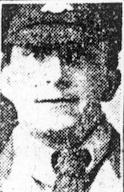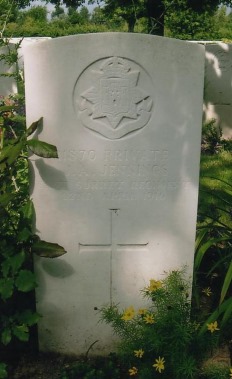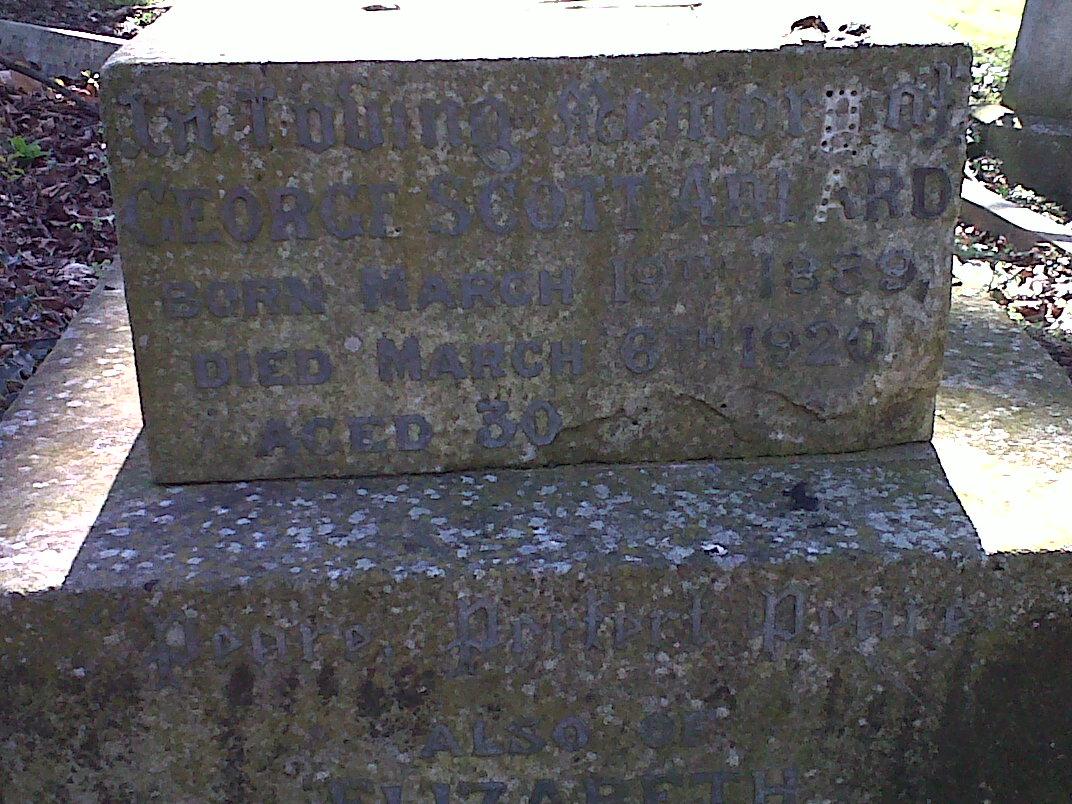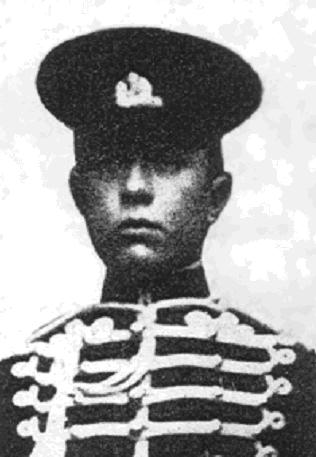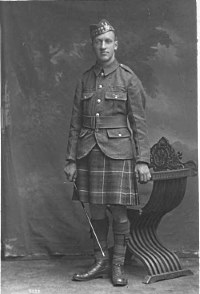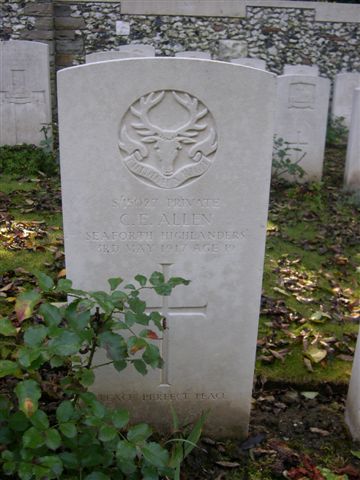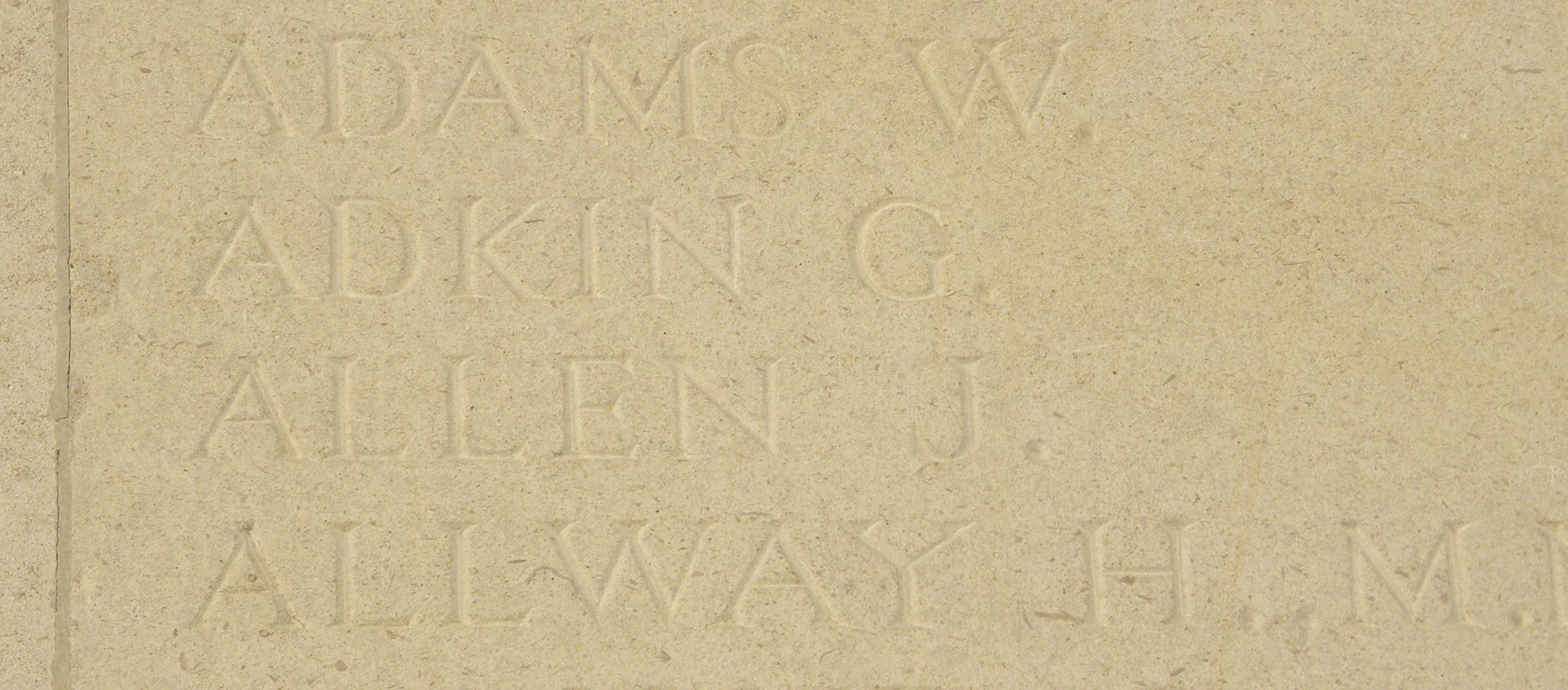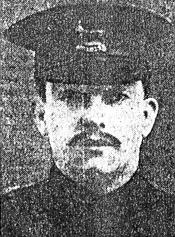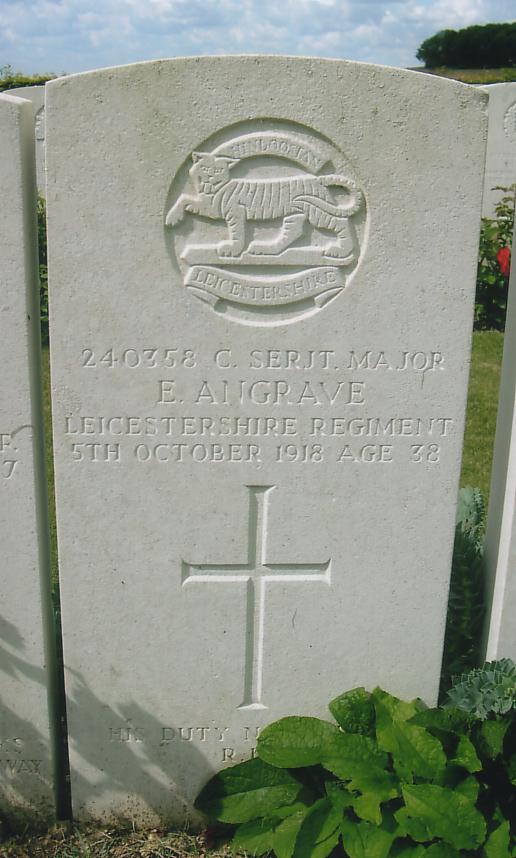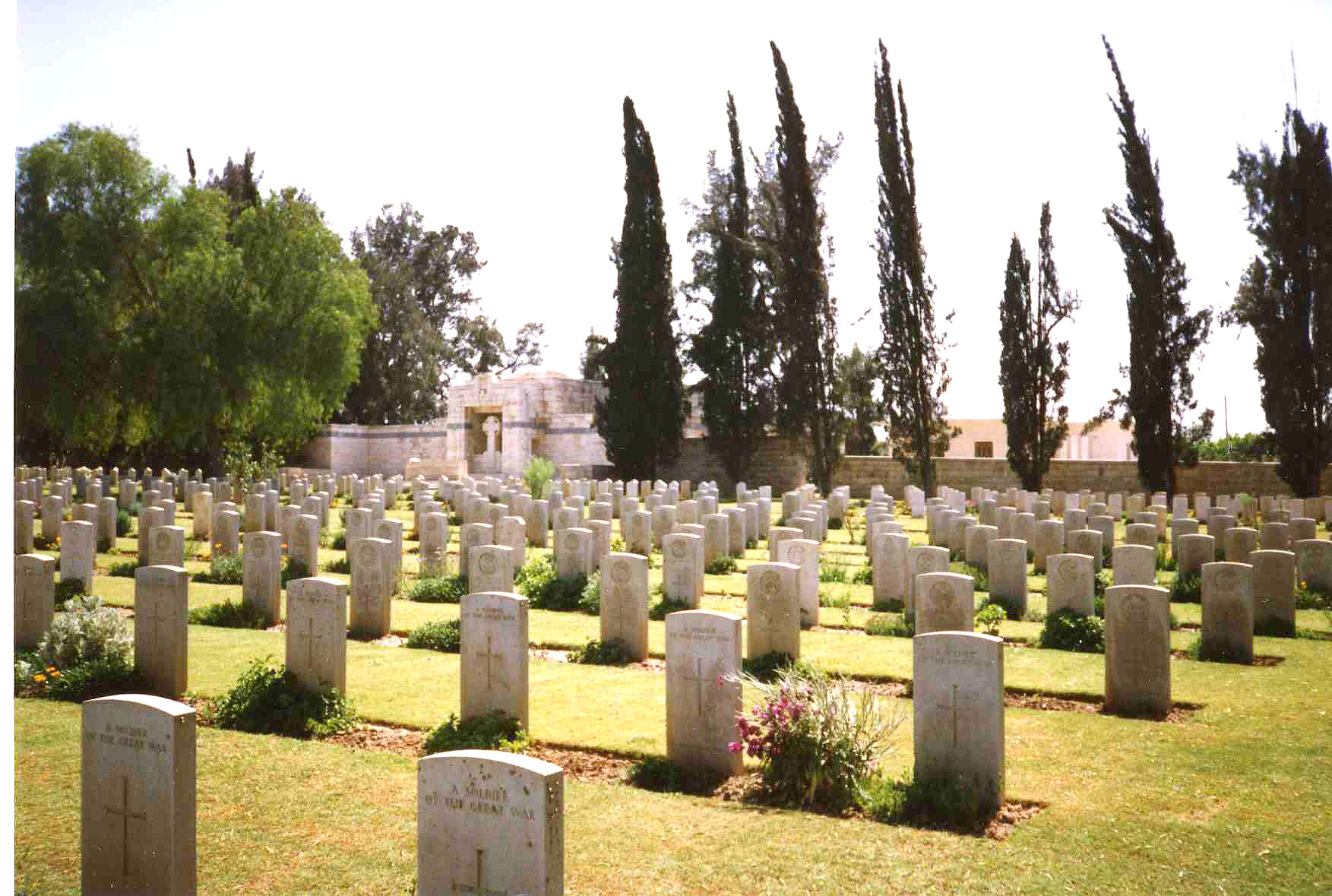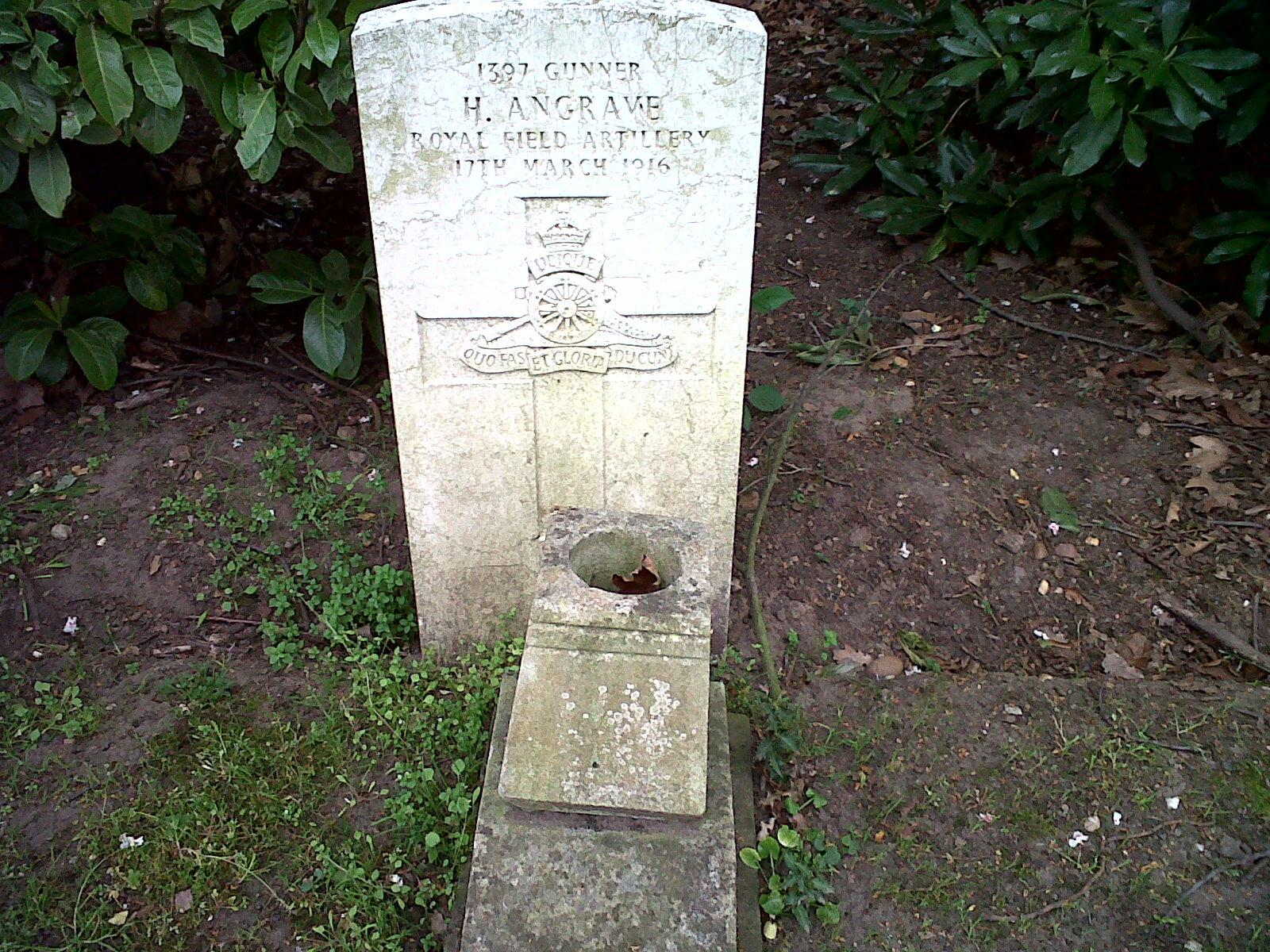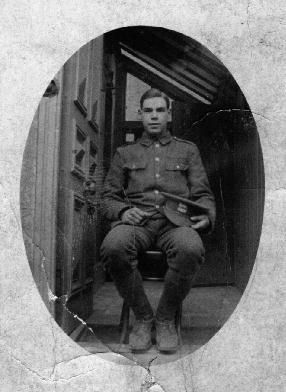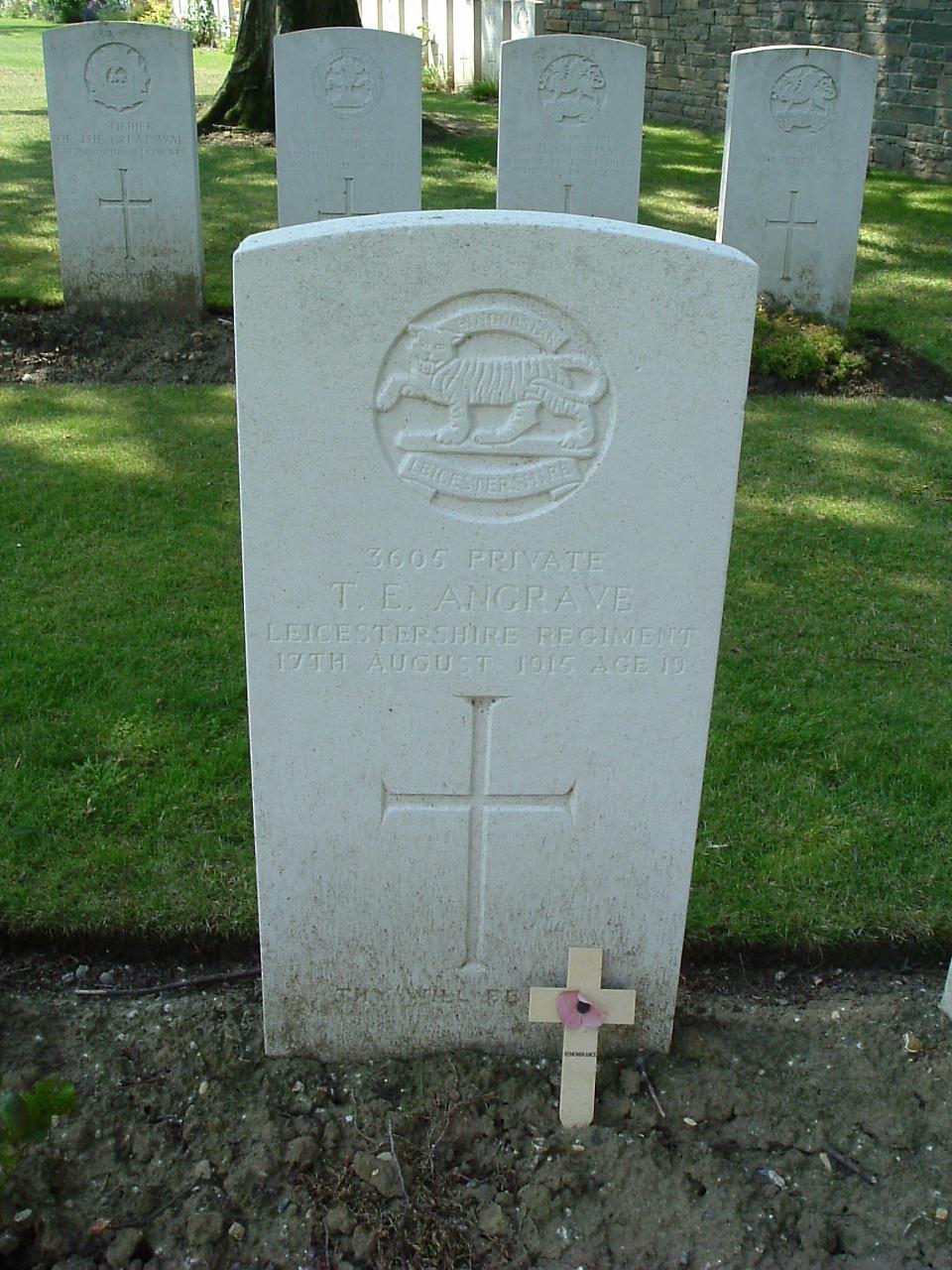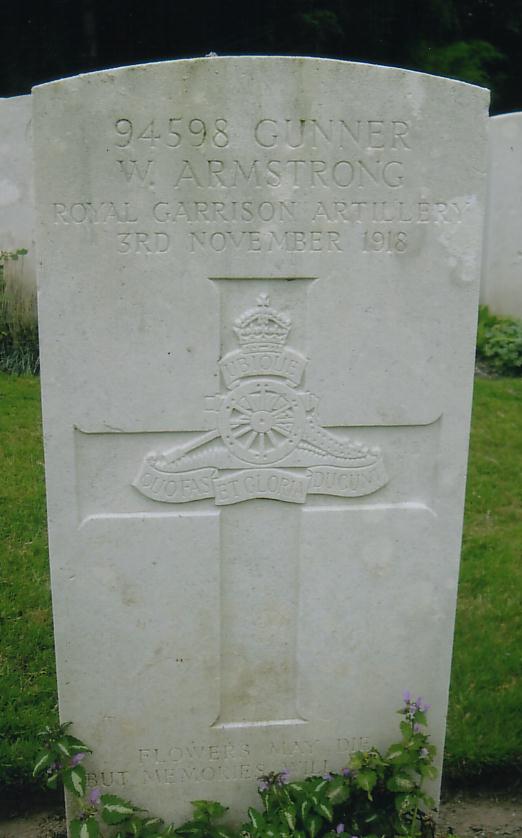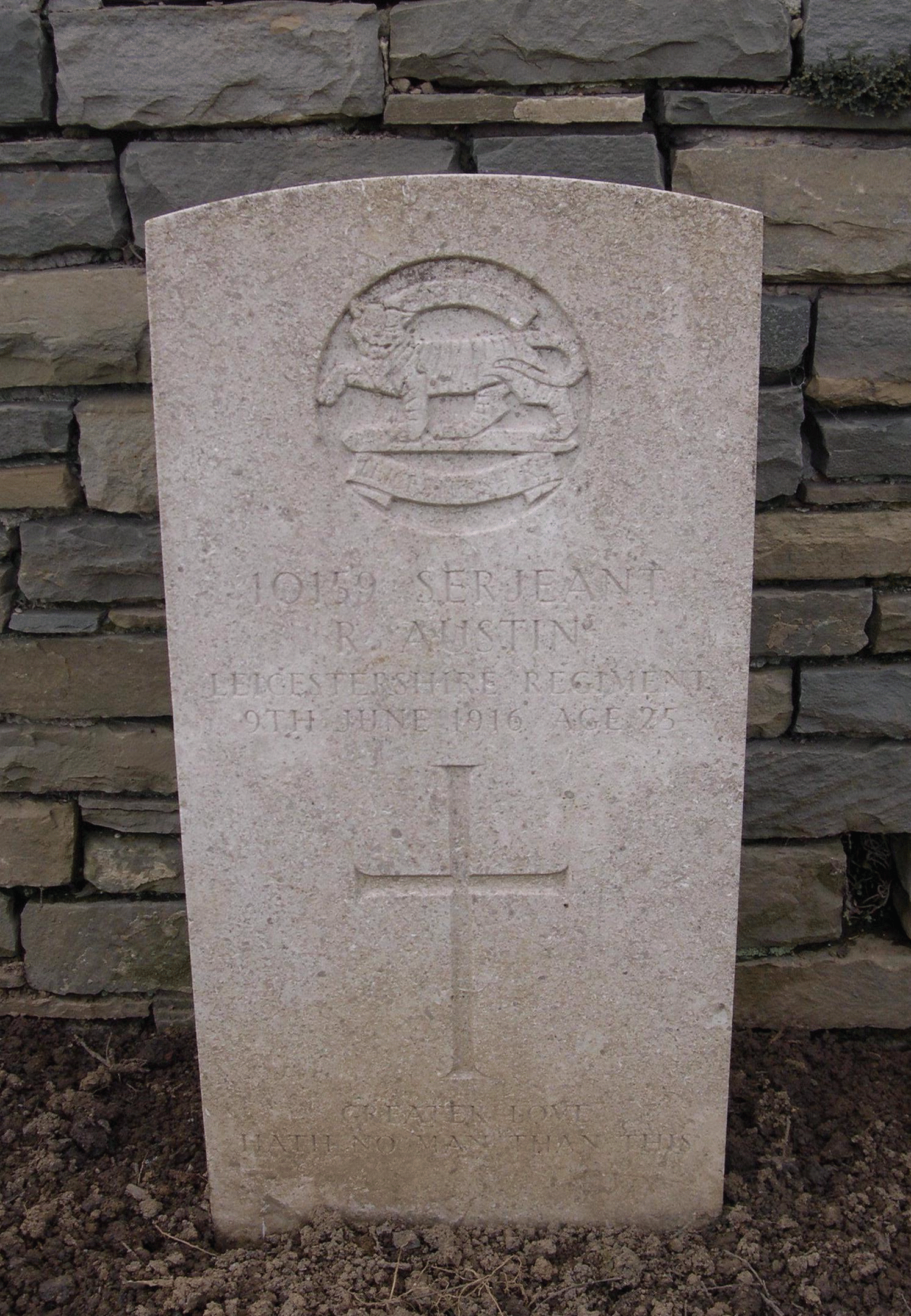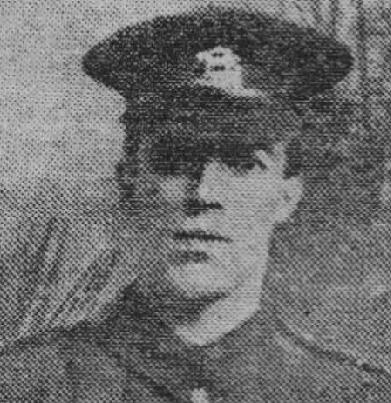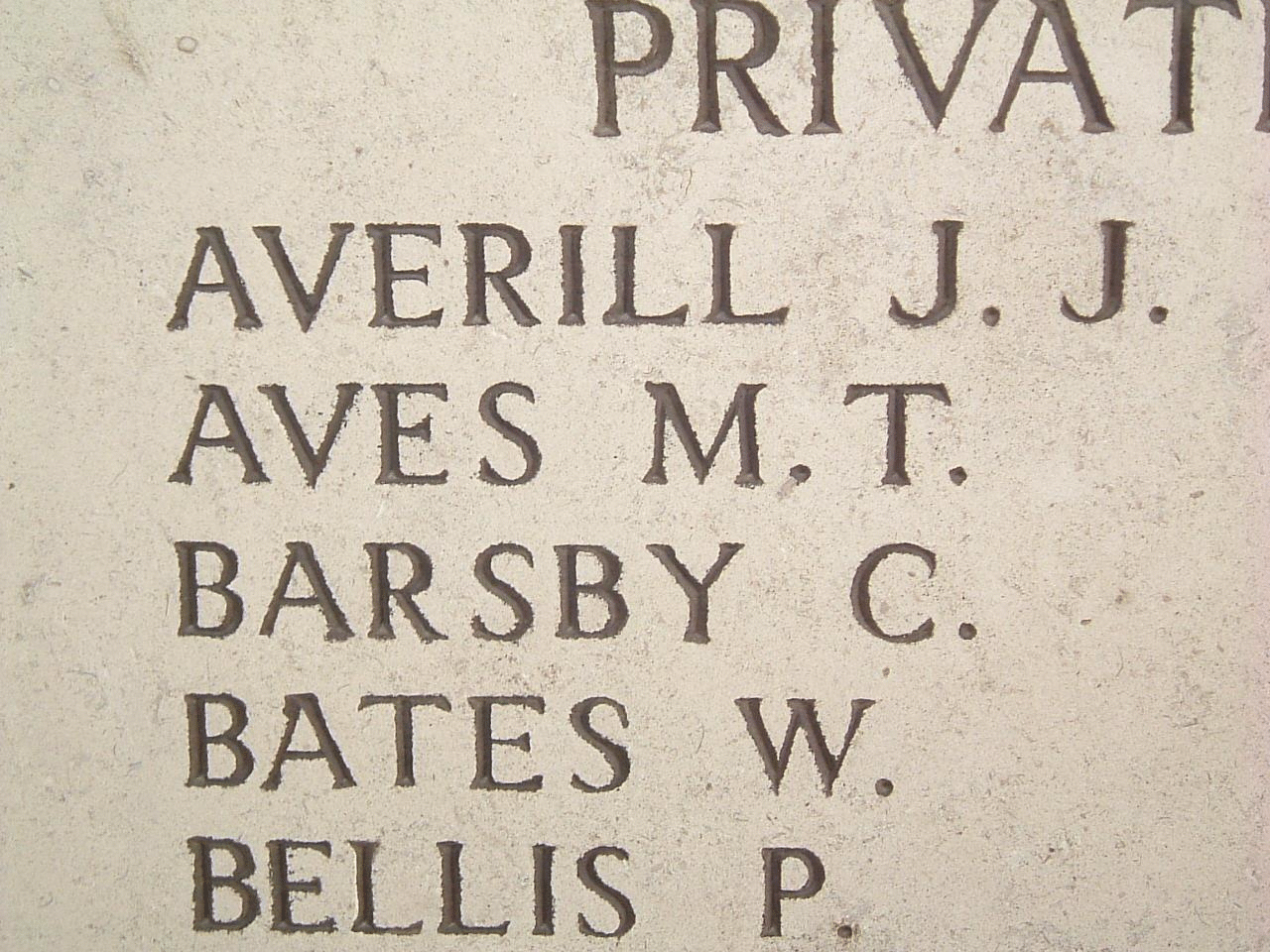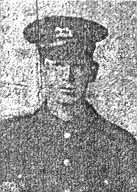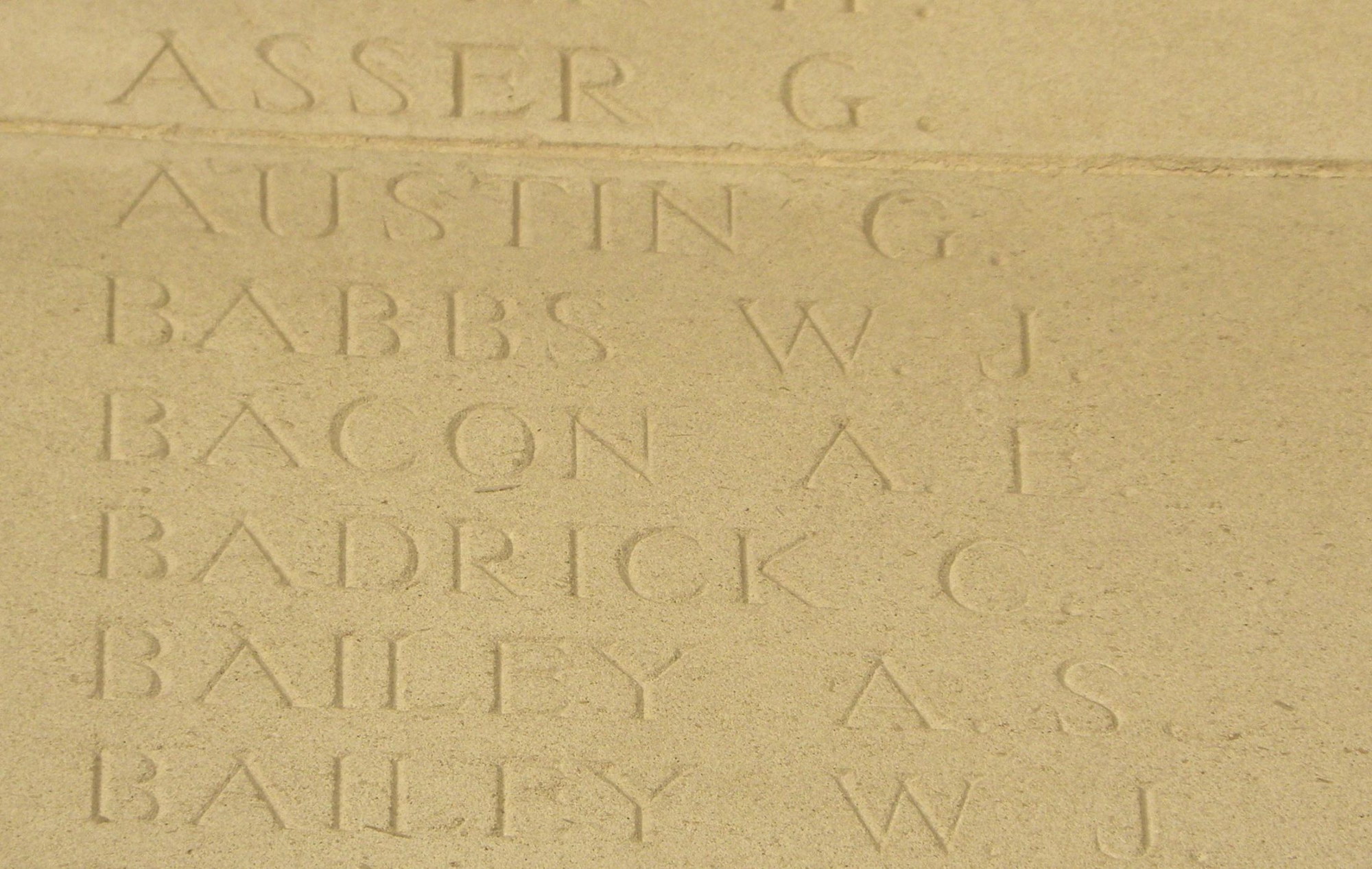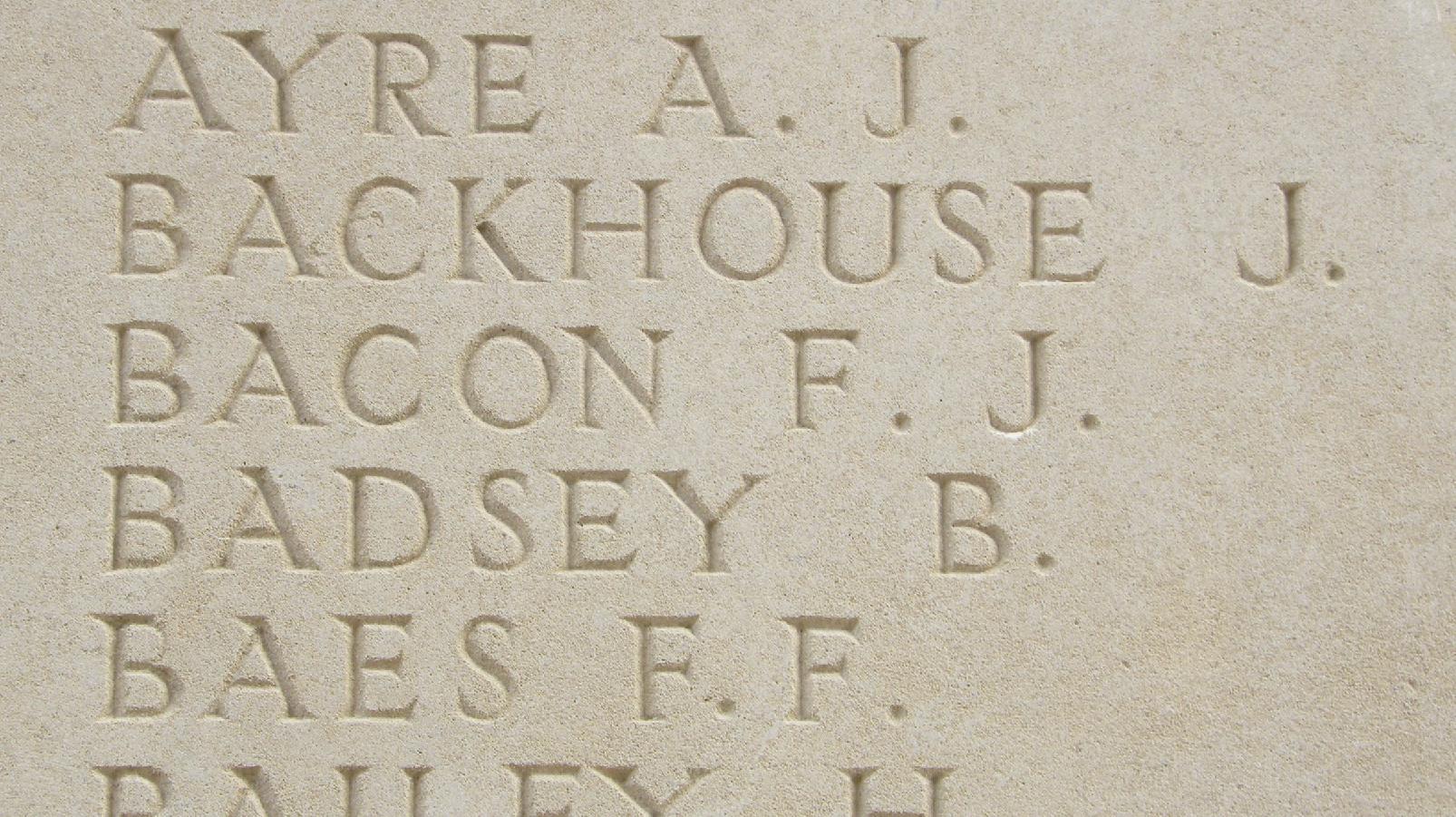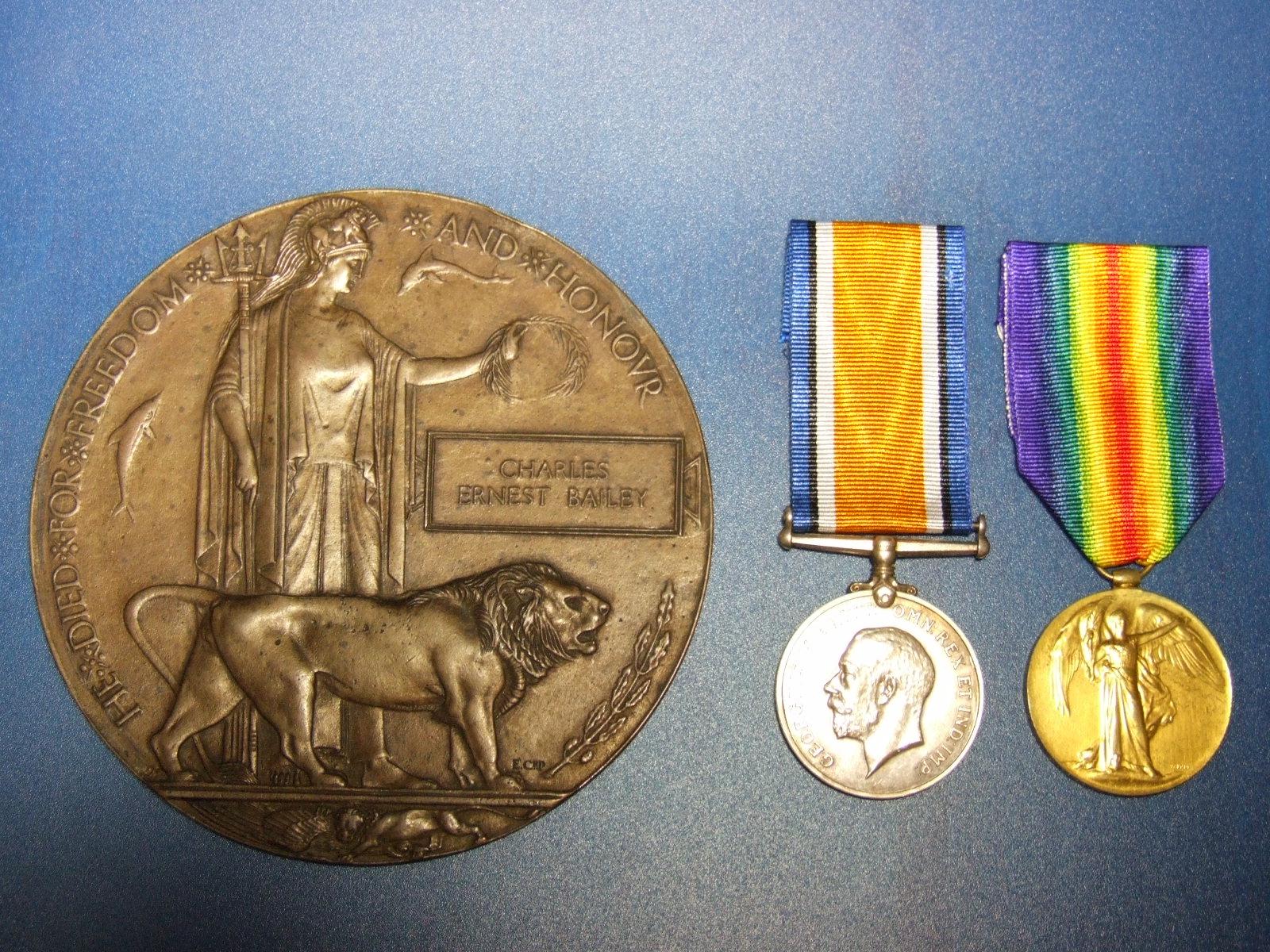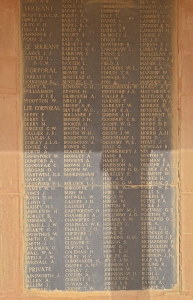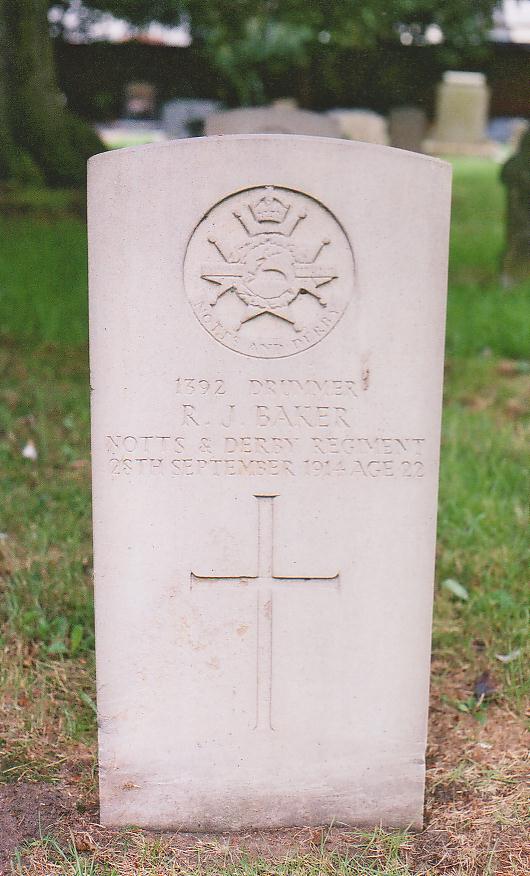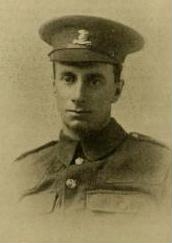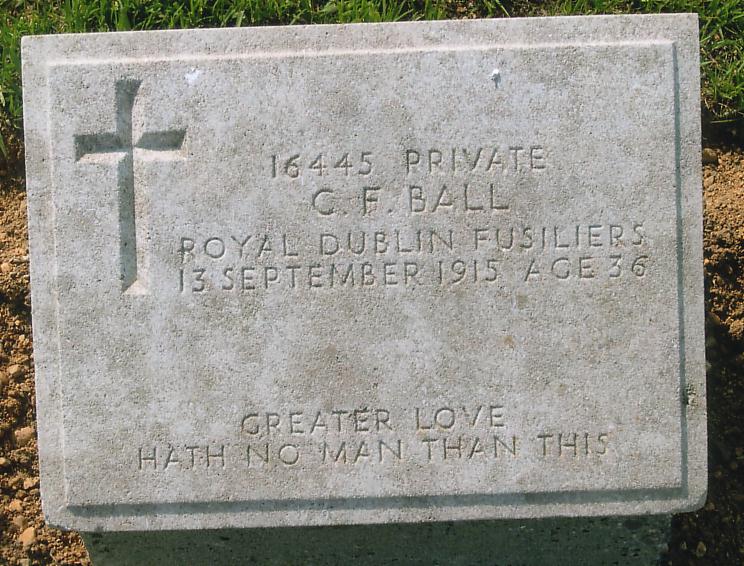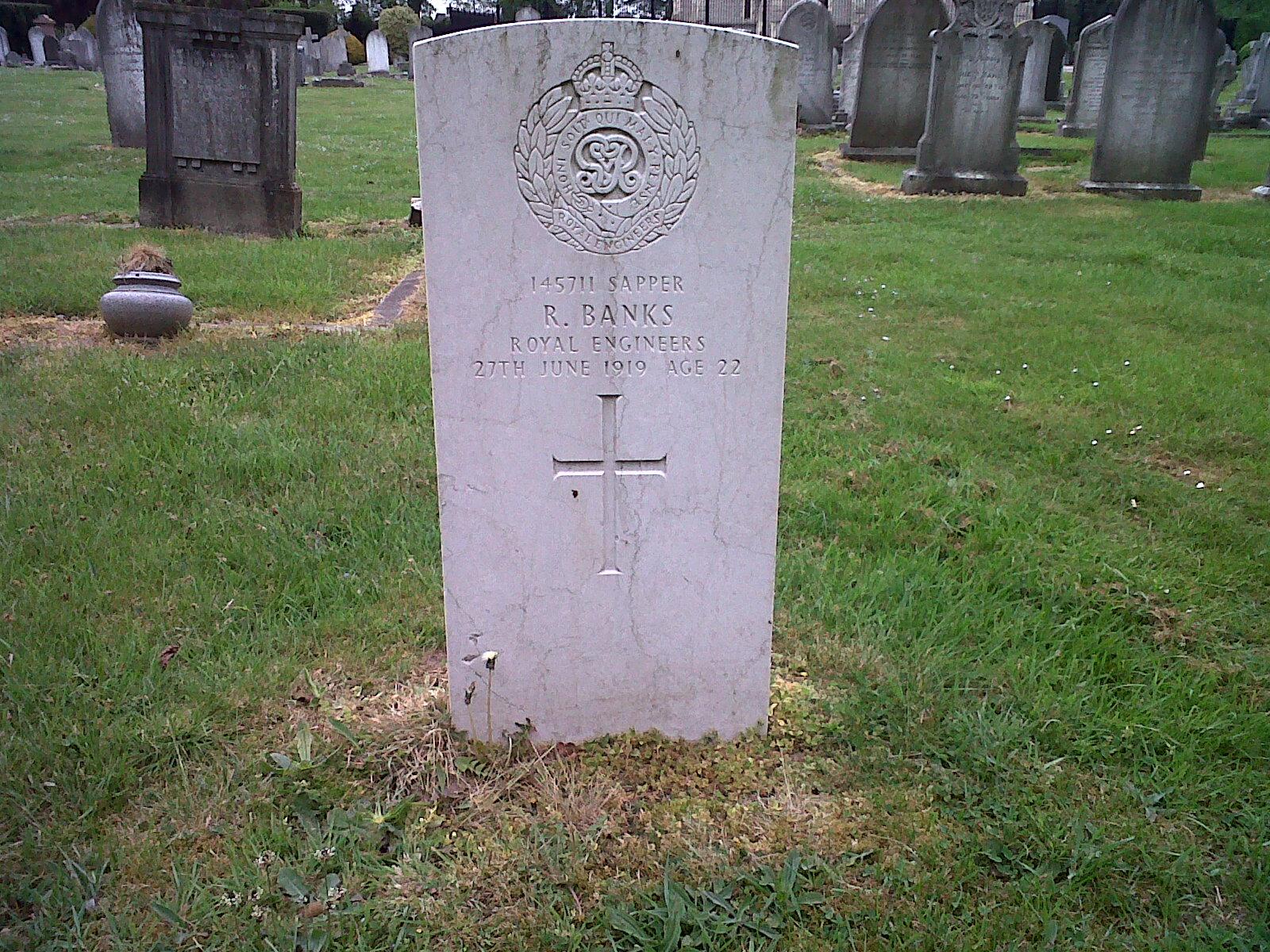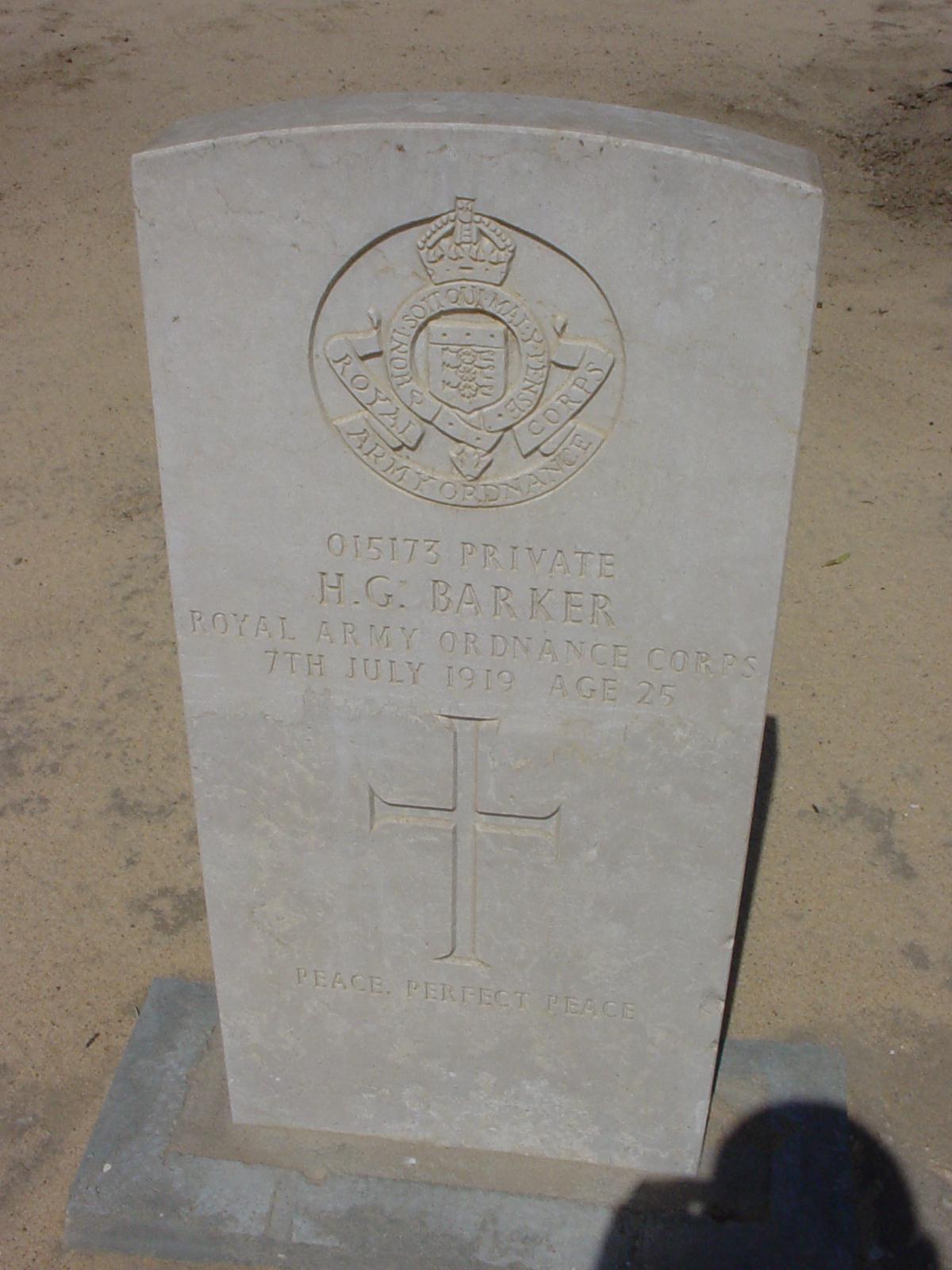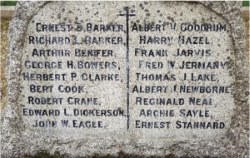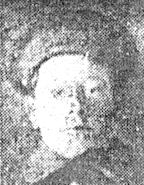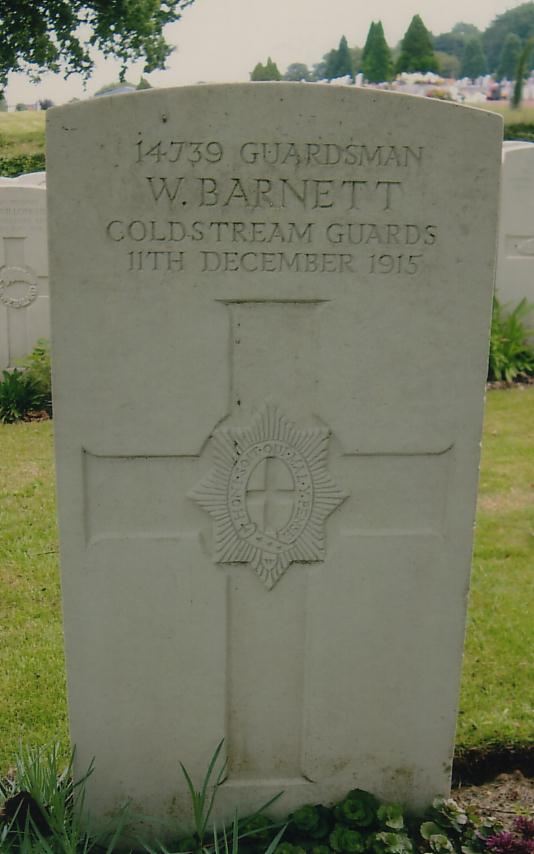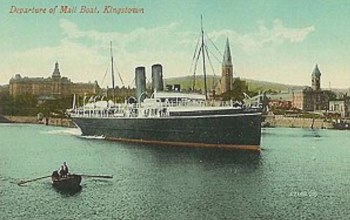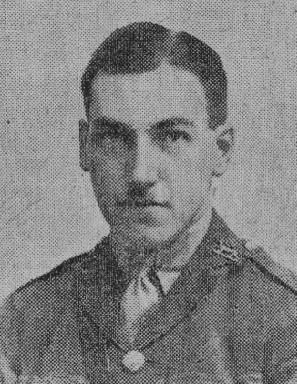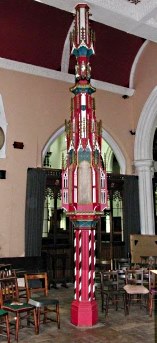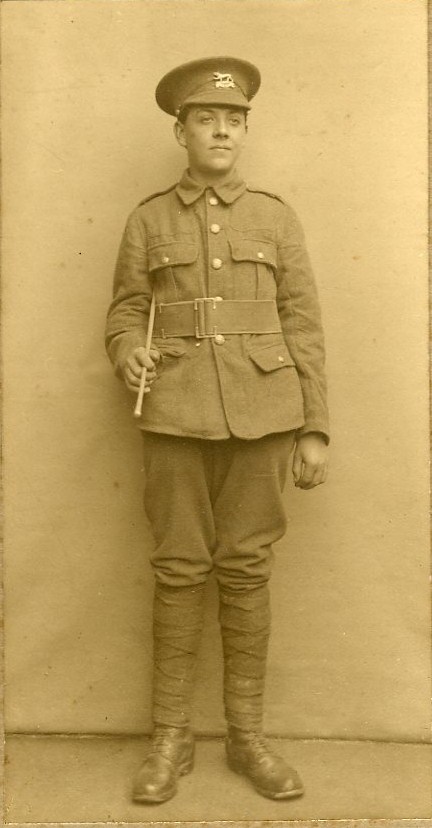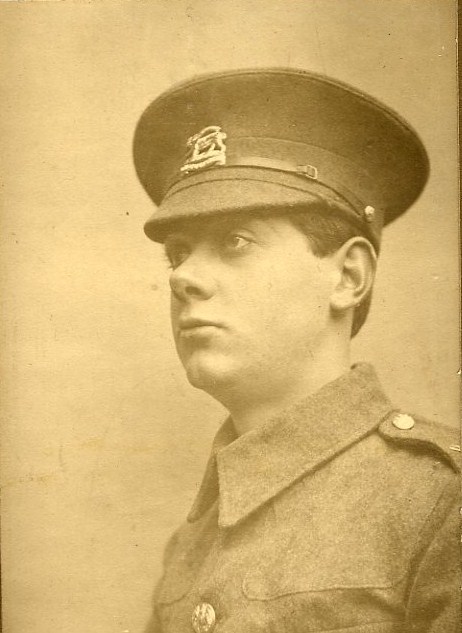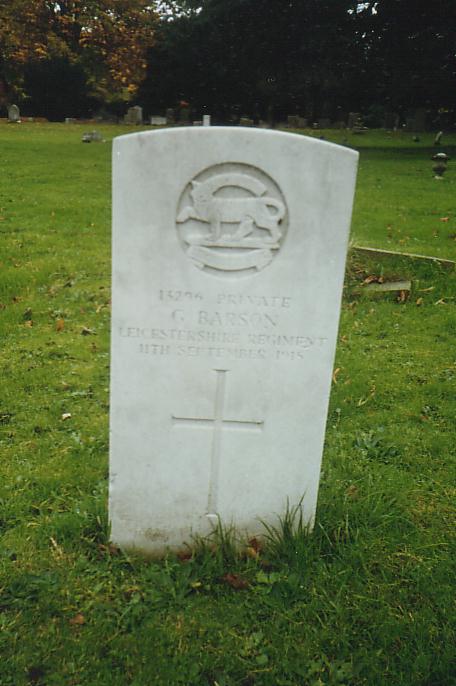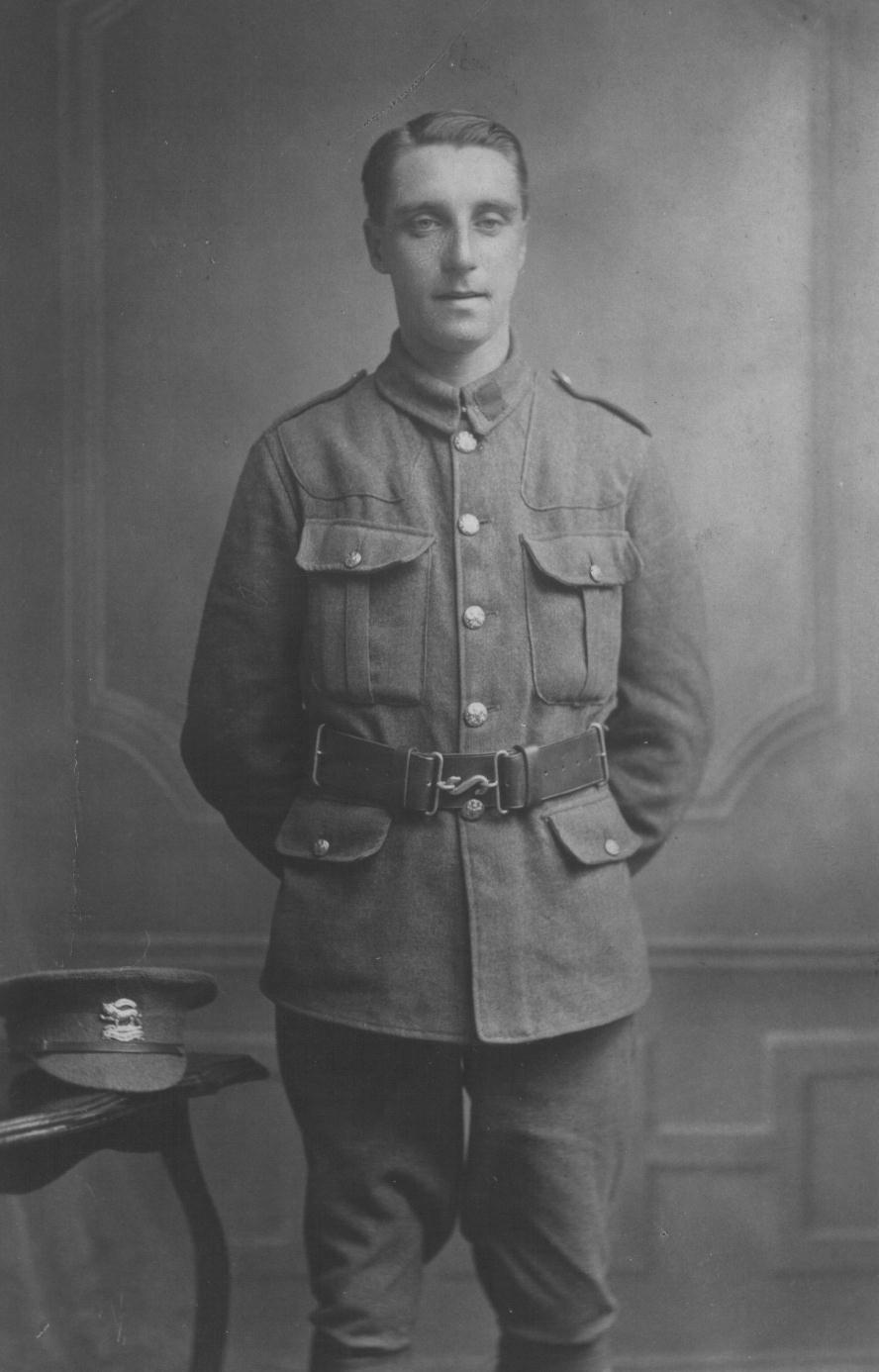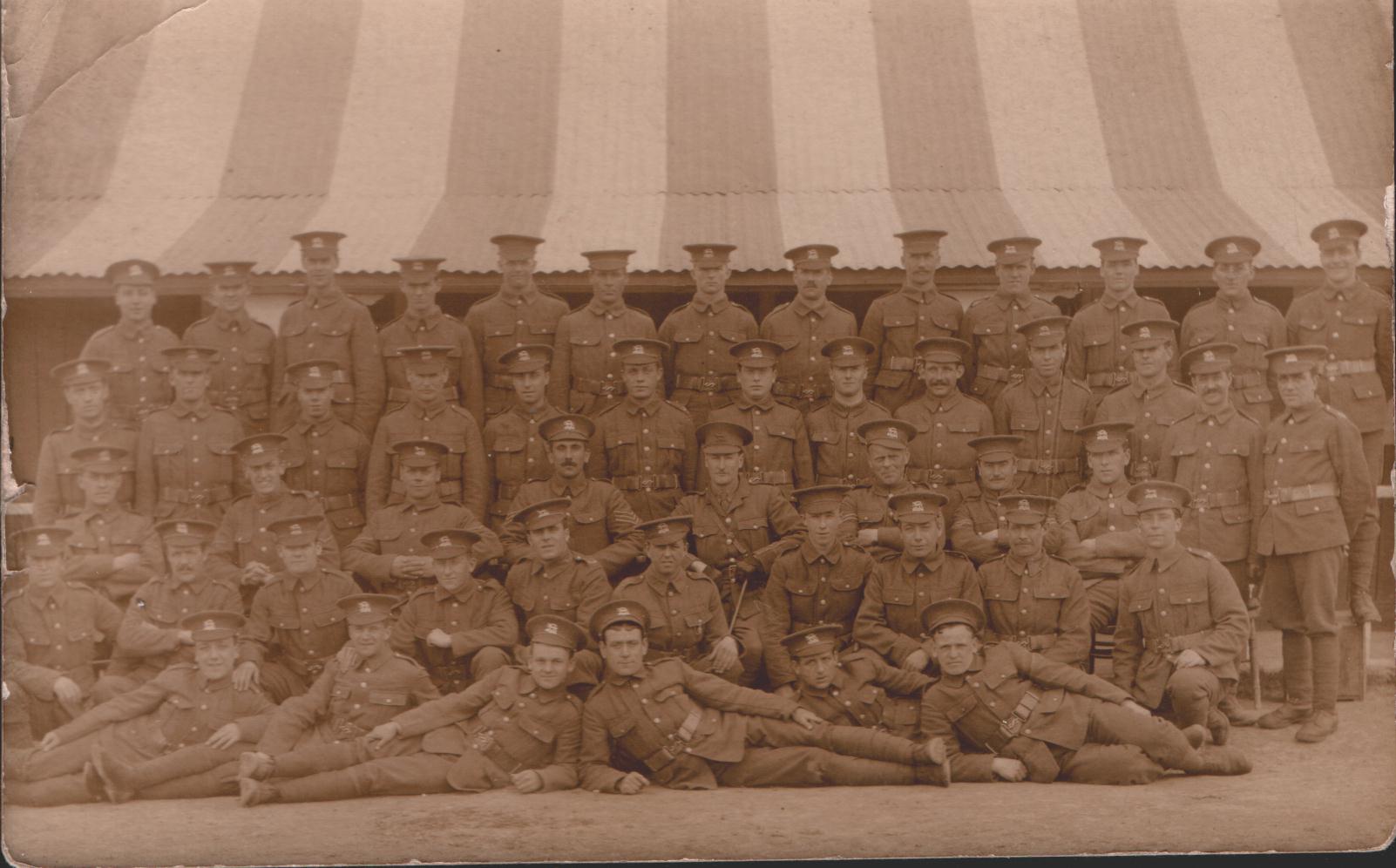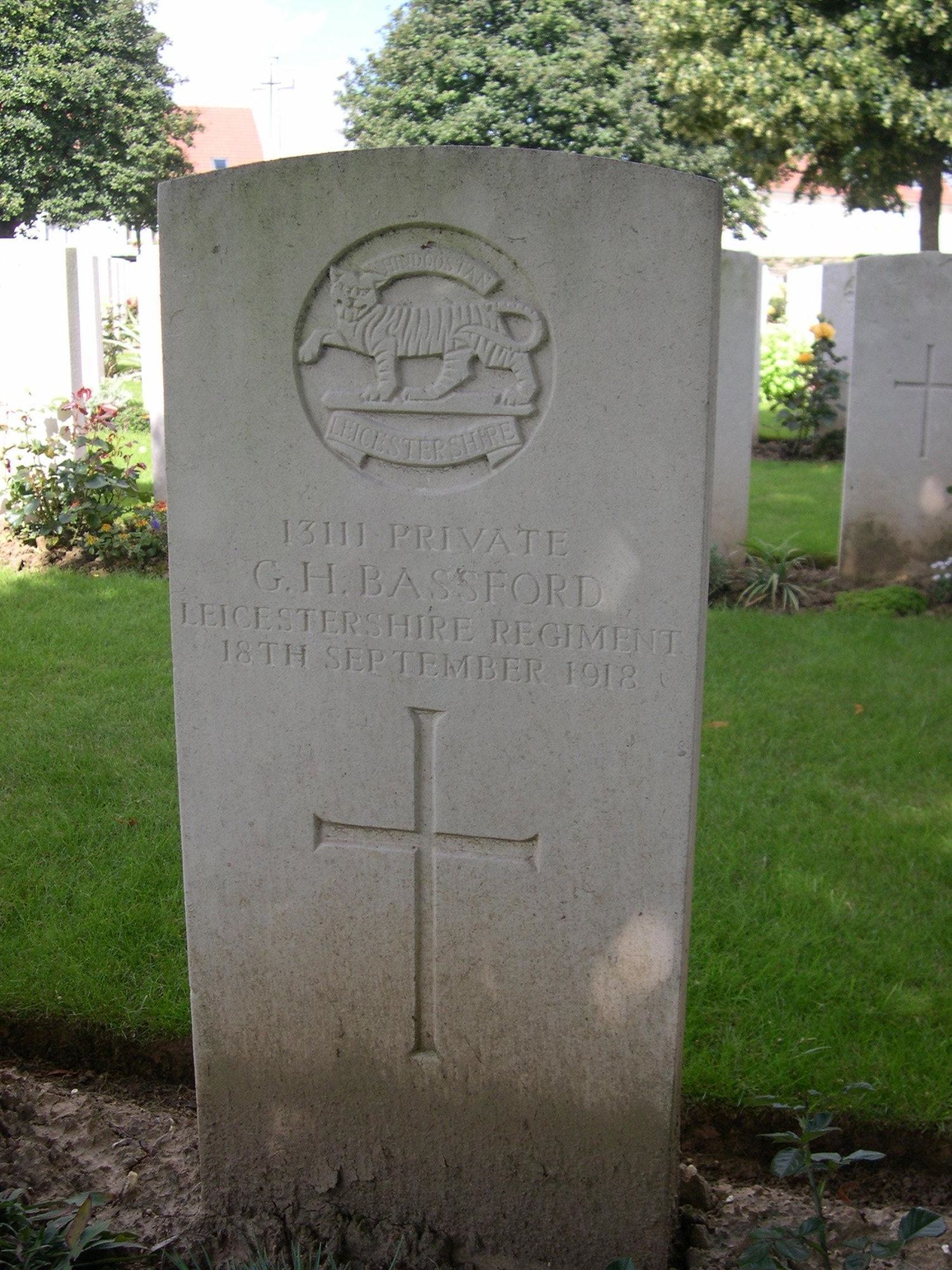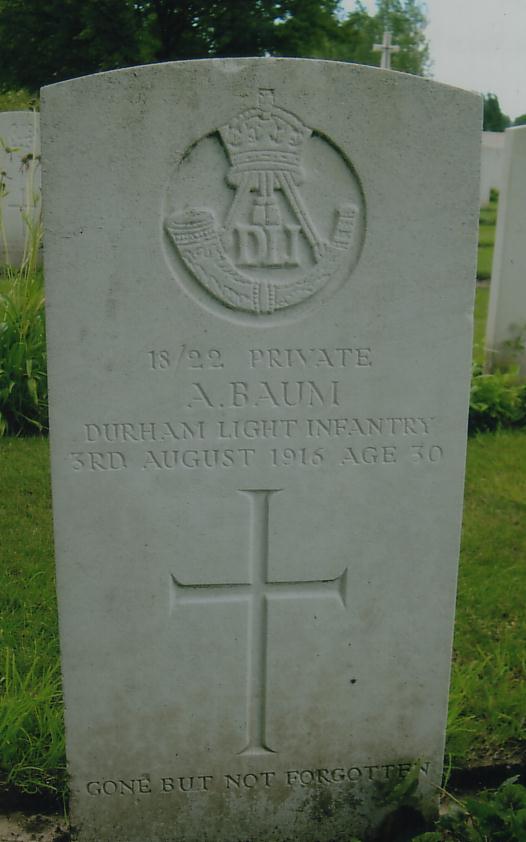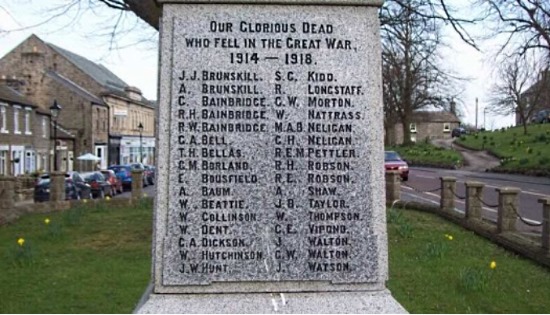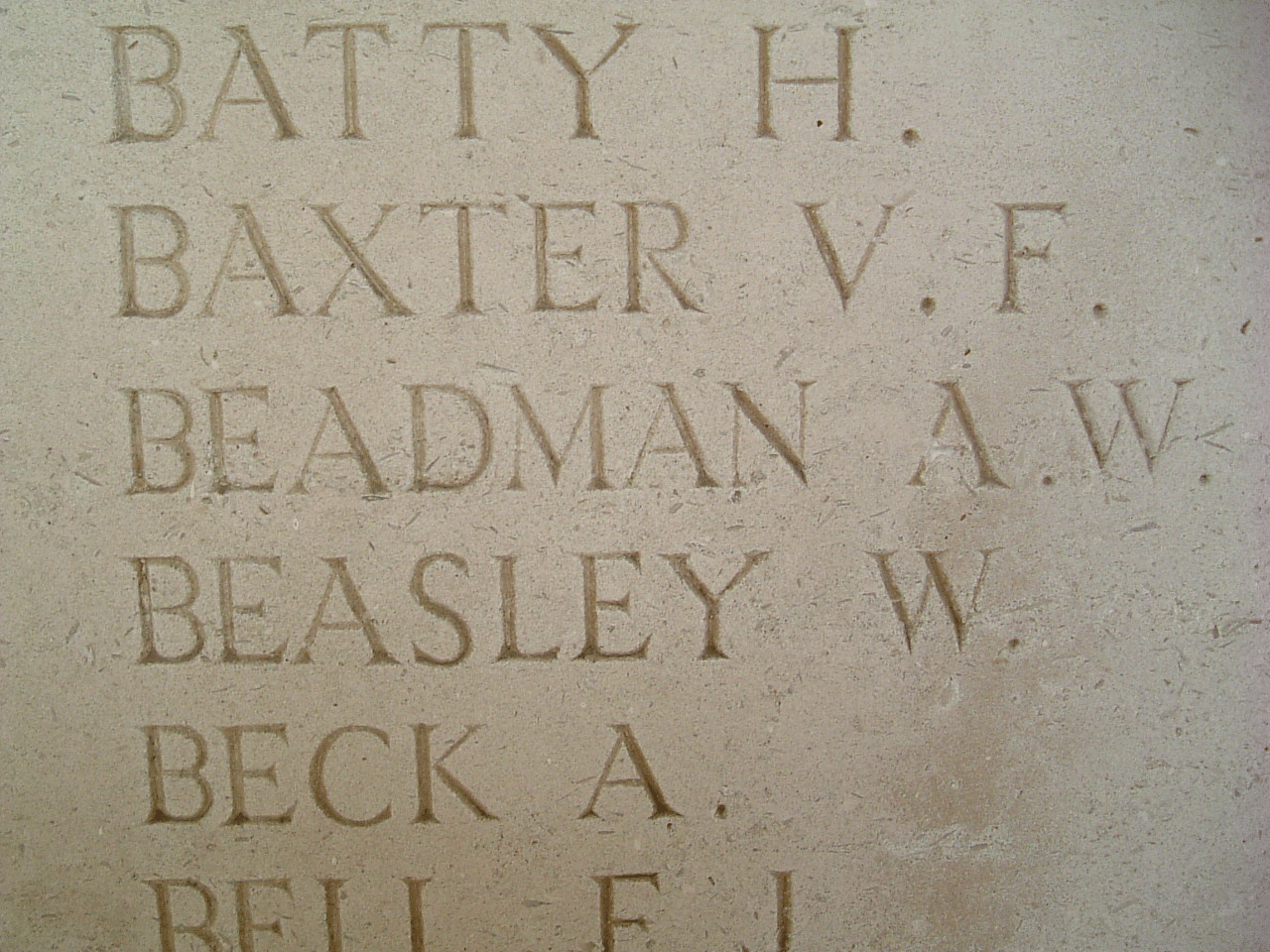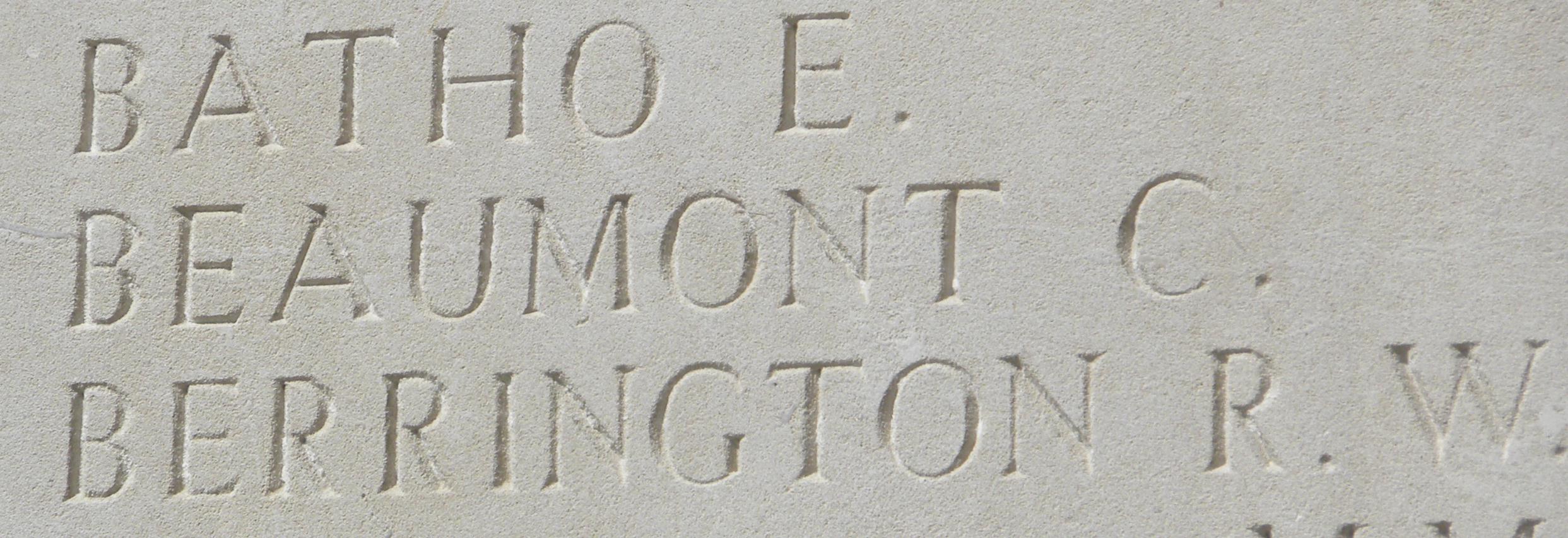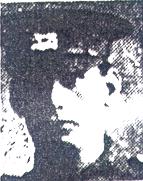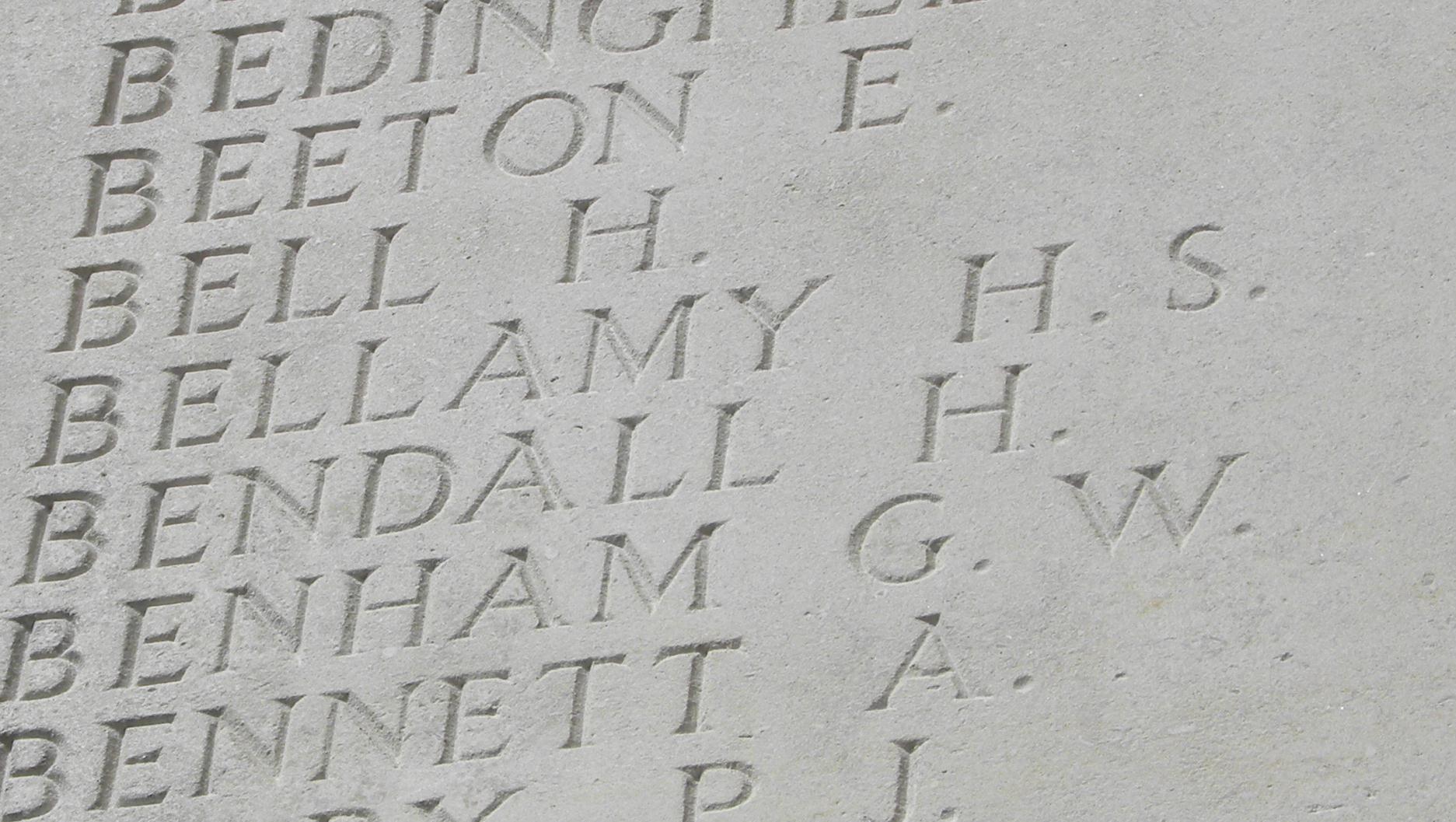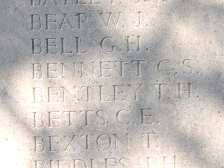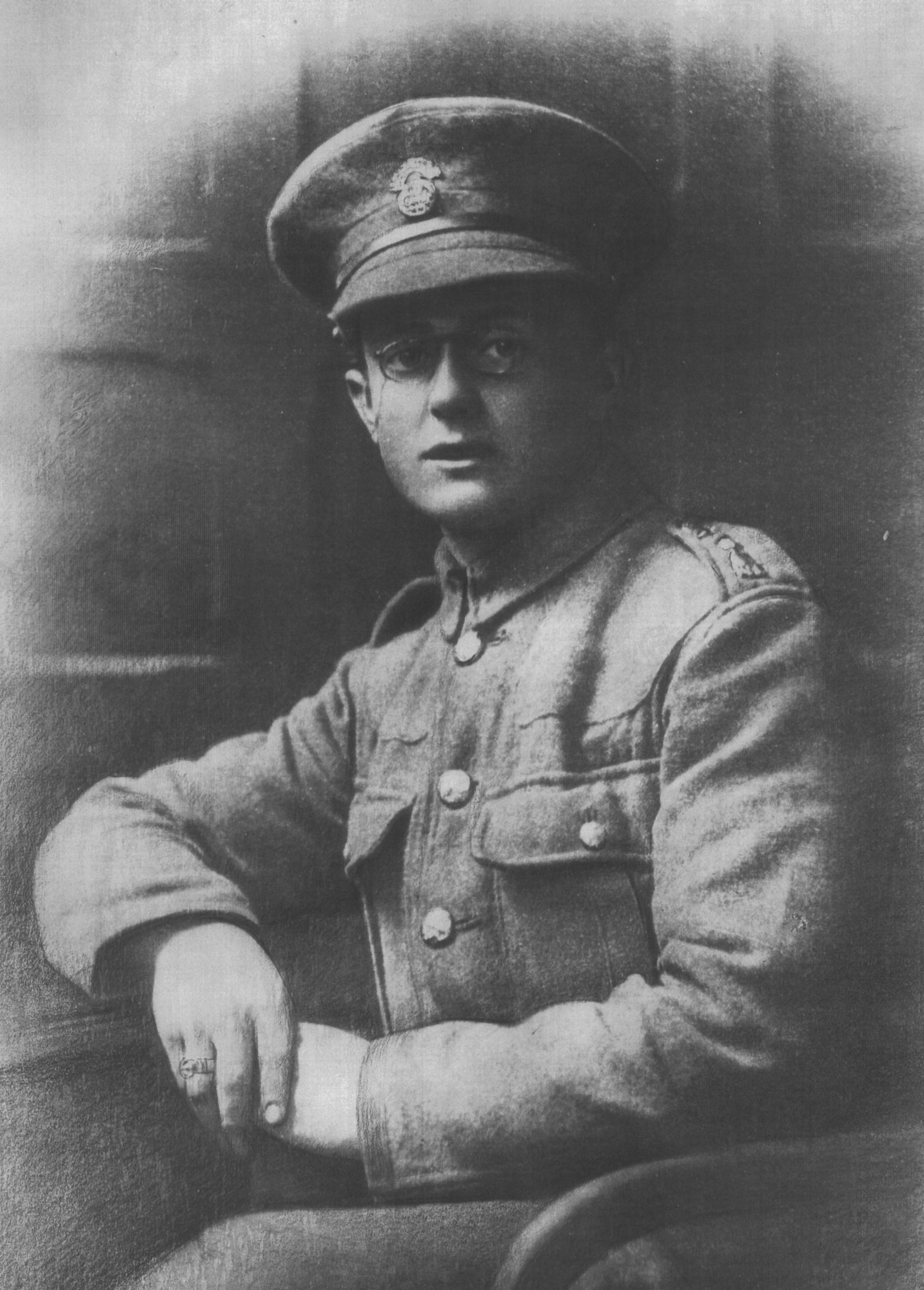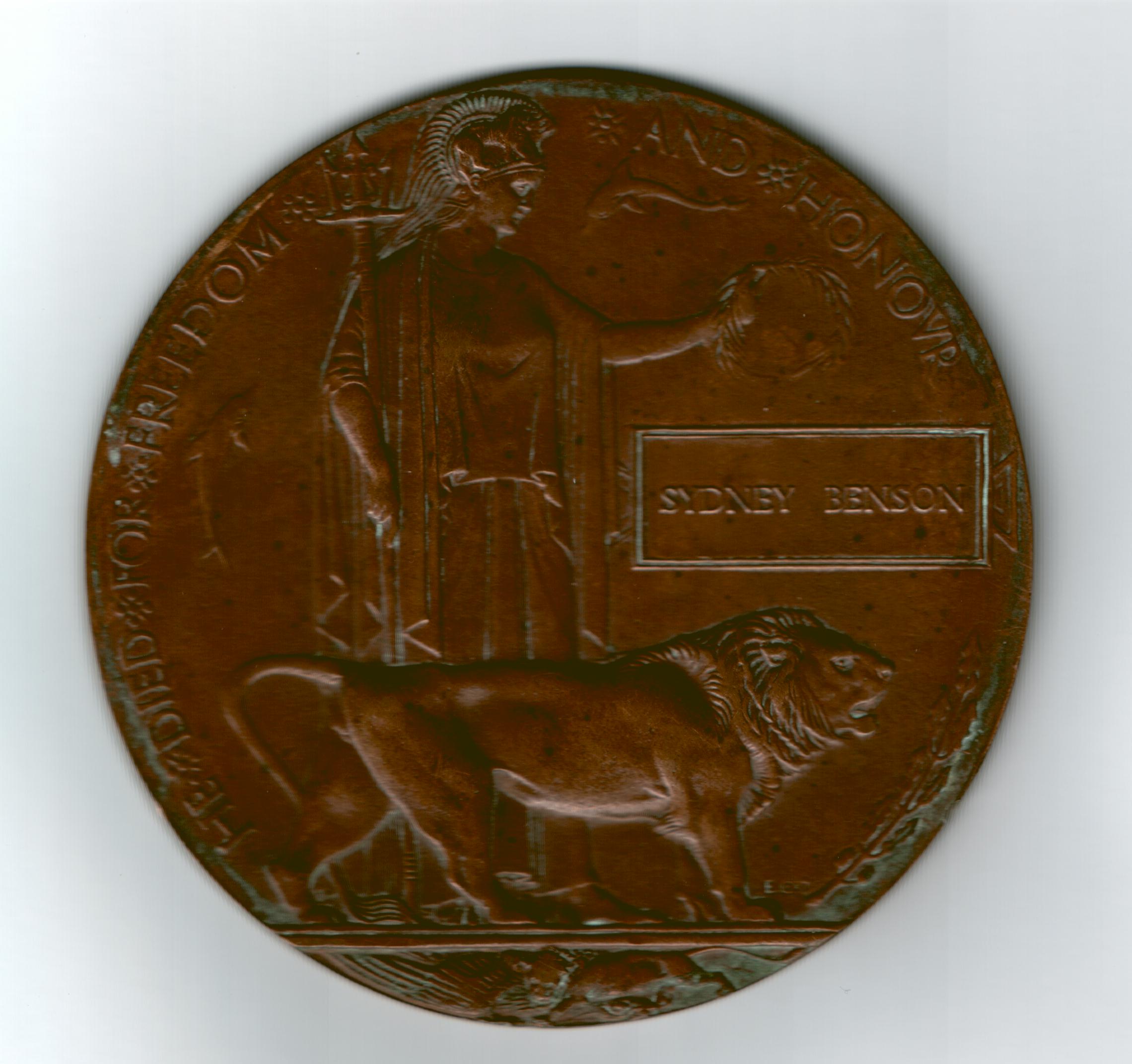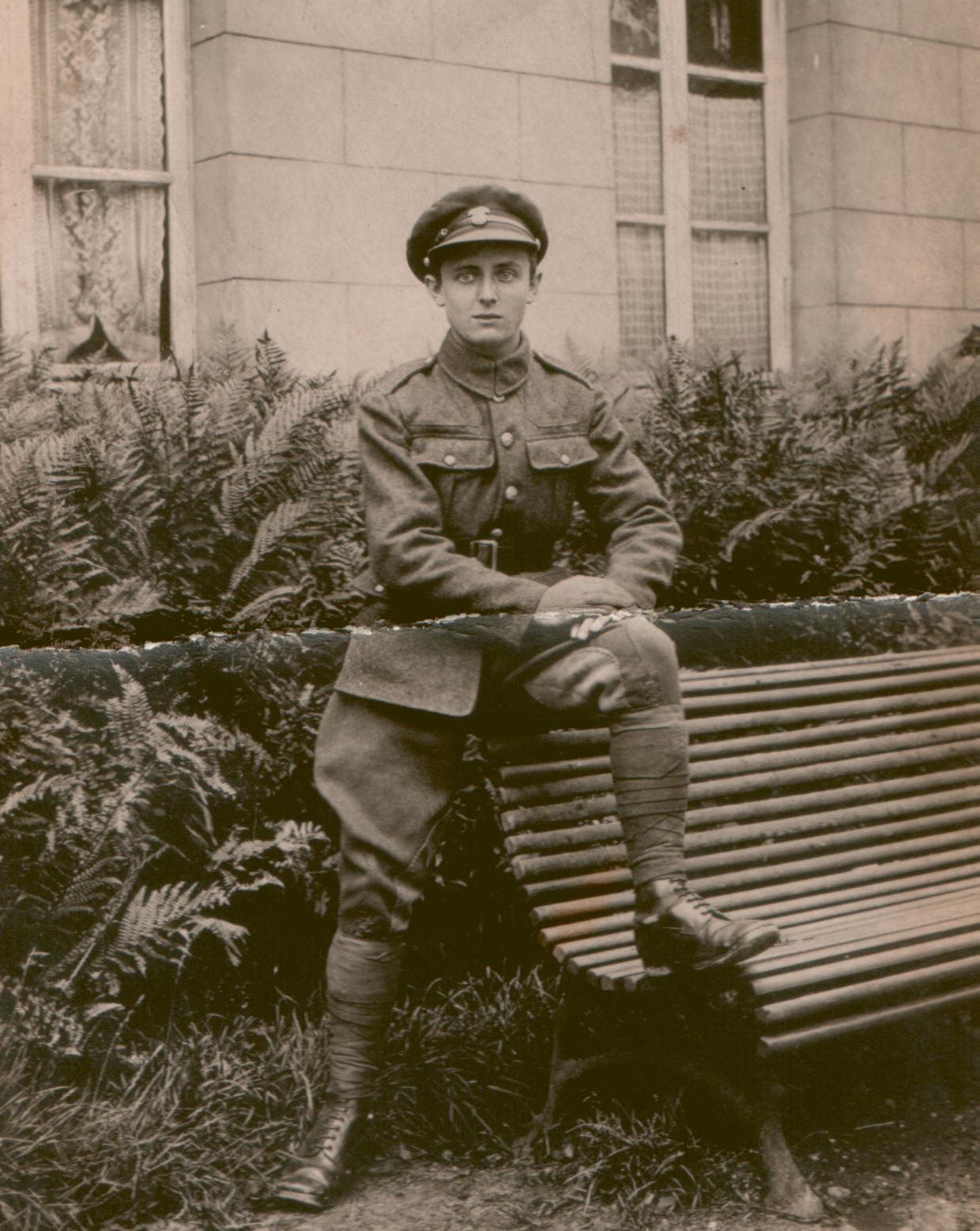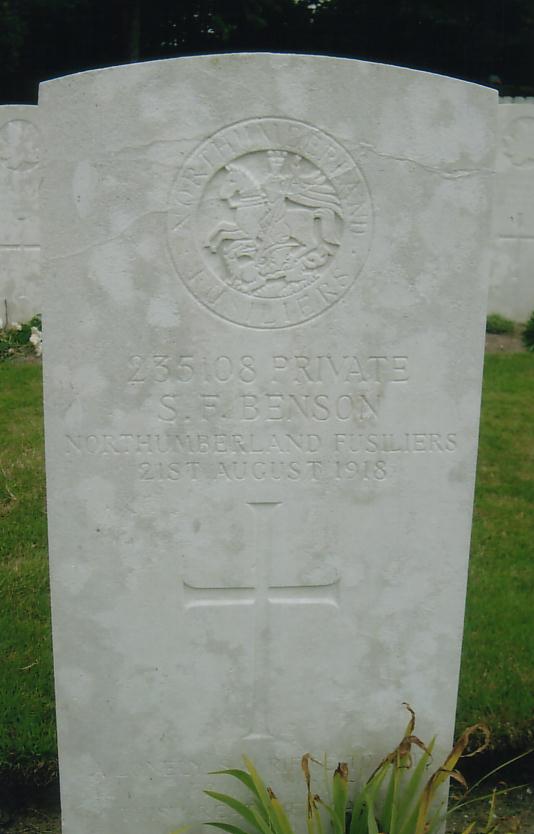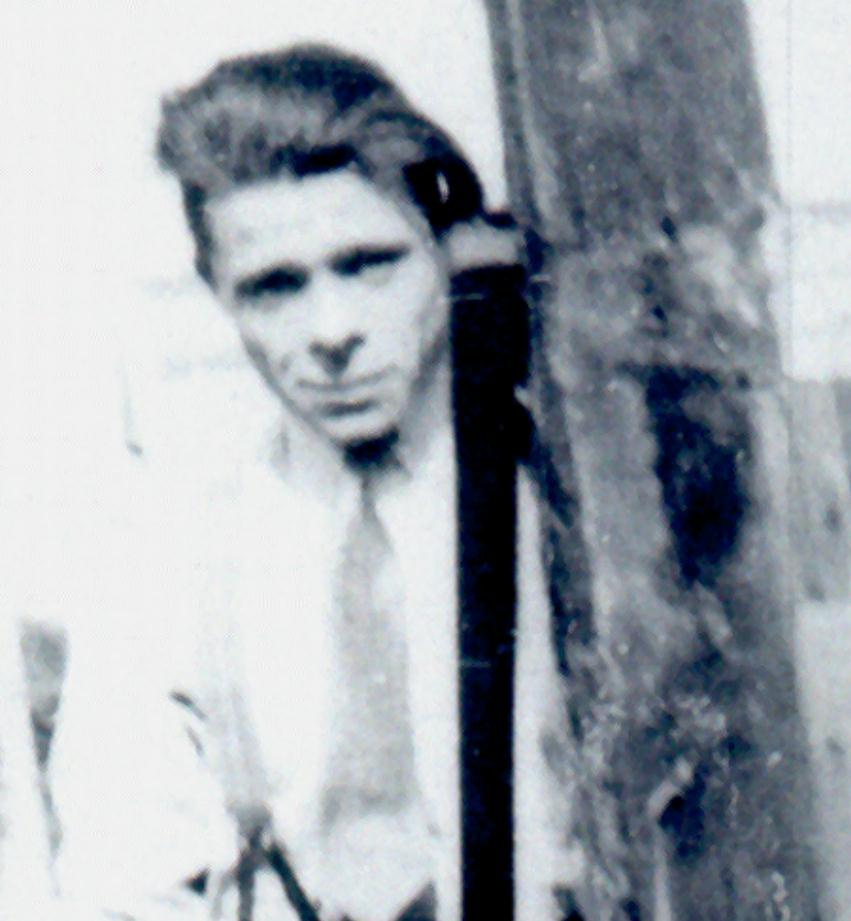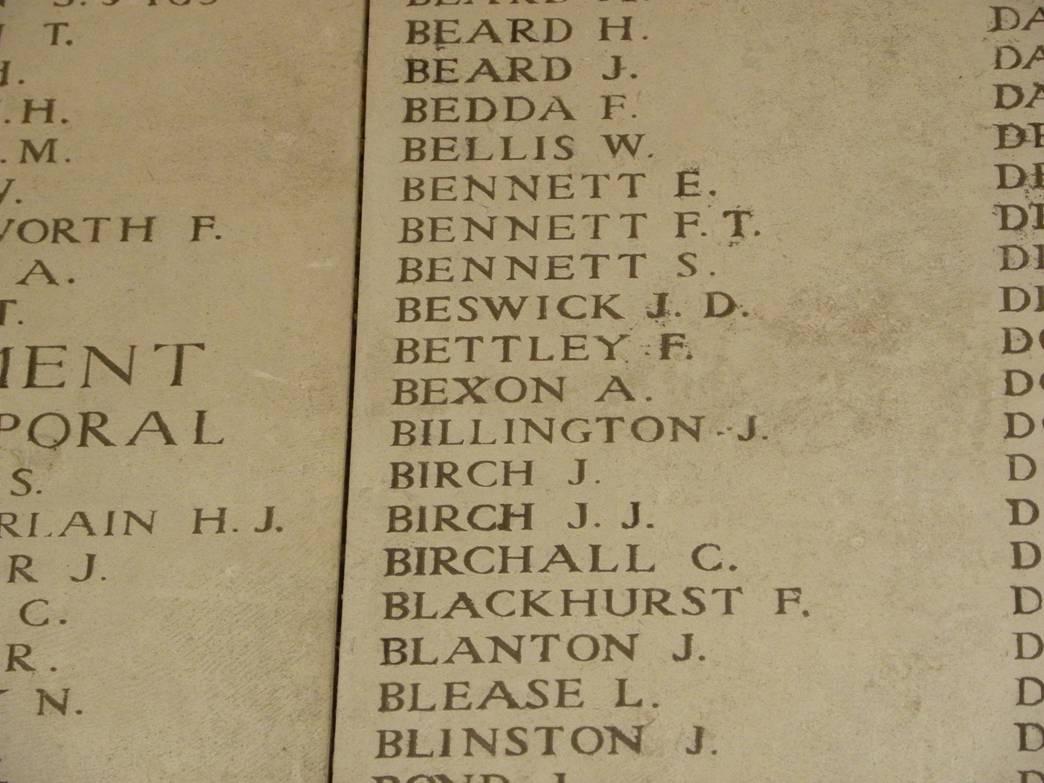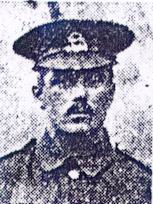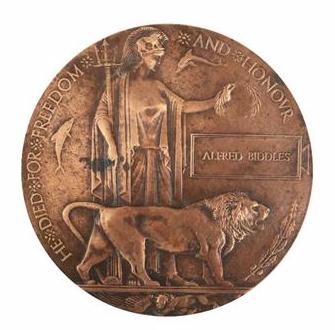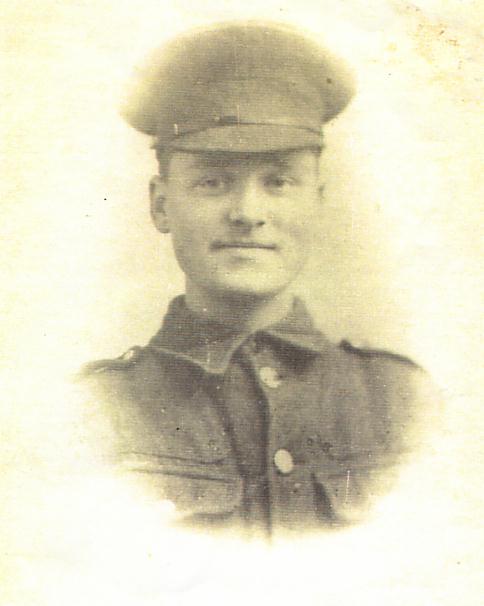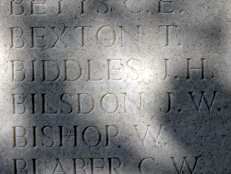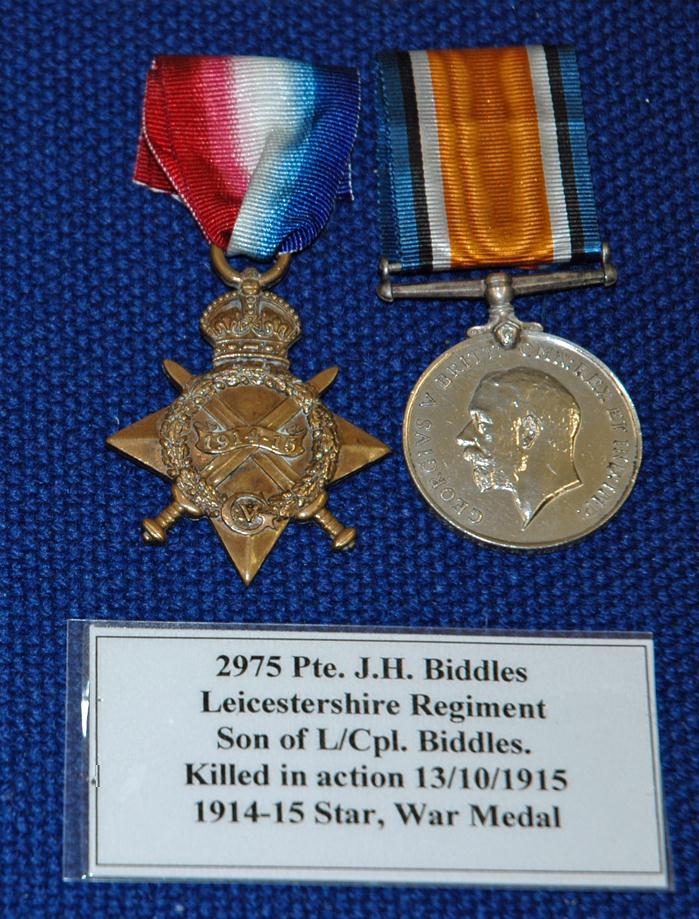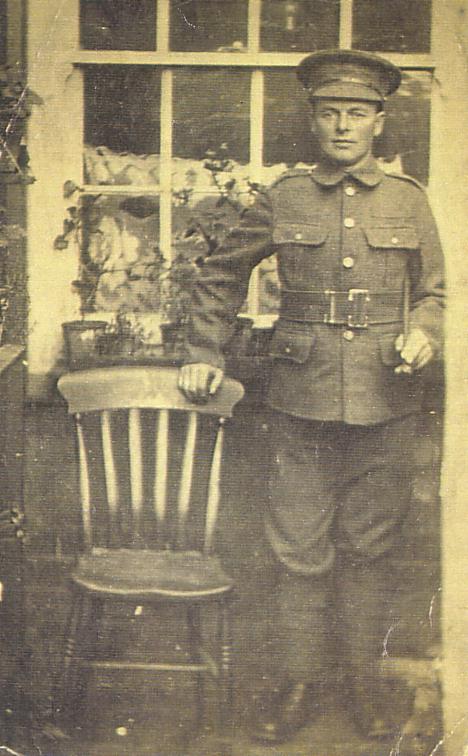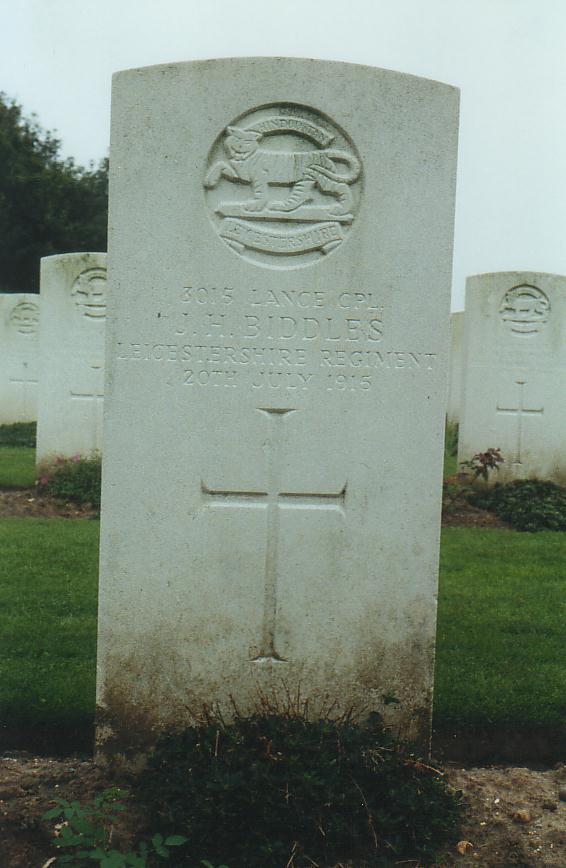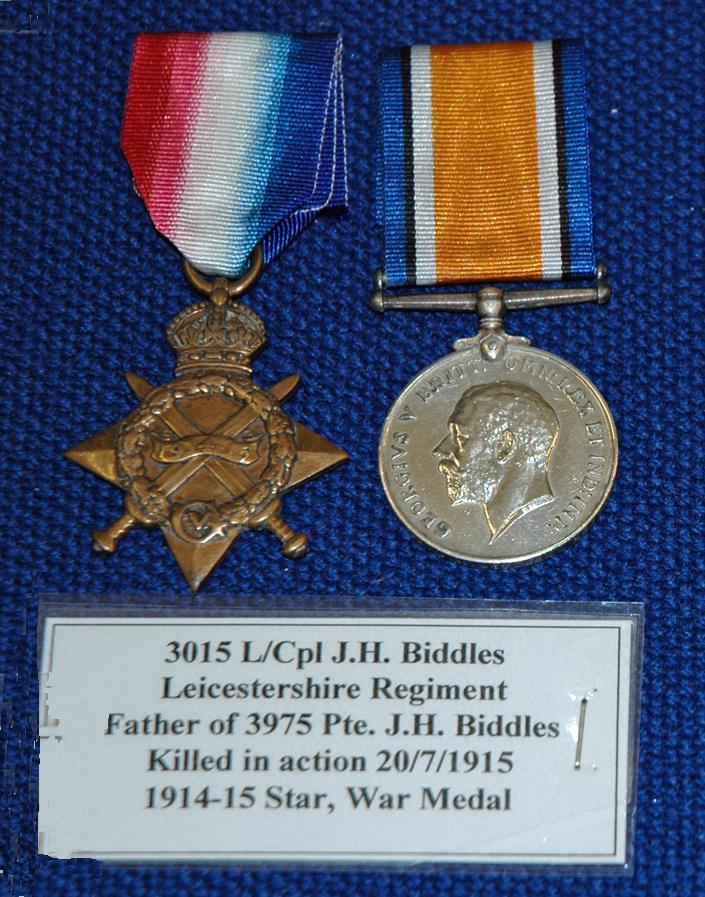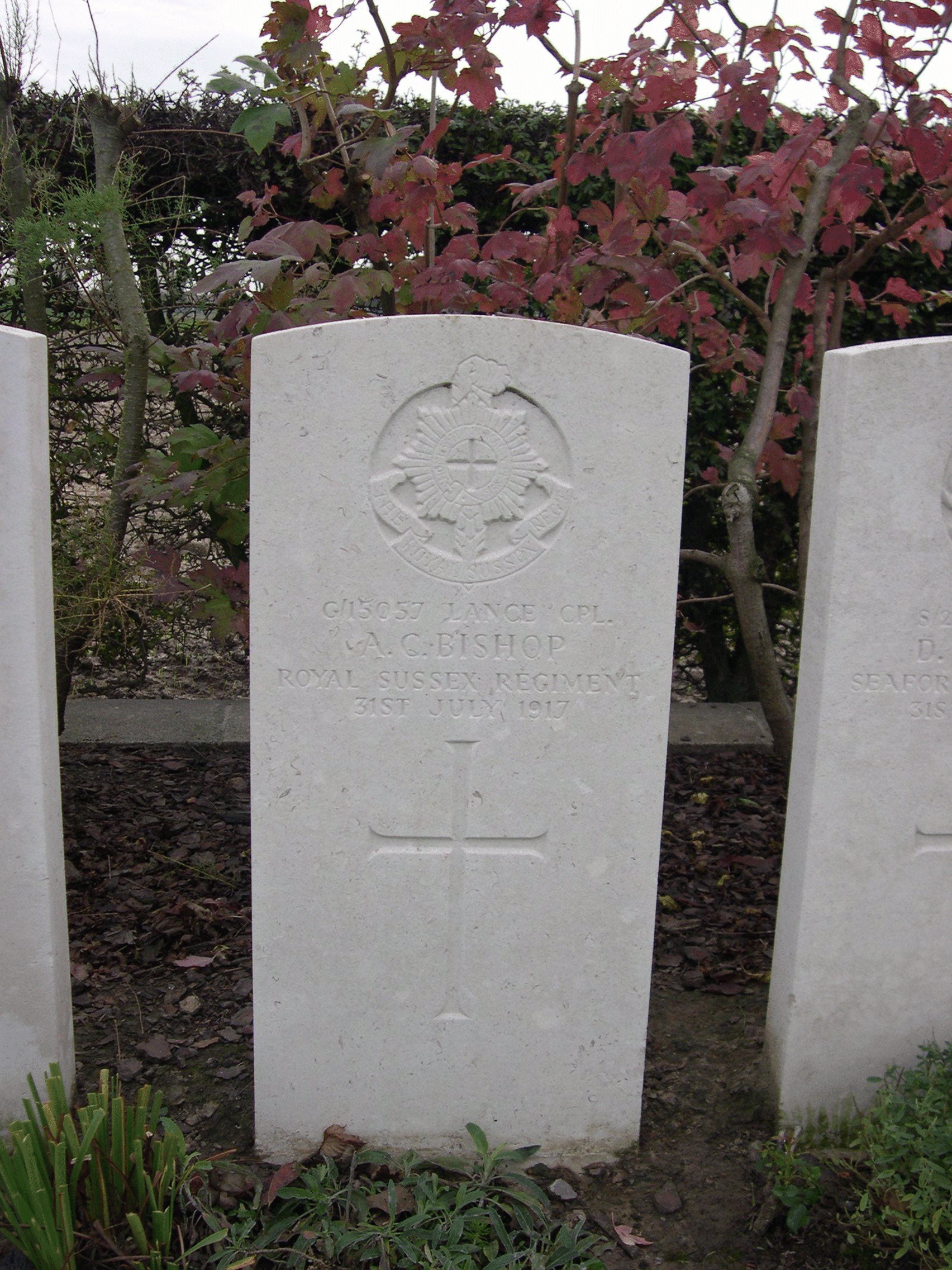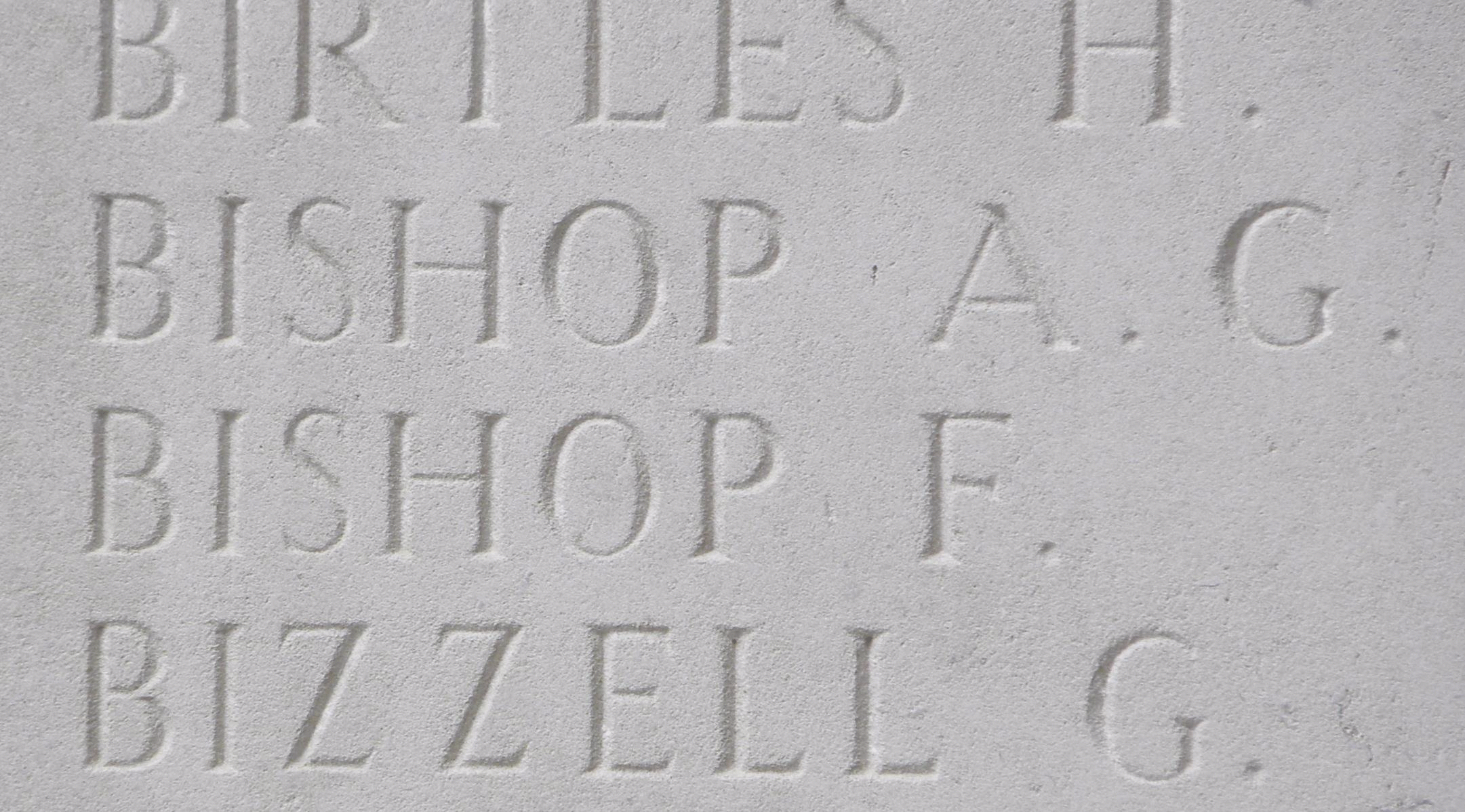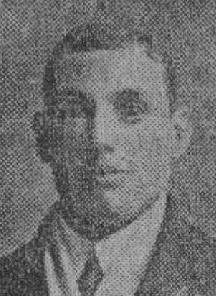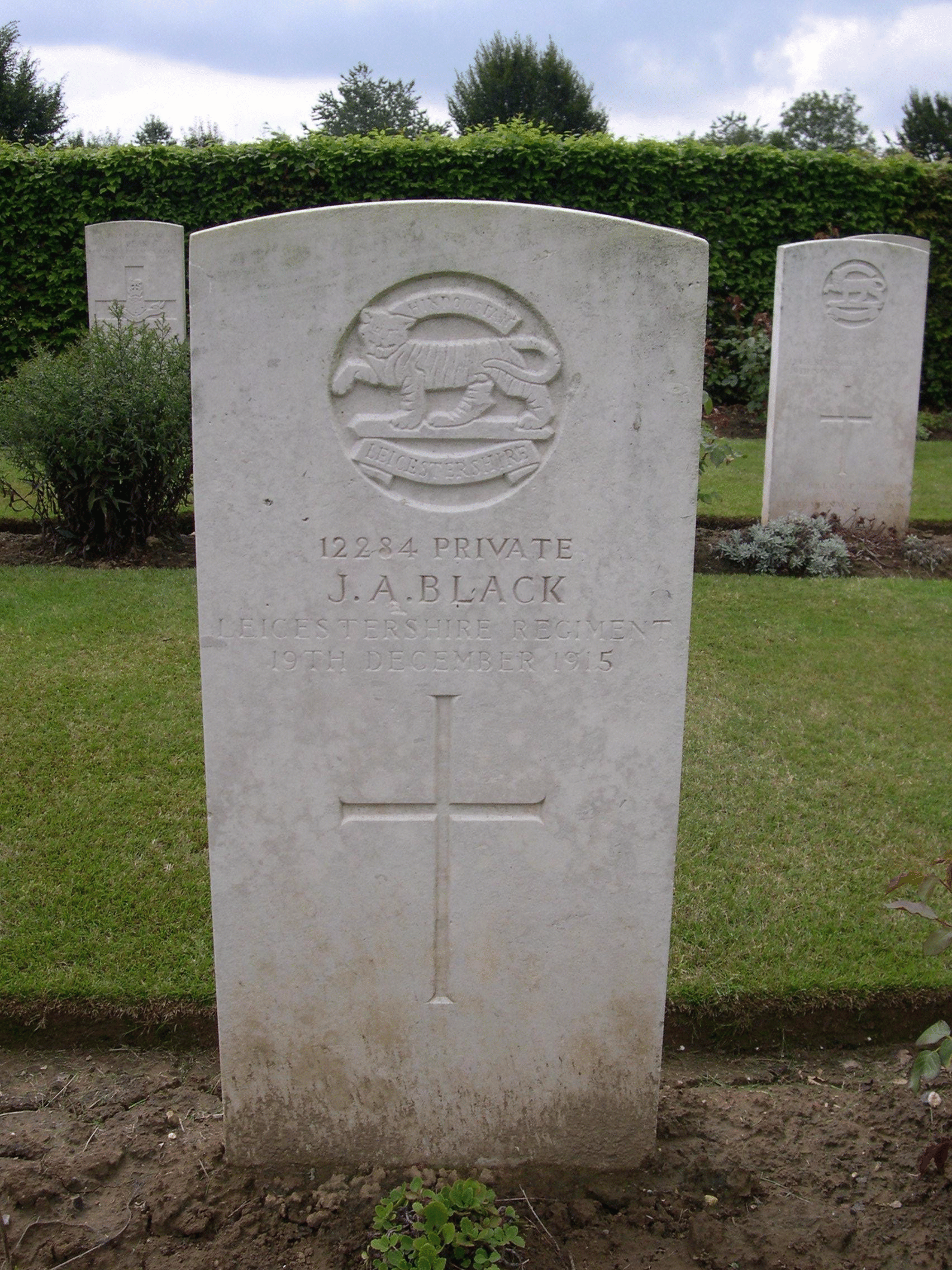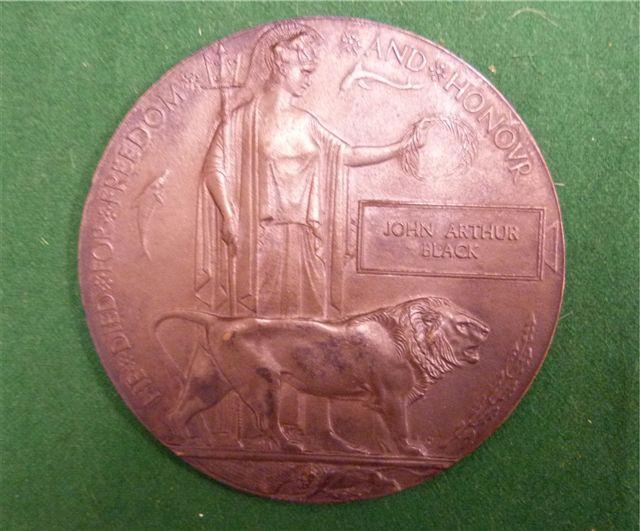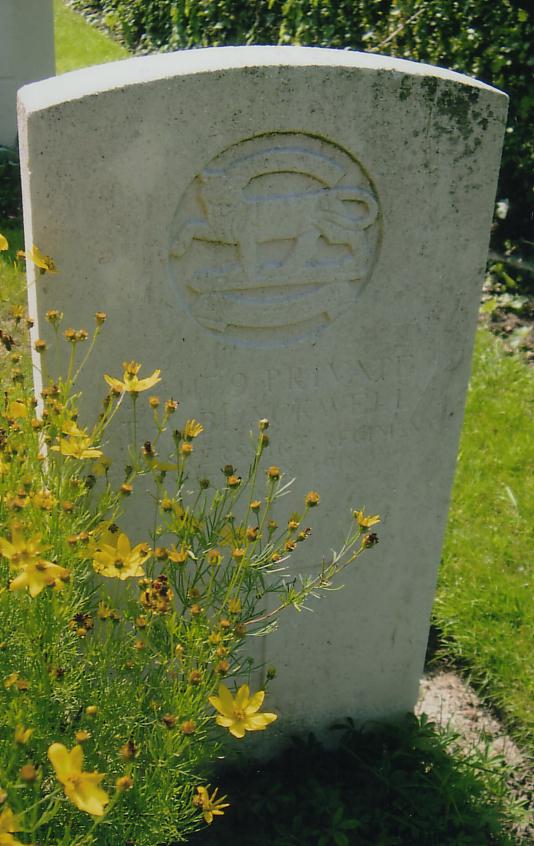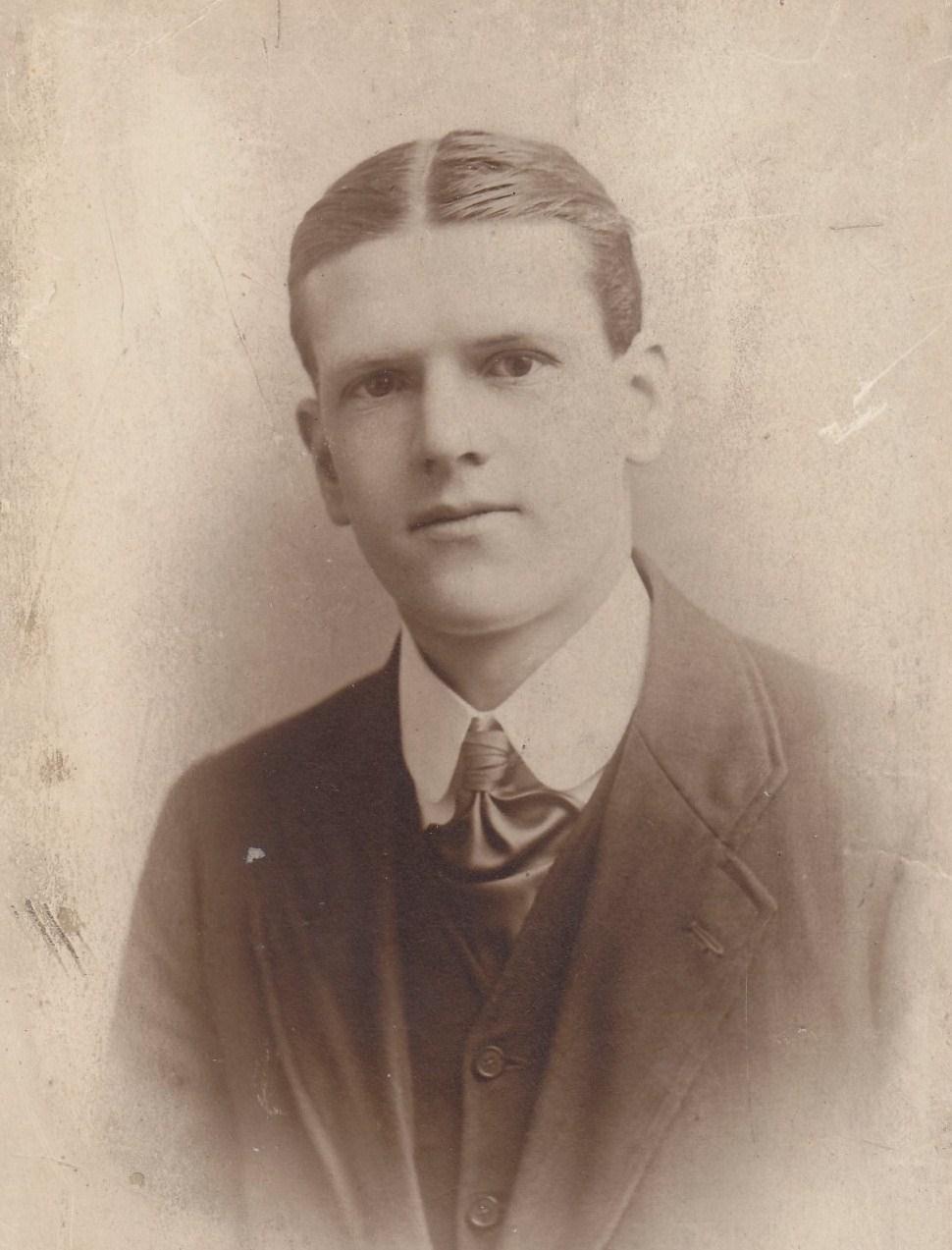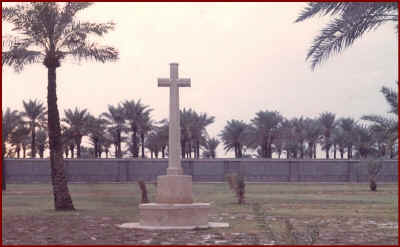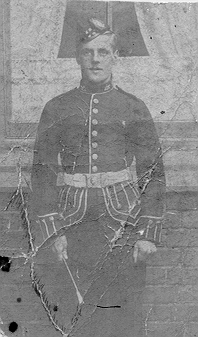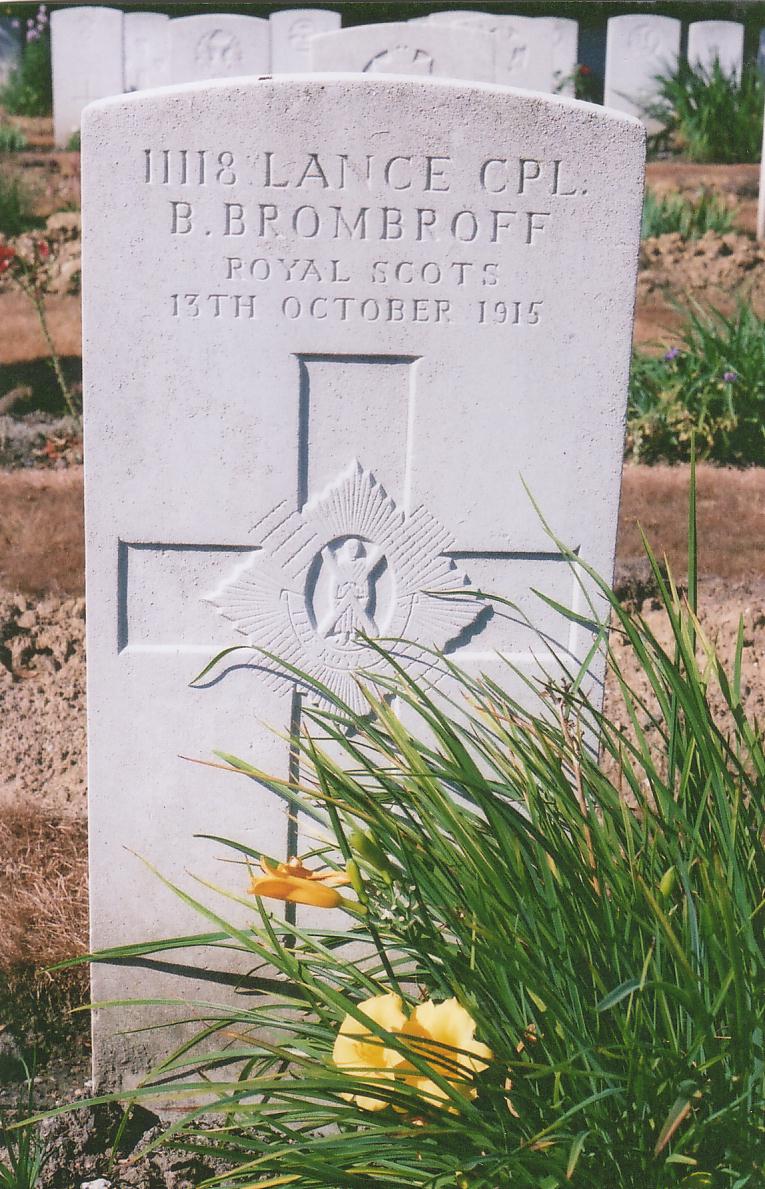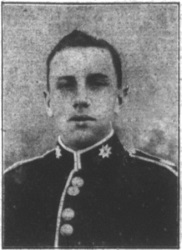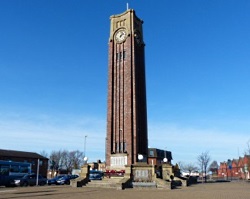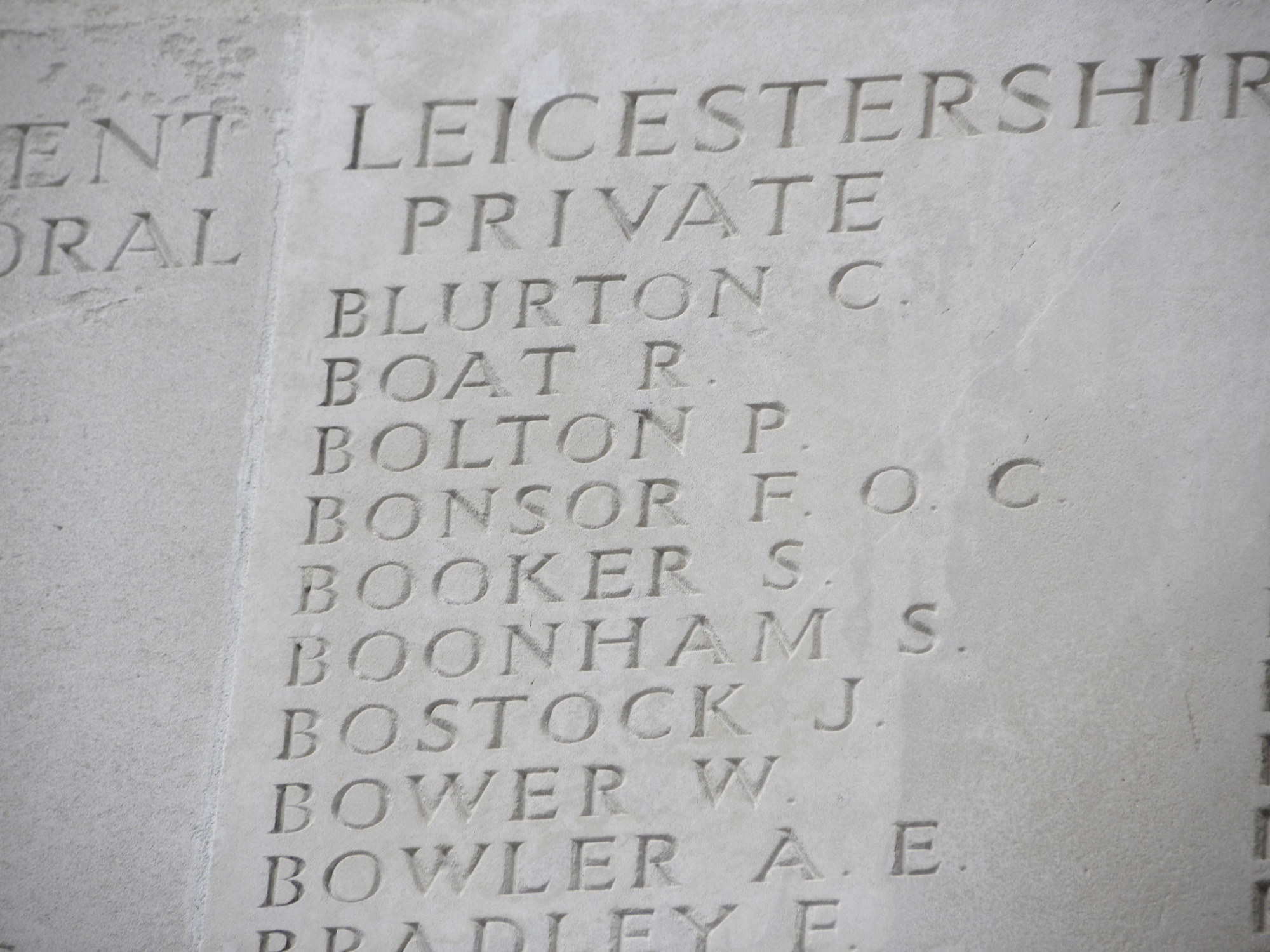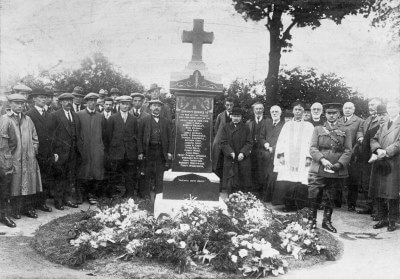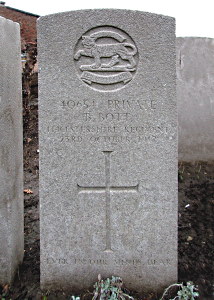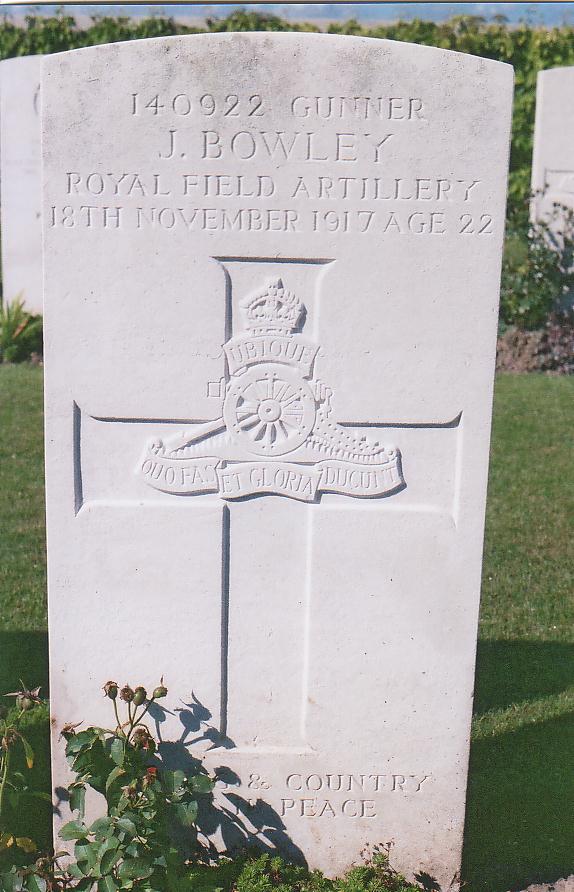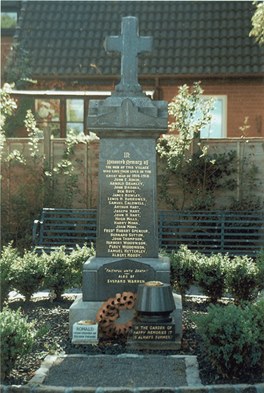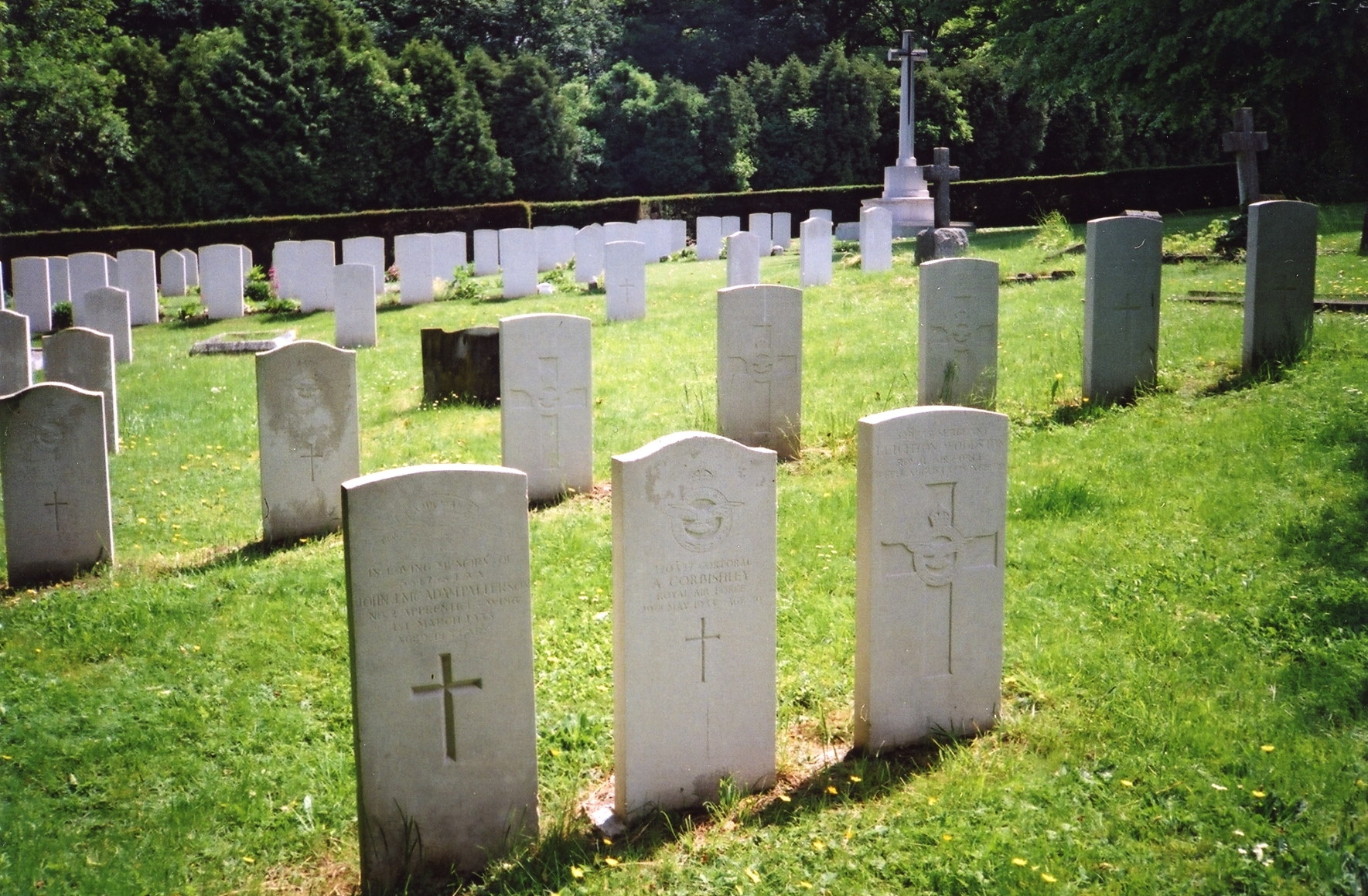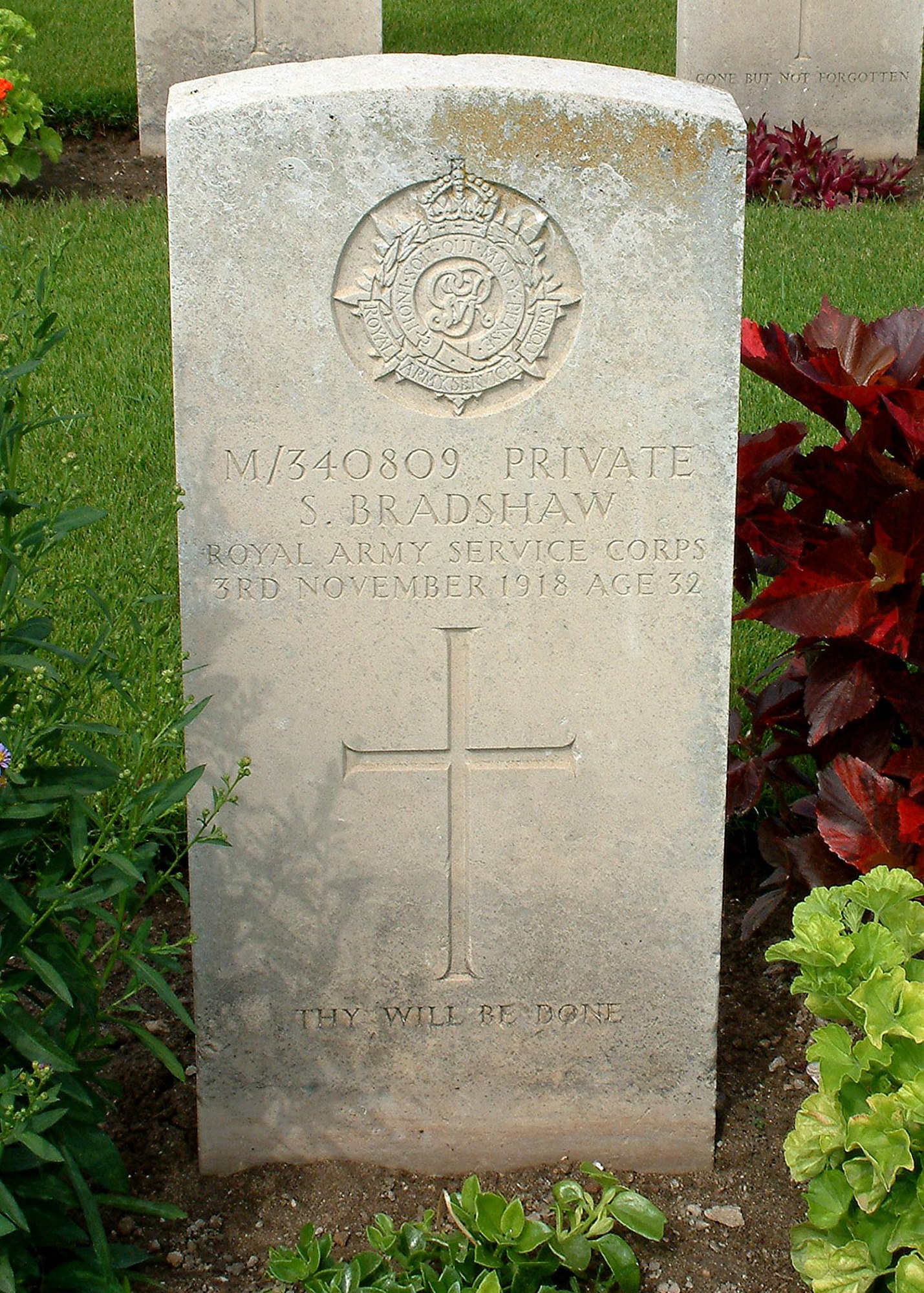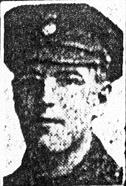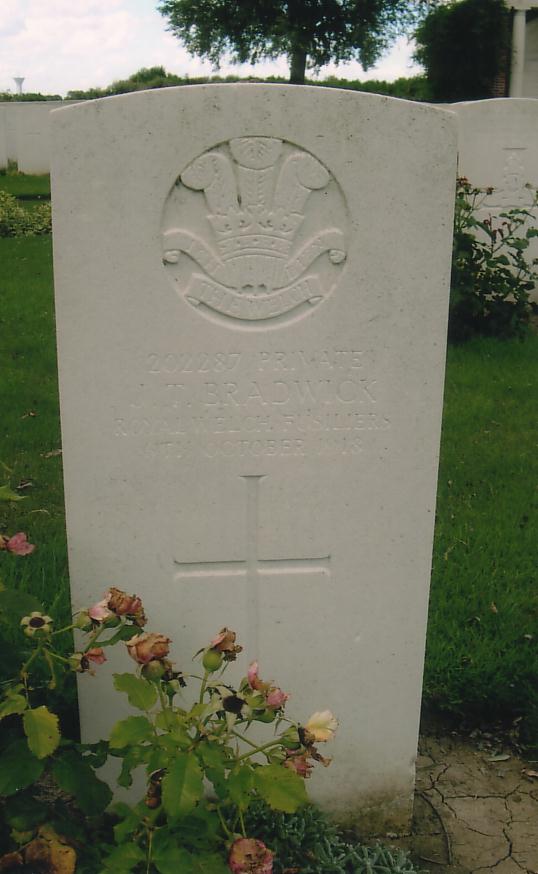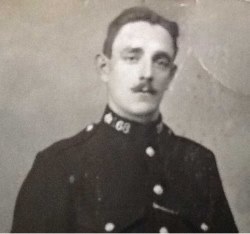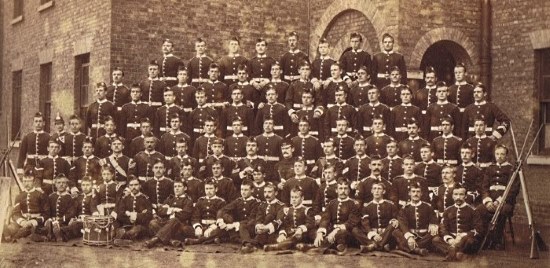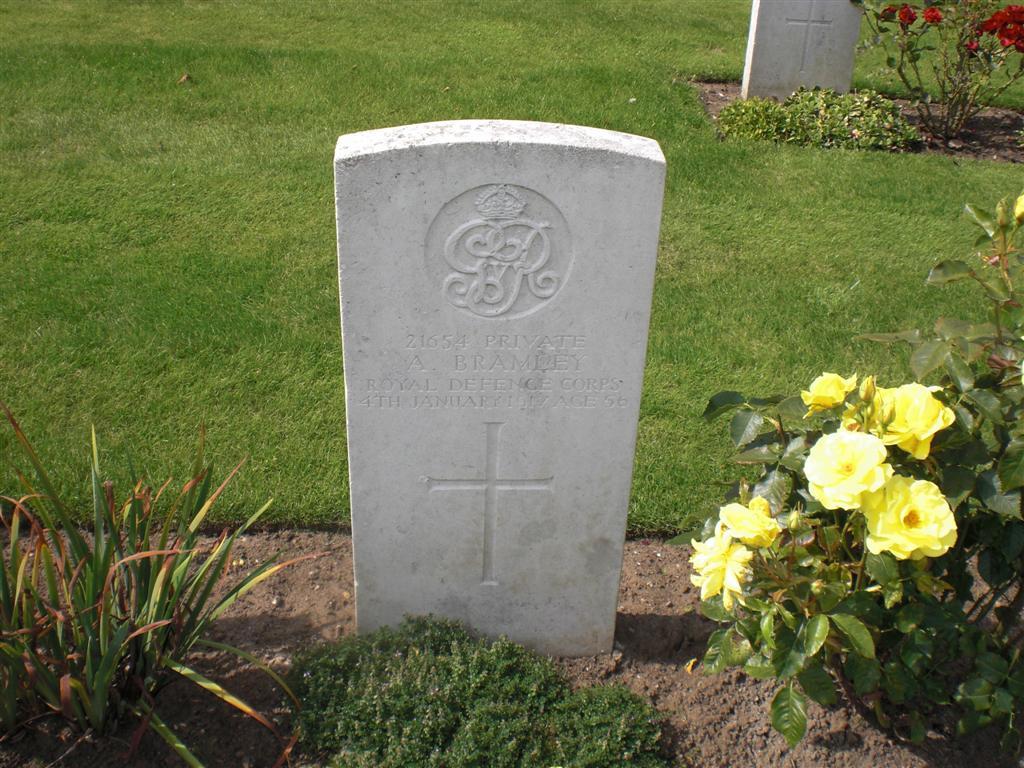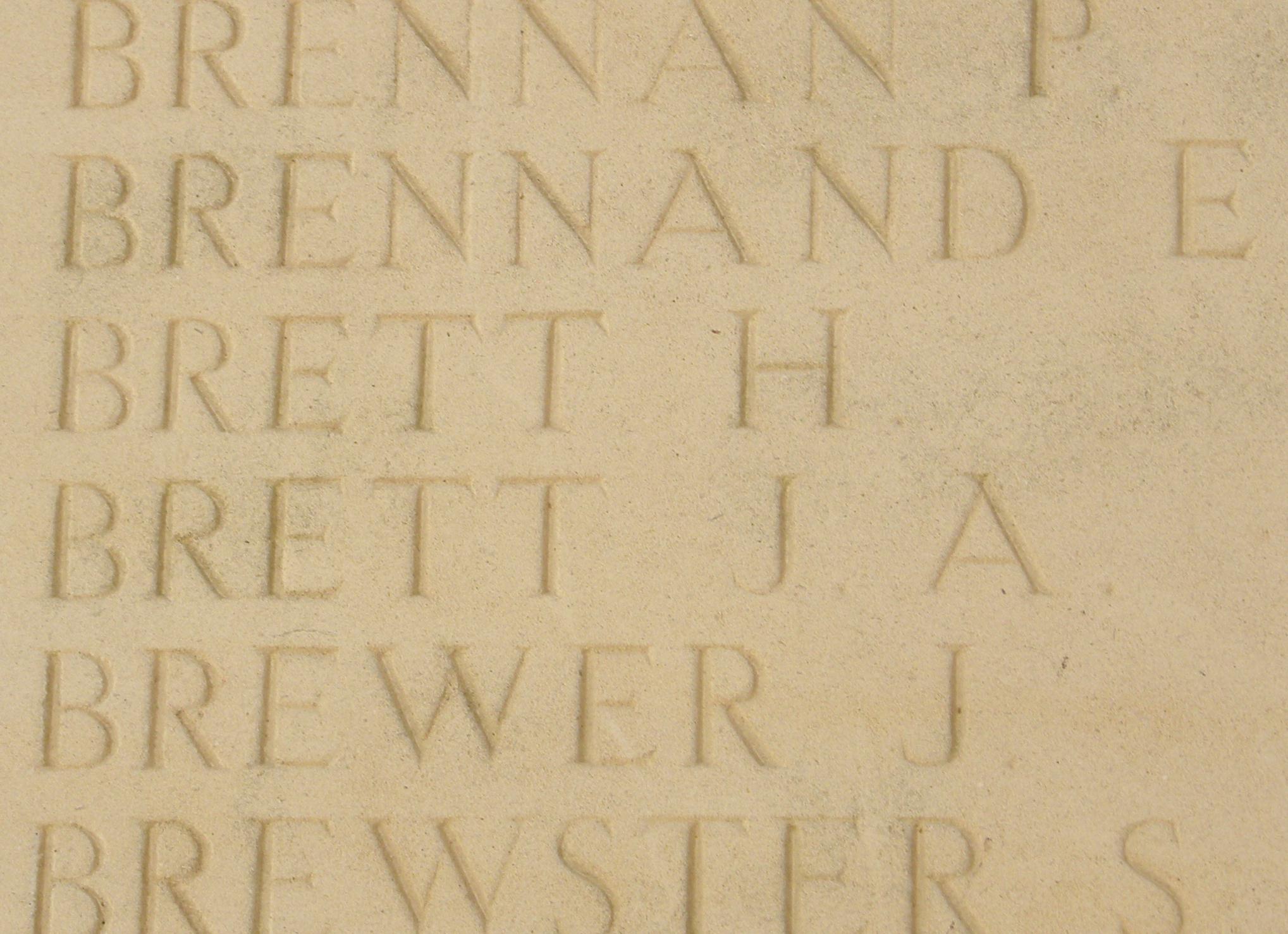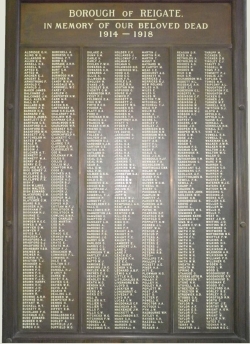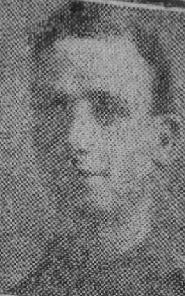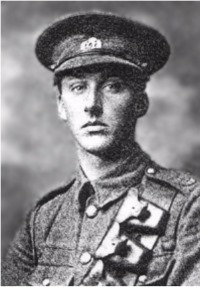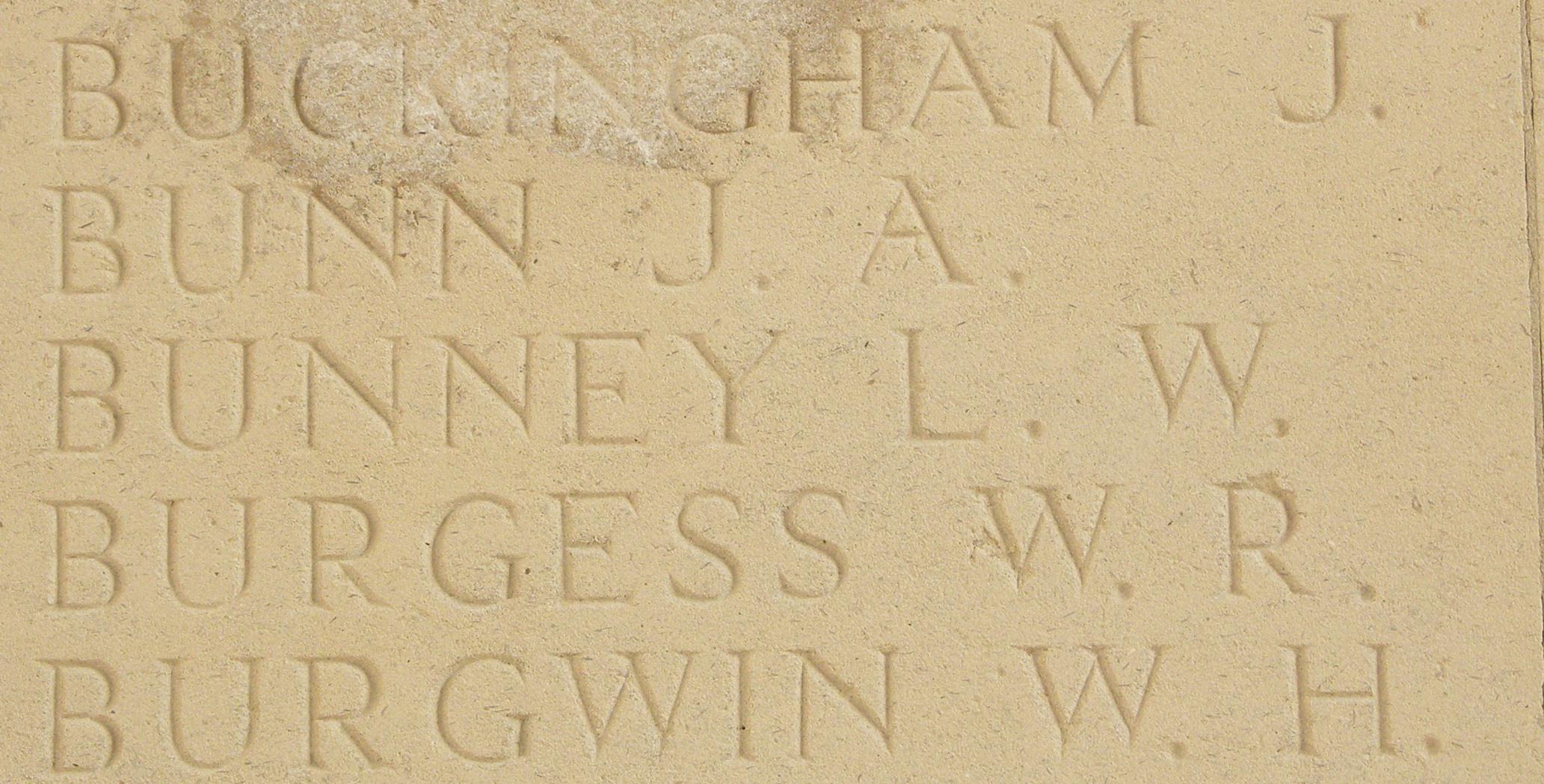|
Lance Corporal 4849179 Cecil Victor Abbott |
|
Died at Home 27th February 1921, Aged 21. Buried Loughborough Cemetery 315/17. |
|
Cecil Victor Abbott was born in Huntingdon on 3rd October 1901. He was the son of Charles Edward Abbott, a carter, and his wife Frances Elizabeth (née Gooding, afterwards Ray) who were married in Huntingdon in late 1894 or early 1895. Cecil had three brothers Frederick, Stanley and Donald and one sister Florence.
In 1906, when Cecil was registered at Huntingdon County Primary School, the Abbott family was living at 45 St. Germain Street, Huntingdon. By 1911 they had moved to 4 Great Northern Street, Huntingdon. After Cecil's mother died, aged 39, in 1913 his father moved to Loughborough. Cecil was with the Leicestershire Regiment as Private 4849179. He was subsequently promoted to Lance Corporal. Cecil died of pneumonia on 27th February 1921 at Leicester Royal Infirmary. He was 19 years old. His name was inscribed on the WW1 Commonwealth War Graves Commission (CWGC) Memorial at Brookwood Military Cemetery in Surrey because until recently his grave had never been found. He was actually buried in Loughborough Cemetery, Comp. 315, Grave 17. Cecil's young age at the time of his death, three years after the end of the war, indicates that he may have lied about his age to join up and been a boy soldier. He must also have earned his stripes as a Lance Corporal at a very young age, although little or no information about his war service has emerged so far. His service number is a post 1920 number issued by the Leicestershire Regiment in pursuance of AO 338 (1920). He may have been a boy soldier and enlisted or reenlisted after the Armistice. Cecil's grave was identified by the In From The Cold Research Project (IFCP). The IFCP was formed to research and identify all servicemen and women missing from the official War Graves Commission list of casualties from the two wars. Many names were unfortunately missed from the lists originally supplied to the Commission and, as a result, many casualties had no official commemoration. Record keeping was not always as accurate as it should have been back in the pre-computer days of the early twentieth century. With modern technology and the greater accessibility to remaining records, it is possible, through painstaking and often tedious research, to find many of these missing names and to gather the supporting evidence required for recognition by CWGC and the appropriate military authorities. The Commission takes into account all deaths of servicemen up until the end of August 1921, on the grounds that although the fighting had ended in 1918, there were still outstanding treaties and that this date also allowed the Commission to take into account instances such as soldiers who had been injured during the war but died later. Cecil's grave in Loughborough cemetery is to be given a special headstone by the Commonwealth War Graves Commission. He was still serving in the British Army when he died and is therefore entitled to a Commission grave. |
|
Private 32392 Walter Ernest Abell |
|
2nd Bn. York and Lancaster Regiment Formerly 27948, Leicestershire regiment Killed in Action 1st December 1917, Aged 20. |
|
Walter Ernest Abell was born in Loughborough in 1897. He was the only son of Frederick Abell and his wife Julia Ann (née Brewin) who were married on 23rd June 1888 at Emmanuel Church, Loughborough. As a young man Walter's father was a bricklayer's labourer but by 1901 he had become a gamekeeper and the Abell family was living in Kilmington, Wiltshire. By 1911 they had returned to 109 Leopold Street, Loughborough. Walter had one older sister, Annie Rosetta. At the age of fourteen he was a messenger for a cycle repair shop. Walter's service record has not survived but it would appear that he enlisted sometime during 1916. He initially joined the Leicestershire Regiment as Private 27948 but at some point was transferred to the 2nd Battalion of the York and Lancaster Regiment as Private 32392. The war diary of the 2nd York and Lancaster Regiment, unlike the war diaries of the battalions of most other regiments, omits to mention when the battalion received batches of reinforcement troops. It is consequently impossible to tell when Walter might have joined the 2nd York and Lancasters. In January and early February 1917 the 2nd Battalion of the York and Lancaster Regiment was in the Hohenzollern sector, where they completed five trench tours in very wet and muddy conditions. At night the battalion provided wiring parties and went on patrols. Breaks were taken at Noyelles. From 15th-28th February the battalion was resting at Robecq where inspections and instructional parades took place. In March and April there were more trench tours, this time in the Loos sector, with breaks at Les Brebis. Enemy trench mortars were particularly troublesome here on the last two days of March and the first day of April. On 12th April the battalion carried out a raid on the German front, and having found that the enemy had mostly evacuated, pushed forward to occupy a position south-east of Loos Crassier but when the battalion moved up to the Reserve line in the St. Elie sector on 24th April the men suffered a five hour enemy bombardment. At the beginning of May the battalion moved to Fouquières for a week's training after which they went into the line in the Hulluch sector and were on the receiving end of hostile gas shells. In early June there was more training at Fouquières, followed by more trench tours with breaks at Mazingarbe. In July the battalion was back in the Hulluch sector trenches before moving to Orlencourt on 22nd for one month's rest and training. The final days of August were spent in the left sub-sector of the front line near Hill 70. The battalion completed another trench tour near Hill 70 in early September before moving to Houchin for further training and then to South Maroc to provide working parties. September ended with the battalion in the line at Cité St Emile. In October 1917 the battalion was in Reserve at Cité St. Pierre, training at Mazingarbe for a raid, in the line again at Cité St Emile and finally training at Livossart, Palfart and Ivergny. After the training concluded on 14th November the battalion marched to Bouquemaison, entrained for Peronne and marched to billets at Moislain and then to L2 Camp near Fins. On 17th November the battalion was in the support line at Plouich and two days later ordered to take part in an attack, assisted by tanks, on the Hindenburg Line. Having succeeded they were ordered to hold the new front line but heavy enemy shelling drove them back, the Germans broke the line and the battalion was forced to withdraw to form a defensive flank. On 30th November the battalion was ordered to attack Quentin Ridge but visibility was poor and the tanks got into difficulty. On the following day, 1st December, the battalion was ordered to attack Quentin Ridge between Gouzeaucourt and Gonnelieu but the order was so sudden there was no artillery support. The operation cost the battalion 71 casualties and Walter, aged 20, was killed in action on 1st December. Walter is commemorated on the Cambrai Memorial panels 9 and 10 and on the Carillon. |
|
Air Mechanic 3rd Class 410113 George Scott Adlard |
|
Royal Air Force Loughborough Cemetery 42/316
|
|
George Scott Adlard was born in Loughborough in the summer of 1889. He was the son of Harry Walter Scott Adlard and his wife Elizabeth (née Lovett) who were married in Loughborough in 1880. George's father was a joiner and in 1891 the Adlard family lived at 10 Pinfold Gate, Loughborough. They later moved to 24 Rendell Street and then to 19 Heathcote Street. George had five brothers Harry Junior, Cyril, Percy, Laurence and Archibald and three sisters Beatrice, Lucy and May. Two other brothers died aged 1 and Lucy and May both died at the age of 18.
When George left school he became a coach finisher. George's Army service record has not survived but according to the Absent Voters List 1918 for Loughborough he enlisted with the 1/5th Battalion of the Leicestershire Regiment. His Royal Air Force service record notes that he originally enlisted with the Army on 9th January 1915. There is no evidence, however, that he was ever sent overseas. On 20th September 1918 he transferred to the Royal Air Force and on 2nd October was sent to a Recruits' Depot. On 18th October he was sent to No. 10 Motor Transport Repair Depot as an Air Mechanic Class 3 and numbered 410113. He was demobbed at Harrowby Dispersal Centre in Lincolnshire, on 24th January 1919 and transferred to Class G, RAF Reserve. George died, aged 30, on 6th March 1920 in Loughborough. He was buried in Loughborough Cemetery Grave 42/316. George's brothers Cyril and Laurence both served in the war, Cyril at the Leicestershire Regiment Depot and Laurence with the Royal West Kent Regiment, Labour Corps and Royal Fusiliers. Both survived the war. |
|
Private 40388 John Allen |
|
1/5th Bn. Leicestershire Regiment Killed in Action 28th June 1917, Aged 38 |
|
John Allen was born in Leadgate, Durham in 1879. He was the son of Charles Allen and his wife Emma (née Overall) who both came from Essex, but who were married in Lanchester, County Durham, in 1876. John's father was a labourer. By 1891 the Allen family had moved south again, this time to Upchurch in Kent where John's father had obtained employment as a cement factor in the Falcon Cement Works at Overshore, Otterham Creek and John, aged 22, was a brickfield labourer. John had six sisters Mary, Sarah, Rose, Alice, Kate and Lily. After John's father died at work in 1905 his mother moved to Chaffs Lane, Upchurch, with John and her only unmarried daughter Lily. It would appear that John subsequently moved to Loughborough.
John enlisted at Leicester and joined the Leicestershire Regiment as Private 40388. His date of enlistment is unknown as his service papers have not survived. His service number indicates, however, that he enlisted in the late summer of 1916. Whether he was sent to France to join the 1/5th Battalion of the Leicesters in late 1916 or early 1917 is also unknown. On 29th October 1916 the 1/5th Battalion moved to Millencourt for intensive battle training, and then to Halloy and Souastre at the beginning of December. The battalion remained at Souastre until 11th March 1917 and then moved up to the front line taking over 2,600 yards of frontage from the La Brayelle road to the Hannescamps-Monchy road. On 17th March they moved into Gommecourt for road mending before moving to Bertrancourt, Raincheval and then Rainvillers not far from Amiens. On 28th March the battalion marched to Saleux, entrained for Lillers in the north, and marched to Laires. Training took place until 13th April and continued for three further days at Manqueville, after which the battalion moved to the western outskirts of Lens. From there they marched to Bully-Grenay and went into the front line trenches where they were heavily shelled. On 29th April the battalion went into rest billets in cellars at Cité St. Pierre until 3rd May when they went into support trenches. On 8th they went into billets at Fosse 10 near Petit Sains for training and on 12th into reserve at Angres. Further trench tours south-west of Lens followed until 26th May when the battalion went into billets at Marqueffles Farm for training in bayonet fighting and bombardment and to practise methods of attack. On 6th June the battalion was back in the line and on 8th June went into the attack, suffering 96 casualties. Apart from two breaks at Red Mill from 9th-13th and 18th-20th June the battalion was in the trenches until 22nd June. On 21st June C Coy was accidentally gassed by the Royal Engineers, resulting in 94 casualties of whom 22 died. Back at Marqueffles Farm from 22nd the battalion had Lewis gun and signalling classes as well as attack training over a flagged course. On 27th June the battalion moved up to the line ready to attack on the following day. As they climbed out of the trenches on 28th June they met with the inevitable machine gun fire. John was killed in action on 28th June 1917, aged 38. He is remembered on the Arras Memorial Bay 5, on the memorial in the Church of St. Mary the Virgin, Upchurch, and on the Carillon, Loughborough. |
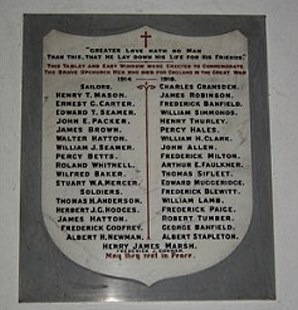 Memorial at Church of St. Mary the Virgin, Upchurch |
|
Sergeant 5586 Percy Herbert Allen |
|
2nd Bn, Leicestershire Regiment. Killed in action 25th September 1915, Aged 33. Commemorated Loos Memorial panel 42 - 44.
|
|
Percy Herbert Allen was born in Pateley Bridge, Yorkshire, in 1882, the son of George Allen a printer compositor and Hannah ('Annie') Allen (née Busfield) who were married in Dacre, Yorkshire, on 24th February 1877. Percy had two brothers George and Arthur and two sisters Clarice and Nellie. In 1901 Percy's family lived at 11 Queen's Road, Loughborough. On 13th June 1898 Percy, a hosiery worker for the Nottingham Manufacturing Company, attested at Loughborough for the 3rd Leicestershire Regiment and was appointed as a Private on 16th June 1898. On 10th March 1899, however, he purchased his discharge. In between times, on 19th September 1898 Percy had obtained work as a Parcels Delivery porter at Loughborough Midland railway station. On 2nd November 1899 Percy again attested at Leicester for the Leicestershire Regiment and was appointed to the 2nd Battalion as Private 5586. From early 1900 Percy was stationed in Gibraltar and in 1902 he was posted to Fort George, Guernsey. While Percy was stationed there he was promoted to Corporal on 10th January 1903. He also met and married his wife, Violet Edith Maud Austin, in St. Peter Port. On 29th May 1906 Percy, who was at the time serving in the Regimental Depot in Leicester, was appointed a Lance Sergeant. Percy and Violet had at least seven children, four of whom seem to have survived to adulthood: Dorothy, Percy William, Cyril and Dennis. Percy must have left the military as in 1911 he was an iron foundry labourer and living with his wife and family at 34 George Street, Loughborough. On 2nd November 1911, however, he was re-engaged by the Leicestershire Regiment and sent to Egypt and India. He was subsequently appointed Lance Sergeant at Portsmouth on 8th August 1914, Acting Sergeant at Fort Purbrook, Portsmouth, on 25th August 1914 and promoted to Sergeant on 8th September 1914. He embarked at Southampton for the British Expeditionary Force on 11th December 1914. In 1915 the 2nd Battalion of the Leicesters, part of an Indian Army formation led by Major-General Charles Blackader, took part in the battles of Neuve Chapelle (10th-13th March) and Aubers Ridge (9th May) and an additional night attack on 15th May, the first day of the Battle of Festubert. The 2nd Leicesters spent the next couple of months alternately in the trenches or in billets while war training, in the area of Calonne and Vieille Chapelle north-east of Bethune. The corps was then rested in a quiet sector until it was deployed for the Battle of Loos. The initial attack at Loos was to be made by three divisions, with the Meerut Division leading the attack on the Indian front; Blackader's brigade, with two Gurkha battalions and the 2nd Leicesters, was on its right flank. Whilst the attack successfully crossed no-man's land under cover of the barrage, the right flank of the brigade was caught up in defensive wire, and only one battalion successfully made its way into the German trenches. Gas also affected some of the men and the smoke caused a dense fog, making direction difficult. From the 2nd battalion 72 men were killed, 217 wounded, 42 were gassed, and 96 were recorded as missing. Percy, aged 33, was one of those killed. Percy's wife Violet died in the flu epidemic of 1918. |
|
Company Sergeant Major 240358 |
|
1/5th Bn, Leicestershire Regiment. Died of Wounds 5th October 1918, Aged 38. Buried Tincourt New British Cemetery, Somme, V1. F. 19.
|
|
Edwin Angrave was born in Nanpantan, Leicestershire, in the spring of 1880. He was the son of George Angrave, a framework knitter, and his wife Sarah (née Bland) who were married in Loughborough in 1871. Edwin had three brothers Ernest, Alfred and George Charles and one sister Mary. Another sister Kate died in infancy. The Angrave family lived in Forest Road, Nanpantan.
On 21st April 1900 Edwin, now aged 20 and a labourer, enlisted in the Volunteer Company of the Leicestershire Regiment for service in the 2nd Boer War. He was sent to join the 1st Battalion of the Leicestershire Regiment in South Africa on 11th May 1900. When Edwin arrived in South Africa the Ist Leicesters, after the relief of Ladysmith, had been moved north by Sir Redvers Buller, and were brigaded with the 1st Liverpool, 1st Royal Inniskilling Fusiliers, and 1st King's Royal Rifles. The battalion took part in the operations that carried the war into the Orange Free State, and the Transvaal, and was present at the storming of Laing's Nek and the capture of Amersfort, Ermelo and Belfast, and in the operations around Lyndenberg. For a long time prior to the close of the war they occupied blockhouses on the Standerton-Ermelo road. Edwin returned to England on 25th May 1901 and was awarded the Queen's South Africa Medal with clasps for Cape Colony and the Transvaal. He was discharged from service on 30th May 1901. By 1911 Edwin was employed as a gardener and lodging with a widow Susannah Whiles in Main Street, Woodhouse Eaves. When war broke out in 1914 he reenlisted and joined the 1/5th Battalion of the Leicestershire Regiment as Lance Corporal 2011, later renumbered as 240358. The date on which Edwin was promoted to Company Sergeant Major is unknown as his First World War service papers have not survived. The 1/5th Battalion was based at Bishops Stortford in November 1914 but was soon moved to Luton to practise marching and night work. On 25th February 1915 they were ordered to entrain at Harlow for Southampton. They landed at Le Havre three days later. They went by train to St. Omer, and then marched to Hardifort. The battalion spent the first few months in France in the Armentières sector, training and doing tours in the trenches. In June they moved to the Salient, near Zillebeke and Ouderdom, where they remained until the beginning of October when they were ordered to move towards Loos. From July to September 1915 the battalion remained in the area of Zillebeeke and Ouderdom, before moving to Hesdigneul-lès-Béthune in October, La Couture in November and Merville and Thienne in December. On 12th October 1915 the battalion travelled to the Hohenzollern Redoubt, arriving in Vermelles at 10.00pm. They spent the next eight hours in communication trenches. On 13th October 1915 during the attack on the Redoubt, part of the final stages of the Battle of Loos, the 1/5th Battalion was in reserve until just after midday, when they 'went over the top' and came under intense machine gun fire. January 1916 was taken up with a potential move of Edwin's battalion to Egypt which was aborted at Marseilles, the battalion being returned to Candas, and the area of Vimy Ridge. In mid-February 1916 the 1/5th Battalion took over the line north of the River Ancre opposite Beaumont-Hamel. On 29th February the battalion moved to the area of Doullens where the men worked on improving the trenches despite being subjected to a considerable bombardment from the enemy with mines and craters being blown. From 9th March 1916 the 1/5th Leicesters were in the area of Vimy Ridge, Pas de Calais, either in the front line, in support, in reserve or at rest. On 27th April the battalion was sent to the neighbourhood of Neuville St. Vaast to work with the French and English tunnellers and then to billets in Luchaux for bayonet training. This was followed by a period at Souastre digging cable trenches, and constructing bomb stores and gun pits in preparation for a 'big push'. On 4th June 1916 the battalion was moved up to trenches near Gommecourt. This was followed by further training at Warlincourt. On 30th June the battalion assembled in a trench near Foncquevillers Church ready for the diversionary attack at Gommecourt on the first day of the Somme Offensive planned for 1st July. On 1st July 1916 the 46th Division of the Army, of which the 1/5th Leicesters were part, had 2445 casualties at Gommecourt. On 7th July they relieved the 4th Lincolnshires in the trenches opposite Essarts-lès-Bucquoy. The battalion remained in the area of Monchy-au-Bois until 29th October, either in the trenches or resting at Bienvillers or Pommier. The battalion's next move was to Millencourt for intensive battle training, returning to Halloy and then Souastre at the beginning of December. The battalion remained at Souastre until 11th March 1917 and then moved once more up to the line taking over 2,600 yards of frontage from the La Brayelle road to the Hannescamps-Monchy road. On 17th March they moved into Gommecourt for road mending before moving to Bertrancourt, Raincheval and then Rainvillers not far from Amiens. On 28th March the battalion marched to Saleux, entrained for Lillers in the north, and marched to Laires. Training took place until 13th April and continued for three further days at Manqueville, after which the battalion moved to the western outskirts of Lens. From there they marched to Bully-Grenay and went into the front line trenches where they were heavily shelled. On 29th April the battalion went into rest billets in cellars at Cité St. Pierre until 3rd May when they went into support trenches. On 8th they went into billets at Fosse 10 near Petit Sains for training and on 12th into reserve at Angres. Further trench tours south-west of Lens followed until 26th May when the battalion went into billets at Marqueffles Farm for training in bayonet fighting and bombardment and to practise methods of attack. On 6th June the battalion was back in the line and on 8th June went into the attack, suffering 96 casualties. Apart from two breaks at Red Mill from 9th-13th and 18th-20th June the battalion was in the trenches until 22nd June. On 21st June C Coy was accidentally gassed by the Royal Engineers, resulting in 94 casualties of whom 22 died. Back at Marqueffles Farm from 22nd the battalion had Lewis gun and signalling classes as well as attack training over a flagged course. On 27th June the battalion moved up to the line ready to attack on the following day. As they climbed out of the trenches on 28th June they met with the inevitable machine gun fire and over the next two days 60 Ordinary Ranks were killed. Relieved from the trenches at Lievin on 3rd July the battalion moved to Monchy-Breton for reorganisation and training until 22nd July when they moved to Vaudricourt before going into the line at Hulluch until 28th July. After respite at Noeux-les-Mines the battalion was at Fouquières until 14th August, practising for an attack. Moving to Noyelles the battalion went into the trenches on 15th August and carried out a raid on the German trenches at Hulluch on the night of the 16th/17th August. After a break at Noyelles for training the battalion returned to the trenches. The end of August was spent at Philosophe, providing carrying parties. During September, October and early November 1917 the battalion completed six trench tours at St. Elie, with breaks at Fouquières and Philosophe. During one tour the battalion was visited by a Mr. Wilkes of the Leicester Mail, 'attired in a grey suit, steel helmet and box respirator'. On 14th November the battalion moved to Mazingarbe for a trench tour in the Hill 70 sector. November ended with the battalion billeted at Verquin, Vaudricourt and Drouvin for training and a battle rehearsal. Three more trench tours took place in December, this time in the Cambrin right sector where there were a number of very heavy bombardments and gas attacks by the enemy. New Year's Day 1918 was marked by another heavy bombardment on the battalion's trenches near Hulluch. During early January when away from the front line the battalion also provided wire carrying parties and working parties. On 20th January the battalion began a four-day transfer by march to Chocques. Between 24th January and 28th February the battalion was in training at Chocques, Allouagne, Fiefs, and Reclinghem. Between 28th February and 2nd March the battalion moved via Delettes and Ligny-lès-Aire to Ecquedecques where inspections took place. On 6th March they went into Brigade support on the Annequin-Cambrin road, at Annequin Fosse and at Sailly-Labourse. On 8th they marched to the front line trenches in the Cambrin right sub-sector where, until 15th March, they experienced considerable enemy shelling. After moving into Brigade reserve at Sailly-Labourse, Factory dugouts, Windy Corner and Central Keep on 16th they were again shelled by the enemy. On 20th March the battalion went into Divisional reserve at Beuvry. On 24th March they returned to the Cambrin right sub-sector trenches (now renamed the Hohenzollern sector) where all available men were employed at night on wiring. After a break at Sailly-Labourse the battalion marched to Fosse 7 and into Hill 70 Support on 28th March. Two companies moved up to the front line on 1st April and inter-company reliefs took place on 5th April. The men were in the trenches for nine days, suffering repeated bombardments of all kinds, including mustard gas shelling. On 10th April the battalion moved back into Hill 70 support, but the back areas were filled with gas and the men were sent to Coupigny Huts, Bracquemont. Training began on 15th April but two days later 100 men became sick with what the medical specialists considered to be influenza. Sixty men were evacuated and a special rest station was set up. Those men who were well were moved to Hersin and another 100 evacuated. On 24th April the battalion moved to Bruay and went into Reserve at Fouquières on 25th, only to be shelled in their billets. As the battalion was marching to the trenches at Le Hamel on 28th April the enemy opened fire near Essars. Three men were killed and thirty-five wounded or gassed. The battalion reached the trenches on 29th April and remained there until 7th May. During this time they were heavily shelled and a night wiring party was ambushed by the Germans. During the rest of May, June, July and August the battalion did trench tours in the Gorre sub-sector and at Essars/Le Hamel. Breaks were taken at Vaudricourt Park Camp and in August there were four days of training at Hesdigneul. The men also enjoyed a concert party by The Whizz-Bangs at Verquin. By 7th August there were signs that the enemy was withdrawing and at the beginning of September, when the battalion pushed forward to Richebourg, they found a number of notices pinned up which said: 'Dear Tommy, You are welcome to all we are leaving. When we stop we shall stop and stop you in a manner you won't appreciate. Fritz.' The day after the note was found the battalion front was severely bombarded by the enemy. 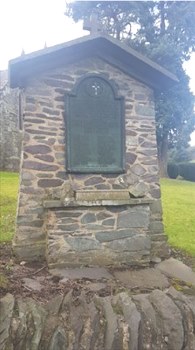 Memorial, St. Paul's Churchyard, Woodhouse Eaves From 9th -11th September the battalion was in training at Gosnay sandpits and between Béthune and Verquin. On 12th September they entrained at Chocques for Ribemont-Méricourt. Between 14th and 18th September they continued training, at Sailly-le-Sec in field firing and using a compass at night, at Franvillers in a Brigade tactical scheme, and at Teutry in attack procedure. After this they marched to the Brigade support position in a newly captured sector east of Le Verguier and prepared for an attack on Pontruet. On 24th September the battalion took part in this operation before returning to the trenches at le Verguier. A major operation was now being planned in the area of the St. Quentin Canal. This began on 29th September with an attack on the Hindenburg Line. The battalion advanced to the canal in artillery formation. After crossing the canal they advanced and secured Magny-la-Fosse on 1st October. On 3rd October 1918 A and D Coys, ordered to attack Doon Hill, formed up on the Preselles to Sequehart road. An enemy shell hit C Coy headquarters and Edwin was wounded in the back. He died from his wounds on 5th October 1918, aged 38. He had been awarded the Medaille Militaire by France for his work in March 1918. Edwin is commemorated on the Woodhouse Eaves memorial, on the memorial in St. Paul's Churchyard, Woodhouse Eaves and on the Carillon, Loughborough. |
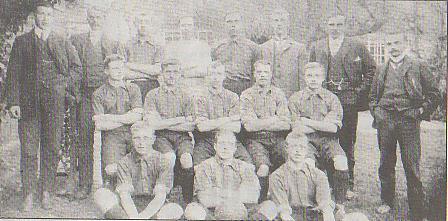 St. Pauls F.C. Edwin Angrave (Goalkeeper) back row 4 from left.
|
|
Private 36455 George Randall Angrave |
|
1/4th Bn. Essex Regiment. Formerly 165756, Royal Field Artillery. Killed in Action Palestine 3rd November 1917, Aged 19. (His brother Thomas Edward Angrave also fell see below) |
|
George Randall Angrave, known to his family as 'Randall' was born in Loughborough in late 1897 or early 1898. He was the son of George Angrave, a hosiery needle maker, and his wife Catherine (née Peach) who were married in Loughborough in 1895. Randall had one older brother Thomas and three younger sisters Mary, Annie and Elizabeth. Another brother Wilfred died aged three months. Randall grew up at 38 Paget Street, Loughborough. When Randall's father George unfortunately died in 1909, the family moved next door to 40 Paget Street. Randall enlisted in Loughborough in the late spring or early summer of 1916 and joined the Royal Field Artillery as Private 165756. At some point between 1916 and 1917 he was transferred to the Essex Regiment as Private 36455 and sent to the Middle East. Whether he joined the 1/4th Battalion of the Essex Regiment in Egypt or Palestine is unknown as his service record has not survived. The 1/4th Battalion, part of the 161st (Essex) Brigade in 54th (East Anglian) Division of the Army, had been in Egypt since December 1915, guarding the coast railway from Alexandria to Da'aba and then the Suez Canal defences. By August 1916 the Ottoman offensive into Egypt had ended and the Turkish forces retreated into Palestine. The Allies' focus then changed from defence of the canal to advance into Sinai and Palestine. The 54th Division was placed on Desert Column Establishment at the end of January 1917 with orders to march east. Moving through El Ferdan and Kantara (on the east side of the Suez Canal) the battalion crossed the Sinai Desert to Deir el Blah to take part in the Palestine Campaign. Deir el Blah in the central Gaza strip was the HQ of the Eastern Force and the location of the coastal supply route. Cargoes were landed on the beaches and then transported to forward supply depots and ammunition dumps. Supplies also arrived via the Sinai railway. At the 1st Battle of Gaza (26th March 1917) the 161st Brigade was in support. Towards the end of the day the 161st Brigade was ordered to take Green Hill. Despite heavy fighting the attack was a complete success and the brigade held the whole position by nightfall. Confusion set in, however, when the 53rd Division withdrew during the night. On the following day patrols found that the Turks had not reoccupied the position. 1/7th Essex Battalion was therefore sent up to support the patrols, but a violent Turkish counter-attack finished the battle. Casualties were heavy, including many men missing after the fighting withdrawal. The 161st Brigade was not heavily engaged during the 2nd Battle of Gaza (17th-19th April 1917) but mainly held in Divisional Reserve and most of its casualties were due to shellfire. This attack on the Ottoman forces was also unsuccessful. The two attempts on the difficult and fortified Turk positions at Gaza on the coast had alerted the Turkish command who ordered a strengthening of the front all the way from Gaza to Beersheba. A change of Allied command, with Major General Allenby replacing General Murray, and a British Government increasingly anxious for success brought a change of approach. There was a marked strengthening of the British force which was filled out by a large Indian Army contingent as well as ANZAC mounted troops. During the summer months, 161st Brigade held the line without suffering serious casualties, and by the end of October was fully up to strength for the forthcoming 3rd Battle of Gaza (1st-3rd November 1917). After an all-night bombardment of the enemy on 1st November, the 54th Division put in a holding attack at the El Arish Redoubt on 2nd November. The fighting was confused, but the division took all its objectives. During the rapid pursuit after the fall of Gaza, 1/4th and 1/6th Essex assisted the Anzac Mounted Division, while 1/5th and 1/7th Essex were left marching in the rear. Randall was killed in action on 3rd November, aged 19. He was buried in the Gaza War Cemetery, Israel, Grave XIX. B. 13. He is commemorated on the war memorial in the former St. Peter's Church building, Loughborough, and on the Carillon. Randall's brother Thomas who served with the 1/5th Battalion of the Leicestershire Regiment, was killed in action near Ypres in 1915. |
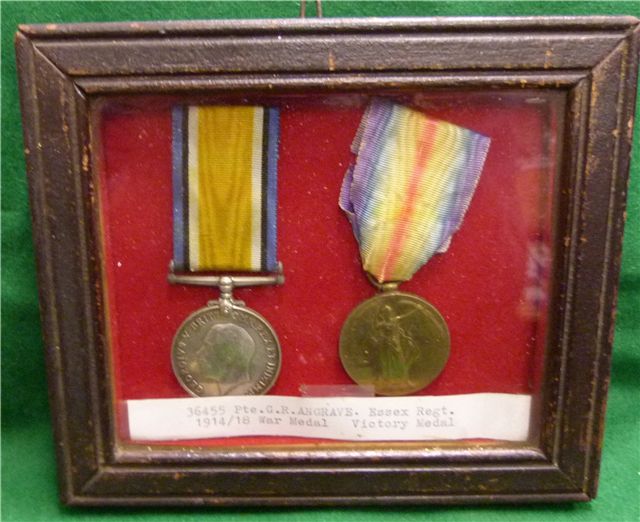 Carillon Collection
|
|
Private 3605 Thomas Edward Angrave |
|
|
D Coy. 1/5th. Leicestershire Regiment. Killed in Action 17th August 1915, Aged 19. (His brother George Angrave also fell see above) |
|
|
Private 3605 Thomas Edward Angrave died of wounds on 17th August 1915, aged 19. Thomas was born in 1896 in Loughborough to George Angrave, a hosiery needlemaker, and his wife Catherine (née Peach). The eldest of six children (the others being George Randall, Wilfred, who died aged three months, Mary, Annie and Elizabeth) Thomas grew up at 38 Paget Street, Loughborough. When Thomas' father George unfortunately died in 1909, the family moved next door to 40 Paget Street and by 1911 Thomas, aged 14, was employed as a student clerk in the hosiery office of the Nottingham Manufacturing Company. Upon the outbreak of World War One, Thomas joined up to the D Coy 1/5th Battalion of the Leicestershire Regiment. After training the 1/5th Battalion landed at Le Havre, France, on 28th February 1915. Thomas was killed in action less than six months later. He was buried at Sanctuary Wood Cemetery, Zillebeke, near Ypres, Grave II. M.19. Following his death Mrs Catherine Angrave received a letter from Lieutenant Mould, sending his condolences on the death of her son Thomas. He wrote: "I am truly sorry that your son met his death during our last tour of the trenches. All the members of the platoon that knew the full value of their brave and loyal comrade feel his loss. He met his death while on sentry duty, the bullet striking him in the head and killing him instantly". Sunday Mass was said at St Mary's Church Loughborough where Thomas Edward Angrave was a regular attendant. The Rev. Father Hart said "a soldier who died doing his duty was a martyr. Such a martyr was surely young Angrave, who laid down his life for the sacred cause of the allies". Thomas Angrave was a relative of diary writer and soldier Alfred Angrave. Thomas' brother George Randall Angrave was killed in Palestine two years later. Both brothers are commemorated on the War Memorial in St. Peter's Church, Loughborough. One of the bells in the Carillon also has the names of the brothers engraved on it - the bell was the gift of the Nottingham Manufacturing Company in memory of all their co-workers who died in the war. |
|
Carillon Collection
|
|
|
Gunner 94598 Walter Armstrong |
|
88 Siege Bty, Royal Garrison Artillery. Died of Pneumonia 3rd November 1918, Aged 34. Buried Etaples Military Cemetery, XLIX. A. 15.
|
|
Walter Armstrong was born in Loughborough in 1885 and baptised on 2nd August 1885 at Holy Trinity Church, Loughborough. He was the son of Herbert Armstrong and his wife Caroline (née Senior) who were married at St. Matthias Church, Sneinton, Nottinghamshire, on 11th April 1880.
When Walter was born his parents were living in King Street, Loughborough, and his father was a groom. By 1891 his parents had moved to 16 Sparrow Hill. They later moved to 6 Duke Street. By 1901 his father had become a carter (carman) of mineral water. Walter had three brothers George, Frederick and John and four sisters Ethel, Clara, Florence and Hannah. Four other siblings had died young. Walter's mother died, aged 48, in 1906 and two years later his father was remarried to Violetta Betts and moved to 2D Chapman Street. Walter trained as a plumber and on Christmas Day 1905 he married Emily Mary Elizabeth Ayres at Holy Trinity Church, Loughborough. At the time of their marriage Walter and Emily were both living in School Street but by 1911 had moved to 4 Fennel Street. By 1911 Walter and Emily had a young son Herbert and Walter had changed his occupation to grocer's warehouse porter. Walter enlisted on 15th December 1915 and gave his address as 2 Fennel Street, Loughborough. During the war Walter's wife moved to 5A Fennel Street. Walter was listed as Army Reserve and mobilised on 29th May 1916. He was sent to No. 4 Depot of the Royal Garrison Artillery, Great Yarmouth, to train as Gunner 94598 and arrived there on 7th June. From 6th-21st July he was in the Military Hospital, Great Yarmouth, suffering from piles. Not long afterwards, on 19th August, he was posted to join the Humber Garrison at Paull Point Battery, near Hull. On 28th November 1916 Walter was posted to join the 280th Siege Battery which had recently been formed at Newhaven. Siege batteries were equipped with heavy howitzers, sending large calibre high explosive shells in high trajectory, plunging fire. The usual armaments were 6 inch, 8 inch and 9.2 inch howitzers, although some had huge railway- or road-mounted 12 inch howitzers. As British artillery tactics developed, the Siege batteries were most often employed in destroying or neutralising the enemy artillery, as well as putting destructive fire down on strongpoints, dumps, stores, roads and railways behind enemy lines. On 18th March 1917 280th Siege Battery left Salisbury for Southampton and embarked for France. On 23rd March the battery left Le Havre by rail and proceeded to Bailleul. Two days later they moved to Erquinghem-sur-Lys. On 19th May the battery moved to a new position near Neuve Eglise. Between 3rd and 7th June the battery was in constant action at Messines Ridge, firing up to 1550 rounds each day. On 11th June the battery suffered a number of casualties from enemy shellfire and Walter was among their number. He was taken to No. 27 Field Ambulance and then to No. 4 Stationary Hospital, Arques, St. Omer, suffering from shell-shock. From 30th June-28th August Walter was in a convalescent depot and then a rest camp, after which he was sent to the Base Depot. He was then posted to No. 88 Siege Battery and joined this unit at Bully-Grenay on 31st August 1917. On 7th September the battery moved to Béthune for seven days rest. After returning to the line the battery spent a day digging new gun pits before moving to a new position on 22nd September. On the following day a Howitzer malfunctioned and killed two gunners. More new gun pits were then dug at Bully-Grenay and also at Liévin. On 24th October the battery left Bully-Grenay and proceeded north to Béthune. On 26th October they moved to G Rest Camp at St. Sixte, north of Poperinghe, before going into action at Tegula Farm. From 30th October 1917 to 22nd January 1918 the battery was in action almost every day and its position shelled by the enemy on a number of occasions. At the end of January and during February the battery was in a rest area but undertook some special firing tasks when required. The war diary of the battery for the remainder of the war has unfortunately been lost but the battery is likely to have been in action in the Battles of the Lys in April 1918 and in the advance in Flanders (August-November 1918). Walter, aged 34, died of pneumonia at No. 56 General Hospital, Etaples, on 3rd November 1918. He was probably another victim of the flu epidemic. He was buried in Etaples Military Cemetery, Grave XLIX. A. 15. |
|
Sergeant 10159 Roland Austin |
|
6th Bn, Leicestershire Regiment. Killed in action 9th June 1916, Aged 25. Buried Bienvillers Military Cemetery, I. A. 3.
|
|
Roland Austin was born in 1891 in Marylebone, London, the son of George Thomas Austin, a cabinet maker, and his wife Rhoda (née Bick), the daughter of a French polisher. Roland's parents were married on 28th April 1889 at St. James's Church, Hampstead Rd, London. Roland had two brothers George and Arthur and four sisters Kathleen, Marjory, Rhoda and Hilda. In 1891 the family lived at 35 Huntley Street, St. Pancras, but by 1901 had moved to 82 Loftus Road, Hammersmith. In 1911 they were living at 70 Loftus Road, but Roland had left home and was earning his living as an assistant chemist to John Thomas Smith, chemist and druggist, at 39 Market Street, Wellingborough, Northamptonshire. By 1914 Roland had moved to Loughborough to be an assistant chemist and dispenser to Mr A. B. Martin of Market Place, Loughborough.
Roland enlisted on 17th August 1914 at Loughborough and was sent to Bordon, Hampshire for training. Initially appointed as Private 10159 to C Company of the 6th (Service) Battalion of the Leicestershire Regiment he was quickly promoted to Lance Corporal on 14th September 1914 and Acting Corporal on 30th November 1914. In April 1915 the 6th Battalion became part of the 37th Division of the Army and concentrated at Cholderton on Salisbury Plain. On 25th June the 37th Division was inspected by King George V at Sidbury Hill. On 22nd July 1915 the Division began to cross the English Channel and by 2nd August all units were concentrated near Tilques not far from St. Omer in the Nord-Pas-de-Calais. Roland embarked for France on 29th July 1915 and was confirmed in the position of Corporal on 29th September 1915. In September Roland's battalion was sent to the area of Berles-au-Bois, south-west of Arras. The battalion remained in this area around Bienvillers and Bailleulmont until July 1916 and was engaged in localised operations seeking a tactical advantage. On 18th February 1916 Roland was appointed Sergeant. Roland was only 25 when he was killed. Sergeant Moffat Ecob of the 6th Battalion of the Leicestershire Regiment wrote a letter to his parents describing the unfortunate deaths of Roland Austin, Frank Benskin, Bertie Newbold and Sidney Wade, all in the 6th Leicesters and all from Loughborough. Ecob had gone out to fetch a working party and on his return found that the dug-out at Saulty (13 miles south-west of Arras) where he had left his four friends had been hit by a shell, blowing it to pieces. All four men had been killed instantaneously. Roland is buried in Bienvillers Military cemetery, Grave I. A. 3. |
|
Private 40106 Matthew Taylor Aves |
|
|
1st Bn, Prince of Wales's (North Staffordshire) Regiment. Formerly 27898 Leicestershire Regiment. Killed in action 31st July 1917, Aged 27. Commemorated Ypres (Menin Gate) panel 55
|
|
|
Matthew Taylor Aves was born in Holborn, London, in 1891. He was the son of Matthew Taylor Aves and his wife Mary Ann (née Freeman) who were married at the Church of St. John the Evangelist, Lambeth, on 21st September 1890. In April 1891 Matthew Taylor Aves Senior and his wife Mary Ann were living at 91 Harrison Street, St. Pancras, London. Matthew Taylor Aves Senior was unfortunately a troubled man. He had deserted from the 20th Hussars on 14th February 1880 and was discharged from their ranks in 1886. After this he had made his living, like his father, as a baker. On 21st August 1891, about the time his son was born and his father also died, he was admitted to the Banstead Asylum, Belmont, Surrey, and died there on 10th April 1892. Matthew Junior disappears from official records until 1911 when he married Edith Batty in Loughborough. Matthew and Edith had two sons George (born 1912) and Matthew (born late 1916 or early 1917). In Loughborough the Aves family lived at 40 Wellington Street. Matthew appears to have enlisted sometime in the late spring of 1916 but as his service papers have not survived his precise date of enlistment is unknown. He joined the Leicestershire Regiment as Private 27898. At some point he was transferred to the 1st Battalion of the North Staffordshire Regiment. In 1917 the 1st North Staffordshires received drafts of reinforcements in February, March, April, May and July and Matthew could have been in any one of these drafts. When the first draft arrived in February the battalion was in training at Busnettes. When the second draft arrived in March the battalion was in the trenches at Calonne where they remained until mid-April with breaks at Bully-Grenay. The third and fourth drafts arrived in late April just before three weeks training began at Reclinghem. On 14th May the battalion moved into the support trenches at Zillebeeke and they were in the front line at Zillebeeke when the largest draft of 65 Ordinary Ranks joined them. At the beginning of June 1917 the battalion was in camp at Hopoutre and in Corps Reserve for the Battle of Wytschaete-Messines Ridge (7th-14th June). The battalion provided carrying parties on the first three days of the battle before being sent to hold and consolidate captured German trenches. For three days they experienced heavy enemy artillery fire before being relieved and moving to a camp near Dickebusch. The remainder of June was spent in front line or support trenches at Mount Sorrel or Battle Wood, or in reserve at Micmac Camp. On 31st June the battalion entrained at Reninghelst Siding for Lumbres and marched to Senighem and then Renescure where they were in training until 19th July. A move back to Micmac Camp followed and two more drafts of men arrived. On 29th July the battalion moved into the reserve trenches prior to taking up battle position and on 31st July went into the attack. 11 officers and 280 Ordinary Ranks, including 27 year-old Matthew, were casualties on this day. Matthew is commemorated on the Ypres (Menin Gate) Memorial, Panel 55. Matthew is also remembered on the Workers' Union Roll of Honour and on the Carillon. Matthew's widow Edith was remarried in 1924 in Loughborough to Francis E. Stubley. Matthew's mother Mary Ann was admitted to the Renfrew Road Workhouse, Lambeth, on 29th June 1922 and what subsequently became of her is unknown. |
|
|
|
|
|
Private 43442 Albert Edward Bacon |
|
2nd Bn. Essex Regiment Formerly 16042 Leicestershire Regiment. Killed in Action 9th August 1917, Aged 22. Commemorated Arras Memorial Bay 7
|
|
Albert Edward Bacon was born in 1895 at 5 Fox Yard, Baxter Gate, Loughborough and baptised on 23rd October 1895 at All Saints Church. He was the eldest child of Henry Bacon and his second wife Mary Elizabeth (née Bates) who were married at All Saints Church on 4th December 1894. Albert's father was a bricklayer's labourer. Albert had one brother Walter and one sister Elizabeth; he also had two older half-brothers from his father's first marriage to Mary Jane Fox who died in 1889. Albert's own mother died in 1903, aged 32, when Albert was only eight. In 1901 the Bacon family lived at 25 Factory Street, Loughborough, but after his father was widowed for the second time he moved firstly to 5 Wheatsheaf Yard and then to 10 George Street. In 1911 Albert was a labourer at Piper House Farm, Long Whatton.
Albert enlisted when war broke out. He first joined the 9th (Service) Battalion of the Leicestershire Regiment as Private 16042 but was subsequently transferred to the 2nd Battalion of the Essex Regiment as Private 43442. As Albert's service papers have not survived his precise date of enlistment and transfer to the Essex Regiment are unknown. It is, however, documented that he was sent to France on 29th July 1915 and it seems likely that he went to France with the 9th Battalion of the Leicesters on that date. The 9th (Service) Battalion was raised at Leicester in September 1914 as part of Kitchener's Third New Army and joined 23rd Division as Divisional Troops. The units of the Division began to assemble at Bullswater and Frensham in Hampshire from September 1914 and the King, Queen and Princess Mary visited the fledgling Division on 29 September. In early December, as the weather worsened, the Division moved into Aldershot and then, at the end of February 1915, to Shorncliffe in Kent. In April 1915 Albert's battalion became part of the newly established 37th Division of Kitchener's 2nd New Army and the Division began to concentrate on Salisbury Plain. On 29th July the battalion travelled from Folkestone to Boulogne on the SS St. Serial and moved initially to Tilques. The battalion then moved via Watten, Houlie, St. Omer, Eecke and Dranoutre to Wulverghem and Bienvillers-au-Bois, a short distance from the front line. In the months that followed the 9th Battalion did tours in the trenches, alternating with the 7th Leicesters who relieved them. They were Involved in operations in Bailleul, Le Bizet, Armentières, Mondicourt, Beauval and Berles-au-Bois. In April 1916 the 9th Leicesters moved to the Doullens area for six weeks for cleaning up, resting and training. In mid-May they returned once more to the trenches in the Bienvillers-Bailleulmont sector. In June there was a series of nightly excursions into No-Man's Land with patrols attempting to gather information on the enemy's dispositions. On other occasions there were working parties out repairing the British barbed wire entanglements. The situation became increasingly hazardous as the month wore on when the Germans began to use a new and more accurate type of trench mortar. On 1st July 1916 the 9th Leicesters moved into position at Souastre in readiness to reinforce the troops attacking at Gommecourt. No orders came, however, and the men marched back to Humbercamps. Training continued on the 4th and 5th July. On 6th and 7th July they marched via Talmas to Crouy and on 8th and 9th July they rested and were addressed by the Divisional Commander on the forthcoming battle. On 10th July they moved to Ailly-sur-Somme and then entrained for Méricourt before going by bus to bivouacs in Méaulte north-east of Amiens. They then took over as Quadrangle Trench and Quadrangle support. On 11th there was heavy shelling but no infantry attack. On 12th July the 9th battalion was relieved and moved back to Fricourt. On 14th July the battalion moved up to the south edge of Mametz Wood just as an intense bombardment of the German positions began, and on to Bazentin-Le-Petit Wood. Finally relieved on 16th July the battalion, which had suffered heavy casualties, marched to Fricourt and on to Ribemont on the following day. On 18th July they entrained at Méricourt for Saleux. After nine days of marching and some motor lorry transit the battalion arrived at Arras on 27th July, where for all of August the battalion was in the trenches or resting in billets at Arras. After some days training and resting at the beginning of September the battalion marched to Frevent and entrained for 'Edgehill' station near Dernancourt. On 16th September the battalion moved to bivouac near Fricourt and after two days moved again to bivouac in front of Bernafay Wood. On 24th September the battalion moved up to the assembly trenches in front of Gueudecourt in preparation for an attack on the following day. From 25th to 28th September the battalion took part in the Battle of Morval and sustained considerable casualties - 12 officers and 274 ordinary ranks. Between October 1916 and June 1917 the 2nd Essex Battalion received large numbers of reinforcements on a number of occasions and Albert might have been in any one of these batches. It is reasonably safe to assume that Albert was with the 2nd Essex by early June 1917. In June 1917 the 2nd Essex Battalion was in training at Mazières. On 10th June the battalion moved by bus to Arras and on 11th June went into the support position at Balmoral Camp, setting up in tents and dugouts. The battalion moved into the front line from 15th until 19th June when they went to Blangy Park camp. Here they remained until 28th June, supplying working parties. The battalion went next into the Reserve position on the south of the River Scarpe to the left of Monchy before moving into the front line from 3rd to 7th July. After being back in the Reserve position from 7th - 10th July the men returned to the front line until 15th of the month when they went back to Blangy Park for re-equipment and training. On 29th July the battalion went into Brigade Reserve and on August 2nd proceeded to Wilderness Camp to practice for an oncoming raid. After returning to the front line on 7th August the raid took place on 9th. The war diary includes the following account: 'Front Line, France 180 men of the Battln plus 30 men of the 2nd Duke of Wellingtons took part in a raid on the enemys front line in conjunction with a large raid made by the 12th Division on our right. The object of the raid was, to capture or kill as many of the enemy as possible and to obtain identifications. The objectives were two portions of the German front line. Zero hour was 7-45 pm, at Zero - 4 minutes the raiding party crawled out on to the ridge in front of our line, at Zero hour they advanced towards the enemy's lines under a creeping barrage which was not very intense. The party soon came under very heavy machine gun fire and in some places the enemy came out of his trenches to meet them and formed a bomb barrage, what remained of the raiding party then had to retire. ' Eighteen Ordinary Ranks were killed in the raid and thirty-eight wounded. Albert, aged 22, was one of those killed. His body was never found and he is commemorated on the Arras Memorial, Bay 7. |
|
Private 4724 Frederick Joseph Bacon |
|
1/5th Bn, Northumberland Fusiliers (Territorial) Killed in Action 1st October 1916, Aged 22. Commemorated Thiepval Memorial Pier and Face 10b, 11b & 12b.
|
|
Frederick Joseph Bacon was born in Long Whatton, Leicestershire, on 10th February 1894 and baptised at All Saints Church, Long Whatton on 25th March 1894. He was the son of John Bacon and his wife Mary Jane (née Pywell) who were married in Leicester in 1877. Frederick had one brother George and five sisters Mary, Sarah, Florence, Ethel and Agnes. Another brother John had died aged eleven in 1903. Frederick was enrolled at Long Whatton School on 25th April 1897. His father ran the Gables Farm of 61 acres in Long Whatton. and by 1911 Frederick was helping his father on the farm.
Frederick's Army Service record has not survived and his date of enlistment is unknown but he joined the 1/5th (Territorial) Battalion of the Northumberland Fusiliers as Private 4724. It is said that he lived in Loughborough before he went to war and enlisted at Leicester. It is unlikely that he went to France and Flanders before 1916 as he was not awarded the 1914/15 Star medal. From January to the end of March 1916 the 1/5th Battalion of the Northumberland Fusiliers was in the trenches in the area of Ypres and being subjected to a considerable amount of artillery fire from the enemy. Occasional breaks were taken in Poperinghe. On 1st April the battalion marched to Locre, a small village in West Flanders, to hold the front there. There was a break in Bailleul, French Flanders, in May, after which the battalion returned to Locre where they remained until late July. On 22nd July the news was received that the battalion would be moving towards Neuve Eglise, Alsace, and they marched to camp at Dranoutre, south of Ypres. The battalion stayed at Dranoutre until 7th August when they marched via Meteren to Strazeele. On 11th August they entrained at Bailleul for Doullens, Somme, and then marched to billets in Candas and Fienvillers. From there they marched to Naours and Pierregot and arrived at Hénencourt on 17th August. A period of training commenced at Hénencourt Wood and continued until 7th September. On 8th September they marched through Albert and went into dugouts at Lozenge Wood. On 10th September the battalion was ordered to take over some more of the front line trenches around Martinpuich which the enemy was attacking with a heavy barrage. On 15th September the Battle of Flers-Courcelette began and Frederick's battalion was in action between High Wood and Martinpuich, having been sent to reinforce an attack by the 1/4th and 1/7th Northumberland Fusiliers. The Battle continued until 22nd September but the 1/5th Northumberland Fusiliers were pulled from the front line on 16th and took up a position in dugouts a little further back. The battalion remained in nearby trenches until the end of the battle. On 25th September the battalion moved even further back from the front to Contalmaison. After two days of providing working parties on the roads the battalion returned to the trenches near Martinpuich on 29th September and were once again under heavy bombardment by the enemy. On 1st October 1916 the battalion was ordered to attack and capture Eaucort l'Abbaye north-west of Martinpuich and during this attack Frederick, aged 22, was killed in action. His body was never found and he is remembered on the Thiepval Memorial Pier and Face 10B, 11B and 12B. Frederick is also remembered on the Memorial Cross, Main Street, Long Whatton. |
|
Drummer 1392 Rowland James Baker |
|
1/8th Bn, Sherwood Foresters (Notts and Derby Regiment) Died at Home 28th September 1914, Aged 22. Buried Newark Upon Trent Cemetery M. C. 299.
|
|
Rowland James Baker was born in Leicester, in 1892 and baptised at the Church of St. Mary de Castro, Leicester, on 9th February 1892. He was the son of John William Baker and his wife Elizabeth Ann (née Richardson) who were married at St. Peter's Church, Leicester, on 23rd October 1887. When Rowland was born his parents were living at 27 Red Cross Street, Leicester, and Rowland's father was a locksmith. Rowland had one brother Peter.
Rowland's mother died in 1894 and in 1899 his father was married again to another Elizabeth (maiden name unknown) who came from Loughborough. In his youth Rowland attended the Loughborough Baptist Church Sunday School. In 1901 the family was living at 9 Macfarline Terrace, Nottingham, and Rowland's father was employed as a machine fitter. The family later moved to 49 Albert Street, Newark, Notts. Prior to enlistment Rowland Baker was a brewer's labourer (1911) and then a storekeeper for Simpson's Ltd (1912). He enlisted on 12 March 1912, and was firstly Private 1392 and then a Drummer in the Sherwood Foresters 1/8th Battalion. After mobilisation at Newark when war was declared the 1/8th Sherwood Foresters marched via Radliffe-on-Trent to Derby and entrained for Luton on 15th August, 1914. On 21st August they moved to Harpenden and began a period of training. Rowland died in hospital in Luton, aged 22, just over one month later on 28th September 1914. Rowland was buried in Newark upon Trent Cemetery, Grave M.C. 299. Rowland is commemorated on the War Memorial at Baxtergate Baptist Church, Loughborough. |
|
Private 267052 John Ball |
|
Killed in Action 1st July 1916, Aged 27. Commemorated Thiepval Memorial, pier and face 10 C, 10 D, and 11 A. |
|
John Ball was born in Loughborough in the early summer of 1889 and baptised on 2nd July 1889 at Emmanuel Church, Loughborough. He was the son of Thomas Edgerton Ball and his wife Jane (née Daniels) who were married at Loughborough Register Office on 4th February 1882.
John's father was a cabinet maker, joiner and wood polisher. Between 1891 and 1911 the Ball family lived in South Street, Loughborough, firstly at No. 1 and then at No. 3. John had five brothers Thomas, Arthur, Fred, and Edward, and four sisters Edith, Ellen, Alice and Clara. Another sister Sarah died aged one. By 1911 John was also a wood polisher. After his father died in 1911 John also became a cabinet maker. On 30th May 1914 he married Florence May Hill at All Saints Church, Loughborough. At the time of his marriage he was living at 11 Edward Street, Loughborough. John's service record has not survived but it appears that he enlisted at Nottingham fairly early on in the war. He joined the 1/7th (Robin Hood) Battalion of the Sherwood Foresters (Notts and Derby Regiment) as Private 5708 (later renumbered as 267052). His medal record indicates that he was not sent abroad until 1916. On 7th January 1916 the battalion was sent to Parc Borély, Marseilles, to prepare for a departure to Egypt. On 11th January a draft of 26 men joined the battalion from the Base Depot of the 46th Division and John may have been among this draft. On 13th January the battalion moved to a camp at Chateau Mussot and remained there until 25th January. The projected departure for Egypt, however, was aborted and on 27th January the battalion entrained at the Gare d'Arenc for a two-day journey to Pont Rémy. From Pont Rémy they marched to billets at Domqueur. On 10th February they moved to billets in Prouville and Forceville. At the end of February the battalion made various moves to Valheureux, Louvencourt, Fieffes, Bermeuil and Beauval. On 1st March A and C Coys proceeded to Gezaincourt and on 6th March the whole battalion moved to Beaudricourt. On 7th March they travelled by bus to Mont St. Eloi, proceeding on foot from there to the trench lines near Neuville St. Vaast and Souchez. On 8th March they moved to huts at Acq and on 9th to the trenches at Boyan Cassalle. The battalion remained here throughout April, with breaks at Mont St. Eloi, Doffine and Penin. In early May there were digging parties at Humbercamps and in late May trench tours at Foncquevillers. Practice attacks and working parties at Bienvillers followed in June until the battalion moved up to the front line at Foncquevillers in preparation for the first day of the Somme Offensive on 1st July. In the attack at Fonquevillers on 1st July 1916 the battalion sustained 424 casualties. John was one of those killed in action. John's body was never found and he is remembered on the Thiepval Memorial, Pier and Face 10 C, 10 D, and 11 A. He was aged 27. John's widow was remarried on 22nd December 1917 at All Saints Church, Loughborough, to Joseph Needham, a widowed soldier. |
|
Sapper 145711 Roland Banks |
|
123rd Field Coy, Royal Engineers Died at Home 27th June 1919, Aged 22. Buried Loughborough Cemetery 48/107. |
|
Roland Banks was born in Loughborough on 26th January 1897. He was the son of Arthur Banks, a needle maker, and his wife Charlotte (née Steer) who were married at Emmanuel Church, Loughborough, on 9th July 1887. Roland had one brother Arthur and two sisters Winifred and Jessie.
In 1899, when Roland was two, his father died. His mother then moved the family from 18 Oxford Street, Loughborough, to 16 Havelock Street and supported the family by working as a charwoman. By 1911 Roland's mother was working as a housekeeper for her elderly widowed mother Sarah Steer and the family was living with Sarah at 16 Chestnut Street. In 1911 Roland was aged 14 and apprenticed as a blacksmith at the Brush electrical engineering works. He attended the Wesleyan Methodist Church and between 1911 and 1915 became a member of the Independent Order of Oddfellows. Roland enlisted in Loughborough on 25th November 1915. A reference described him as a 'smart, active and intelligent youth'. He was counted as Army Reserve and mobilised on 2nd March 1916. He became Sapper 145711 and was posted to the Chatham depot of the Royal Engineers. On 5th May 1916 he was sent to No. 5 Depot of the Royal Engineers at Deganwy, Conwy, Wales. On 3rd August 1916 Roland was posted to the Base Depot in France and on 16th August he joined 123rd Field Company of the Royal Engineers. The company was with the 38th (Welsh Division) of the Army and was building ammunition sheds at Caestre, Strazeele and Abeele. On 22nd August the company was ordered to march to dugouts north of Ypres and work on gun and trench mortar emplacements for the Royal Field Artillery. For most of September they worked on strongpoints and screening of the Ypres to Elverdinghe road. From October to mid-December they were busy with trench reclamation work on the front line, repairing tramways, and constructing artillery and gun emplacements and dugouts on the Canal Bank as well as horse standings at Peselhoek. On 11th December they moved to Boesinghe for work on the front line on the west bank of the Yser Canal. On 27th December 1916 Roland lost his gumboots and was charged for their replacement. On 30th December the company entrained at Poperinghe for Watten. At Watten they undertook training until 11th January 1917. While at Watten Roland was deprived of one day's pay for neglecting to clean his ammunition. On 12th January 1917 the company moved by rail to the Canal Bank west of Ypres. Based here until 28th May they worked on trench reclamation, tramway maintenance, gun emplacements, strong points, electrical installations and Canal Bank defences. From 29th May until 12th June the company was in training at Watten before returning to the Canal Bank to work on dugouts and the water supply. Here they were shelled by the enemy. From 1st-21st July the company was working on the west bank of the Yser Canal digging trenches and a tunnel, building dugouts and ensuring a water supply. In August and for the first nine days of September, after extending a tramline to the Pilckem road, the company moved to Cardoen Farm, Woesten, to work on roads and mule tracks, erect two bridges over the River Steenbeck and clean the river and to lay duckboard tracks from Pilckem road to Langemarck station and at Ondank. Work was twice delayed by heavy enemy barrages of high explosive and gas shells. On 10th September the company marched to Salem Camp near Crombeck for a rest. Roland was granted leave to England from 14th to 24th September and he rejoined the company at Erquinghem. In October and part of November the company was based at Erquinghem Laundry while working on roads and drains at Bois Grenier, and constructing dugouts and erecting elephant shelters for the machine gunners. They also prepared and fired Bangalore torpedoes at the enemy's wire and prepared a land mine for the 113 Infantry Brigade. On 21st November they moved to the jute factory in Armentières to work on drainage, emergency tracks and screening, trench mortar emplacements, repairs to the water supply at Bois Grenier, and a new firing range for the 113 Infantry Brigade. On 29th December they moved to Fort Rompu to work on new horse lines. In mid-January 1918 the company proceeded to La Haye Farm near Pont de Nieppe to carry out concrete work, trench wiring and erect steel shelters. During March they supervised trench wiring and digging by the infantry. On 1st April they marched to Merville station, entrained for Mondicourt and marched to Toutencourt. They then proceeded to Warloy to mark out and dig the corps line from Baizieux Mill to the Warloy-Hedauville road. On 11th April they moved to Senlis to link up and wire the support line, prepare a visual and signal station, dugouts, shelters and a machine gun emplacement on the Baizieux-Forceville line. April ended with a week's training at Toutencourt. During May the company was camped near Harponville for work on a communications trench by Martinsart Wood, wiring near Bouzincourt, constructing dugouts and steel shelters, and removing fallen trees near the Warloy-Hedauville road. From 20th May to the 4th June there was training at Toutencourt and from 5th June - 18th July there was trench and wiring work at Engelbelmer and Forceville. The company then moved to Hedauville for training and to prepare the ground for the Divisional horse show. In early August they constructed a railway bridge and another bridge on the east side of the River Ancre. On 22nd August they were asked to assist troops in crossing the River Ancre. This included carrying 400 cork rafts over wire entanglements and shell holes and working on a bridge and crossing at Authville for infantry and field guns. They also worked on the approach roads to the railway crossing and up to the Aveluy-Thiepval road. On 31st August they moved to Longeval to repair the Longeval-Ginchy road and on 3rd September to Sailly-Sallisel to repair the road to Manancourt and strengthen several bridges. Between 12th and 18th September the company was working east of Léchelle on dugouts and the forward roads. Five days training began on 22nd, after which the company moved to Heudicourt in order to complete track work and to prepare a Divisional reception camp at Sorel-le-Grand. The enemy was now in retreat and the company erected a large bridge over part of the Hindenburg Line, repaired a bridge over the River Escaut and made good roads and tracks for the advancing troops. On 11th October the company moved to Selvigny. From 13th -27th October Roland was allowed leave to England. He rejoined his unit at Poix du Nord where it was repairing wiring amid hostile shelling and clearing roads. The company was at Laval when the Armistice was declared and was sent to Aulnoye to do salvage work. On 1st December they moved by route march and train to Franvillers and supervised work by German prisoners of war. On 17th December a workshop was started at Warloy for making furniture. In January 1919 demobilisation began. Roland was released on 22nd January and proceeded to Harrowby in Lincolnshire, where the demob process was completed. He returned to Loughborough on 24th February. In June he contracted pneumonia and died at home of an embolism on 27th June 1919. He was 22 years old. Roland was buried in Loughborough Cemetery, Grave 48/107. |
|
Private 21737 Albert Barker |
|
C Coy. 7th Bn. Leicestershire Regiment Killed in Action 21st May 1916, Aged 30.
|
|
Albert Barker was born in 1885 in Loughborough, the son of Elias Barker, a framework knitter from Belper, Derbyshire, and his first wife Alice (née Lakin). Albert's parents were married in Loughborough in 1870 and Albert had five brothers William, Alec, Joseph, James and Arthur and one sister Mary. In 1881 the family was living at 4 Rectory Place, Loughborough, but by 1891 had moved to 54 Cambridge Street. After Albert's mother died in 1899 his widowed father moved with Albert, James and Arthur to 3 Holland Street. In 1902 Albert's father was remarried to Mary Ellen Hudson and in 1904 Albert acquired a half-sister Dorothy. His father and step-mother moved to 7 Moira Street and Albert became an iron moulder. On 27th December 1909 Albert himself was married to Ann Turner at St. Peter's Church, Leeds. Albert and Ann initially lived with Albert's sister Mary (Mrs. Pepper) and her husband John and family at 9 Cobden Street but later moved to 3 Thomas Street. Albert and Ann had three children: Ada (born 1910), Arthur (born 1912) and Harold (born 1913). One source states that Albert enlisted in Loughborough, with no date given, another that he enlisted on 28th September 1915 at Barnard Castle, County Durham. Loughborough as the place of enlistment seems rather more likely though certainly some men of the Leicestershire Regiment were at Barnard Castle in the autumn of 1915. As Private 21737 Albert joined C Coy of the 7th (Service) Battalion of the Leicestershire Regiment. What is certain is that Albert entered the theatre of war in France on the 29th December 1915. At that point the 7th Leicesters were involved in various trench warfare activities in the area of Arras. The freezing weather of January 1916 made life doubly difficult and in February they were required to take over extra trench areas vacated by the French who were concentrating every effort at the Battle of Verdun. These new trenches eventually included those in front of Bailleulment to the left of existing positions and to the right as far as far as Hannescamps. At the same time the enemy redoubled their efforts in shelling Berles-au-Bois. When not in the trenches the 7th Leicesters received intensive training in bombing, Lewis gunnery, visual signalling and a host of other activities. In April they were moved to the Doullens area and formed working parties to cut down trees and prepare brushwood for the front line as well as repairing the support trenches in the area. In May they worked on building a new railway line between Le Bret and Bienvillers au Bois. Those not building the railway were in the trenches. On 21st May 1916 the 7th Leicesters were repairing the support line at Bienvillers when some trench mortar bombs fell in the right half of the battalion's line. Three men were killed, including Albert, and four were wounded. Albert was aged only 30 when he was killed. Albert is buried in Bienvillers Military Cemetery, Grave I. A. 38. His widow later moved with their children back to her home town of Leeds and settled at 54, Lower John Street, Bramley, Leeds, Yorkshire. |
|
Private 265187 Albert Ernest Barker |
|
1/7th Bn, Sherwood Foresters. (Notts & Derby Regt). Died of Wounds 16th October 1917, Aged 21. (His brother Reginald Horace Barker also fell see below) |
|
Albert Ernest Barker was born in Loughborough in late 1896, the son of John Thomas Barker and his wife Annie (née Clowes). Albert's parents were married on 27th June 1894 at St. Bartholomew's Church, Quorn, and Albert had two brothers Reginald and Arthur. Another sibling had died in infancy. In 1901 the Barker family lived at 72 Fisher Street, Nottingham and Albert's father was a grocer. By 1911 the family had moved to 40 Leopold Street, Loughborough, and Albert's father was now a master baker, with his wife Annie assisting in the business. Albert meanwhile, aged 14, was a house painter's assistant. The family later moved to 22 Mona Street, Beeston, Nottinghamshire. Albert enlisted in 1916 and joined the 1/7th Battalion of the Sherwood Foresters (Notts & Derby Regiment). His service papers have unfortunately not survived and the precise dates of his enlistment and posting to France are therefore unknown. The 1/7th Battalion at Souastre received a batch of 102 reinforcements from the base at Calais on New Year's Day 1917, however, and it is possible that Albert was among them. According to a hospital record, however, in September 1917 Albert had been with the battalion in the field for six months. This would place his arrival in France in March 1917 and according to the battalion's war diary 49 reinforcements joined the battalion on 18th March 1917 at Souastre. From January to mid-March 1917 the battalion remained on trench tours at Fonquevillers with breaks at Souastre before being sent to Nedonchelle and then to billets at Fosse Calonne, a mining village west of Lens, for road work. At the end of April they went into the front line in the Lievin sector and May was spent in the support line in the Loos St. Pierre sector, trench digging. In June 1917 the battalion was in the front and support lines at Lievin, Bully-Grenay, and at Loos St. Pierre where they incurred 45 casualties from enemy gas bombs. On the night of the 29th/30th June the battalion moved forward in a surprise attack on the enemy in the Lievin Sector and sustained about 40 casualties. The battalion spent most of July at Chelers, east of St. Pol, resting, in training and undergoing inspections before moving into Brigade support at Philosophe, near Vermelles, on 24th July. At the beginning of August they were draining trenches amid enemy shelling in the St. Elie sector. Back in Brigade support the battalion provided working and carrying parties and practised tactics for a raid. After another trench tour at St. Elie the battalion marched to Drouvin and then Vaudricourt. The rest of the month was spent in training at Hesdigneuil and Fouquières. The battalion returned to the front line trenches in the Cambrin sub-section at the beginning of September. Here the men experienced three days of very heavy enemy bombardment. On 2nd September Albert was admitted to No. 4 Stationary Hospital with a fever of unknown origin but was discharged three days later and rejoined his battalion. Relieved on 7th September the battalion moved into Brigade support at Annequin. Back in the Cambrin trenches on 13th September they were visited by a correspondent of the Nottingham Guardian. Following a move to Mazingarbe on 23rd September they underwent further training including wiring practice, played recreational football and attended a Divisional concert-party by The Whizz-Bangs in the hall of Mazingarbe brewery. On 28th September the battalion went into the trenches in the Hill 70 sector, not far from Lens. On the night of the 4th/5th October while the battalion was being relieved the enemy attempted a raid and Albert was severely wounded. He died from his wounds, aged 21, on 16th October 1917. Albert's mother received a letter from the Captain of Albert's Company which said: 'When I took command of the company I realized what a fine straight boy your son was. I was wounded the same night that he was and were both sent to the same hospital. Whilst he was here I visited him frequently, every day. The boy was very ill when he arrived here, but he was so brave and cheerful time. All my sympathy goes out to you, he was such a brave lad. You must always remember he lived each day like he died a very brave and gallant Englishman'. Albert was buried in Lapugnoy Military Cemetery, Grave VI. A. 15. His brother Reginald was killed in action the previous June. |
|
Sergeant 265254 Reginald Horace Barker |
|
1/7th Bn, Sherwood Foresters. (Notts & Derby Regt). Killed in Action 29th/30th June 1917, Aged 22. Commemorated Arras Memorial Bay 7. (His brother Albert Ernest Barker also fell see above) |
|
Reginald Horace Barker was born in Loughborough in 1895, the son of John Thomas Barker and his wife Annie (née Clowes). Reginald's parents were married on 27th June 1894 at St. Bartholomew's Church, Quorn. Reginald had two brothers Albert and Arthur. Another sibling had died in infancy. In 1901 the Barker family lived at 72 Fisher Street, Nottingham and Reginald's father was a grocer. By 1911 the family had moved to 40 Leopold Street, Loughborough, and Reginald's father was now a master baker, with his wife Annie assisting in the business. Reginald, meanwhile, aged 15, was a printer's apprentice at the Echo Works in Loughborough. The family later moved to 22 Mona Street, Beeston, Nottinghamshire.
Reginald was a Private with the 1/5th Leicestershire Territorials and was mobilised in August 1914 as Private 1944. He transferred to the 1/7th (Robin Hood) Battalion of the Sherwood Foresters (Nottinghamshire and Derbyshire Regiment) as Private 265254 and at some point was promoted to Sergeant. The Robin Hood Battalion moved on mobilisation to Harpenden and then in November 1914 to Bocking, Braintree, Essex. On 25th February 1915 the battalion left Southampton for Le Havre. They entrained at Le Havre for Cassel and marched to Reweld before moving to Ploegsteert for trench instruction. Part of March was taken up with additional training before the battalion moved into the trenches at Lindenhock on 4th April. Further trench tours at Lindenhock and Kemmel followed, with rest periods at Locre. On 20th June the battalion marched to Vlamertinghe and provided trench support at Sanctuary Wood and in July on the Hooge trench line they experienced the German liquid fire attack. From 25th August to 28th September the battalion did trench tours south of Verbranden- Molen, with rest periods at Busseboom. On October 1st they entrained for Fouquereuil, marched to Hinges and began trench tours on the Hulluch-Vermelles Road. On 13th October they took part in the attack on the Hohenzollern Redoubt, after which they moved to Druvin, Gosnay and Béthune. In November they did trench tours at Richebourg-St.-Vaast before moving to Robecq, Boesghem and St.Isbergues in December. On 7th January 1916 the battalion was sent to Marseilles but the projected departure for Egypt was aborted. The battalion returned to Pont Rémy and was back in the trenches at Boyan Cassalle by 9th March and throughout April, with breaks at Mont St. Eloi, Doffine and Penin. In early May there were digging parties at Humbercamps and in late May trench tours at Foncquevillers. Practice attacks and working parties at Bienvillers followed in June until the battalion moved up to the front line at Foncquevillers in preparation for the first day of the Somme on 1st July. The battalion sustained 424 casualties in the attack on 1st July and was withdrawn to Bienvillers on the same day into Divisional Reserve. The battalion remained in reserve at Saulty, Bellacourt and Bailleulval until the end of July when the men returned to the trenches at Bretencourt. Further trench tours at Bretencourt took place, with breaks at Bailleulval and Bellacourt, until the end of October. From 3rd until 22nd November there was training at Conteville and Noyelle before the battalion was sent to clean up the village of Warluzel. In December the battalion was back on trench tours at Fonquevillers where the enemy was very active before a Christmas break was taken at Souastre. From January to mid-March 1917 the battalion remained on trench tours at Fonquevillers before being sent to Nedonchelle and then to billets at Fosse Calonne, a mining village west of Lens, for road work. At the end of April they went into the front line in the Lievin sector and May was spent in the support line in the Loos St. Pierre sector, trench digging. In June 1917 the battalion was in the front and support lines at Lievin, Bully-Grenay, and at Loos St. Pierre where they incurred 45 casualties from enemy gas bombs. On the night of the 29th/30th June as the battalion moved forward in a surprise attack on the enemy in the Lievin Sector Reginald, aged 22, was killed by an enemy sniper while leading his platoon. Reginald's body was never recovered. He is commemorated on the Arras Memorial Bay 7. He is also commemorated on the memorial in St. John the Baptist Church, Beeston, on the Nottingham County Council Roll of Honour, and on the Carillon. It is understood that shortly before he died, Reginald had received instructions to return to England in order to take a commission. Reginald's brother Albert who was also in the same regiment sent the news to his father. Albert died of wounds on 16th October 1917. |
|
Private 015173 Harold George Barker |
|
39th Ordnance (light) Mobile Workshop, Royal Army Ordnance Corps. Died 7th July 1919, Aged 25. Buried Kantara War Memorial Cemetery, Egypt, C. 71.
|
|
Harold George Barker, known as 'Harry' to his family and friends, was born in 1893 in Leicester. He was the son of George Barker and his wife Emma (née Nottingham) who were married in Quorn in late 1888 or early 1889. Harry was the only surviving child of the marriage.
In 1901 the Barker family was living at 83 Down Street, Leicester, and Harry's father was a hosiery framework knitter. By 1911 Harry's parents had moved to 24 Downing Street, Leicester, but Harry was no longer living at home. He was a boarder with the Beet family in Station Road, Quorn, and employed as a loom fitter. Harry's service papers have not survived but his service number of Private 015173 in the Army Ordnance Corps indicates that he enlisted in late 1915 or early 1916. The Army Ordnance Corps (AOC) was a corps of the British Army. It dealt with the supply and maintenance of weaponry, munitions and other military equipment to the troops. The AOC was transformed by the First World War because of the scale of the war and the increasing technical complexity of equipment. The depots at Woolwich, Weedon and Pimlico were supplemented by the wholesale takeover of warehouses throughout the country and in early 1915 a depot was established at Didcot to be the major focus for the receipt and distribution of AOC stores. Ammunition storage was also expanded dramatically and the former peacetime magazines at places such as Portsmouth and Plymouth were supplemented by purpose built depots at Bramley, Altrincham, Credenhill and Didcot. On the Western Front a highly successful logistic infrastructure, largely rail based, was created to support the front. Parallel systems, but of less complexity, supported operations in Italy. Other expeditions such as Gallipoli, Salonika, Palestine and Mesopotamia brought supply challenges and large logistic bases were established in the Egyptian Canal Zone and at Basra. The Corps was renamed as a Royal Corps in 1918. It is not known when Harry was sent to Egypt but it may have been after his marriage in Leicester to Maggie Pervin from Loughborough in the autumn of 1917. In Egypt Harry joined the 39th Ordnance (Light) Workshop of the AOC. He died in Egypt, aged 25, on 7th July 1919 and was buried in Kantara War Cemetery, Grave C. 71. The cemetery is on the east side of the Suez Canal 30 kilometres north of Ismailia. Harry is remembered on the memorial at Baxtergate Baptist Church, Loughborough. Harry's widow, who lived at 22 Clifford Road, Loughborough, married George S. Wesson in Loughborough in 1920. In 1939 George Wesson was a club steward for the British Legion and Maggie was a khaki weaver. |
|
Private 4628 George William Barnett |
|
|
2/8th Bn, Sherwood Foresters (Notts & Derby Regt). Killed in Dublin Ireland, 27th April 1916, Aged 23. Buried Eastern Health Board Grounds, Kilmainham, County Dublin.
|
|
|
George William Barnett was born on 8th March 1893 in Wymeswold, Leicestershire, the son of William Barnett and his wife Kate Elizabeth (née Smith) who were married in the Loughborough area in 1893 just prior to George's birth. George had two brothers John and Walter; another brother James had died as an infant. George's father who started out as an electric winder's labourer became an iron sawyer for Herbert Morris Ltd crane builders of Loughborough. In 1901 the Barnett family lived at 3 Court G, Baxter Gate, Loughborough but by 1911 had moved to 21B Factory Street and from thence by 1915 to 79 Cobden Street. In 1911 George was employed as a shop assistant for a tea and provision merchants and still living at home. He attended the Baptist Church. George attested on 20th December 1915 at Newark, Nottinghamshire, where he was now working as a shop assistant and living at 14 Sydney Street. He joined the 2/8th Battalion of the Sherwood Foresters (Notts and Derby Regiment) as Private 4628 and was mobilised on 25th January 1916. He was sent for basic training at Watford. Most of George's battalion were still unfamiliar with their weapons and had not yet had live firing practice when in April 1916 they were pulled out of Watford with the 2/5th, 2/6th and 2/7th Battalions and sent to quell the Irish rebels of the Easter Uprising in Dublin. The men were only equipped with Lee-Enfield rifles and bayonets; they had no hand grenades. At Watford each battalion had been provided with two Lewis machine guns each capable of firing .303 calibre bullets at a rate of up to 600 rounds per minute. At Liverpool, however, a loading officer made the grave error of insisting they left the Lewis guns behind. The Rebels under the command of Éamon de Valera were, in contrast, well-trained, well-equipped and on home ground. On 26th April the Nottinghamshire battalions (2/7th and 2/8th) were ordered to march through the centre of Dublin while the Derbyshire battalions (2/5th and 2/6th) were to march round the city and enter from the west. The Nottinghamshire battalions were caught in merciless crossfire in the area of Mount Street Canal Bridge and Northumberland Road and suffered numerous casualties. On the following day the 2/7th and 2/8th battalions were detailed to escort a consignment of ammunition to the Royal Hospital in Kilmainham, Dublin. Forcing their way through sniper fire they approached the South Dublin Union. As they came in sight rifle fire erupted from the Nurses' Home which, unknown to them, was held by members of the 4th Battalion of the Irish Volunteers. The Foresters attempted a frontal assault on the building but suffered casualties as they were repulsed by heavy fire and the battle for the Nurses' Home, both inside it and in the grounds, continued until the late evening. The 2/7th and 2/8th Battalions of the Foresters lost over two hundred men killed or wounded at Mount Street on 26th April and at the South Dublin Union on 27th April. George William Barnett, aged 23, was one of those who lost their lives on 27th April. He is buried in a collective grave with the grounds of the offices of the Eastern Health Board, Kilmainham, Dublin, Republic of Ireland. |
|
| The image to the left shows the resting place of 5 British soldiers and 2 Irish Volunteers killed during the 1916 Easter Uprising. The graves are situated in the grounds of what used to be part of Dr. Steeven's Hospital across the road from Heuston Station, Dublin. | |
|
Private 14739 William Barnett |
|
|
4th Bn, Coldstream Guards. Died of Wounds 11th December 1915, Aged 22. Buried Longuenesse (St Omer). II. D. 17.
|
|
|
William Barnett was born in Wymeswold, Leicestershire, on 22nd February 1893. He was the son of Isaac Barnett and Sarah Barnett (née Basford) who were married in the Loughborough area in 1874. William had five brothers Edward, Robert, Thomas, John and Isaac and three sisters Hannah, Mary and Martha. William's father Isaac Senior was initially an agricultural labourer and shepherd at St. Maur Farm, Burton on the Wolds but by 1901 he had become a waggoner and the family had moved to Walton Road, Prestwold. When William's mother Sarah died in early 1911 his father moved to 28 Judges Street, Loughborough. As his father had been William himself was now a farm labourer. William enlisted in January 1915 and joined the 4th (Reserve) Battalion of the Coldstream Guards as Private 14739. In July 1915 the 4th Battalion (Pioneers) of the Coldstream Guards was raised at Windsor from this Reserve Battalion. William was sent to France with the 4th Battalion (Pioneers) on 15th August 1915 to join the Guards Division. At St. Omer training was then begun in earnest for the forthcoming Battle of Loos. The Pioneers, picked for their stamina and strength particularly with a pick and shovel as well as fighting capability, supported all the other Guards battalions arriving at Lone Tree near Loos as the vanguard. During the Battle of Loos they remained in support and it is clear that other Guards companies that took high casualties were then strengthened by men such as the 4th Battalion Coldstream Guards Pioneers. At the beginning of November 1915 the Pioneers were ordered north to the front around Laventie and moved to a new position in trenches near Neuve Chapelle. Here while employed in tunnelling and mining they were subjected to artillery bombardments by the enemy. William died of wounds at Laventie on 11th December 1915, aged 22. He is buried at Longuenesse, St. Omer, Grave II.D.17. His father died at 8 Cradock Street, Loughborough, two weeks before William died. |
|
|
Private 23863 Charles Ernest Barrett |
|
|
2nd Bn. Leicestershire Regiment. Killed in Action 9th March 1917, Aged 20. (His brother Walter Barrrett also fell see below) |
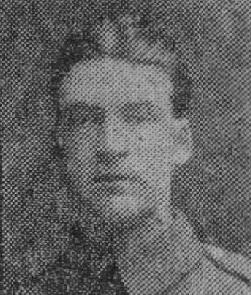 |
|
Charles Ernest Barrett was born in 1896 in Loughborough, the son of Charles Barrett and Sarah Barrett (née Watson) who were married in Loughborough in 1893. Charles had two brothers Walter and George, one sister Florence and one half-sister Nellie. Charles was only three when his father died, aged 26, and in 1901 Charles was living with his mother, his aunt Elizabeth Watson, and siblings at 121 Meadow Lane. In 1906 Charles's mother married George Russell, a machine painter for an electrical engineering company. The family then moved to 2 Freehold Street and by 1911 Charles, aged 14, was a grocer's boy. Over the next four years Charles progressed to being a grocer. He also held a position with the Working Men's Industrial Society, Pinfold Gate. Between 1914 and 1915 Charles's family moved to 42 Freehold Street.
Charles enlisted at Loughborough on 19th June 1915 and joined the 10th (Reserve) Battalion of the Leicestershire Regiment as Private 23863. He was sent to Barnard Castle, Co. Durham and then in November 1915 to Rugeley Camp, Cannock Chase, Staffordshire to complete his training. On 8th March 1916 Charles married Alice Vivien Willday [or Wilday] at St. Bartholomew's Church, Quorn. In May 1916 he was posted to the 2nd Battalion of the Leicestershire Regiment in Mesopotamia and on 14th May he embarked at Devonport on the H.T. Llandovery Castle. He arrived in Basra on 15th June and, having travelled up the Tigris, joined his battalion in the field on 8th July. The Tigris Corps which had recently occupied the Dujaila Redoubt south of Kut was keeping a close watch on the Ottoman forces. The intense heat from June to August, however, caused a heavy toll from sickness and disease among the troops. Charles had only been with his battalion for three weeks when he fell ill and was taken to hospital where he remained for a week. He rejoined his battalion on 7th August only to be sent to hospital again on 29th August. He was not back with his unit until 28th January 1917. Charles's daughter Gladys was born on 27th September 1916 but it is unlikely that he ever saw her. As the heat lessened in September and October 1916 the enemy had raised its activities in sniping and bombing from the right bank of the Tigris. In December the Tigris Corps had begun a long offensive operation with the purpose of dislodging the enemy from the right bank position and severing the enemy's communication channels. By 18th December the Tigris Corps had extended their grip on the Turkish defences and had cut in opposite Kut between the outer Turkish defences and the west of the Hai, while simultaneously bombarding Sannaiyat. By the end of February 1917 Kut had been reoccupied by the Tigris Corps and the final push towards Baghdad began. On 4th March Charles's battalion marched to Shargy and on the following day to Azizieh. Bawi was reached on the morning of the 8th March and the battalion was ordered to proceed towards Baghdad on the night of the 8th March. A halt was made at 6.00am on 9th at the Shawa ruins and one hour later the enemy began to shell the advancing troops. Charles was killed in action on 9th March 1917, aged 20. Charles is commemorated on the Basra memorial, Iraq, Panel. 12. His brother Walter who was with the 6th Battalion of the Leicestershire Regiment had been killed on the Somme in September 1916. Charles's widow Alice, who remained in Leicester Road, Quorn, was remarried in 1927 to William H. Preston in Quorn. |
|
|
Private 10252 Walter Barrett |
|
|
6th Bn, Leicestershire Regiment. Died of Wounds 23rd September 1916, Aged 22. Buried Heilly Station Cemetery, Somme, IV. E. 78. (His brother Charles Barrett also fell see above) |
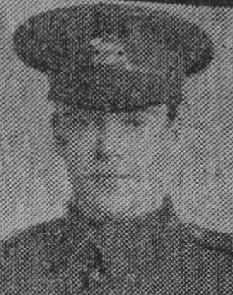 |
|
Walter Barrett was born in Loughborough in 1894, the son of Charles Barrett and Sarah Barrett (née Watson) who were married in Loughborough in 1893. Walter had two brothers Charles and George, one sister Florence and one half-sister Nellie. When Walter was six his father died, aged 26, and in 1901 Walter was living with his mother, aunt Elizabeth Watson, and siblings at 121 Meadow Lane. In 1906 Walter's mother married George Russell, a machine painter for an electrical engineering company. The family then moved to 2 Freehold Street and by 1911 Walter, aged 16, was a woodworker in an electrical car business. By 1914 Walter had become a boiler maker for H. Colman and Son of Meadow Lane, Loughborough. Between 1914 and 1915 Charles's family moved to 42 Freehold Street.
Walter enlisted on 18th August 1914 at Loughborough and joined the 6th (Service) Battalion of the Leicestershire Regiment, part of Kitchener's First New Army, as Private 10252. He was sent to Bordon, near Aldershot, Hampshire where the emphasis was on individual training, squadron and platoon drill. In March 1915 the battalion went into billets in Liphook. In April 1915 the 6th Battalion became part of the 37th Division of the Army and concentrated at Cholderton on Salisbury Plain. On 25th June the 37th Division was inspected by King George V at Sidbury Hill. On 22nd July 1915 the Division began to cross the English Channel and by 2nd August all units were concentrated near Tilques not far from St. Omer in the Nord-Pas-de-Calais. Walter arrived in France on on 30th July 1915. In September Walter's battalion was sent to the area of Berles-au-Bois, south-west of Arras and near the front line. In the months that followed the 6th Battalion did tours in the trenches, alternating with the 8th Leicesters who relieved them. The battalion was engaged in localised operations seeking a tactical advantage and remained in the area around Bienvillers and Bailleulmont until July 1916. On 1st July 1916 the 6th Battalion moved from Saulty to Humbercamps, where it was held in reserve for the Somme Offensive which had just begun. On 6th July the battalion marched to Talmas to join the Army's 21st Division. From 7th to 10th July the battalion was in Hengest-sur-Somme, and from there on 10th marched to Ailly, entrained for Méricourt, took buses to Méaulte, and then proceeded to Fricourt. Between 14th and 17th July the battalion took part in an attack on and successfully captured Bazentin-le-Petit Wood and village. On 20th July the battalion entrained at Ribemont and detrained at Saleux, after which they marched to Hengest. Travelling part of the way in lorries and part of the way on foot they reached Arras on 27th July and relieved the 8th Leicesters in the trenches on 7th August. The remainder of August was spent in the trenches and in billets in Arras. On 4th September the battalion left Arras for Liencourt and after a week there for training moved to Fricourt and Bernafay Wood, east of Montauban-de-Picardie. Here from 19th to 24th September the men were employed in the improvement of communication and support trenches. It is not known when Walter was wounded but he died from his wounds, aged 22, in No. 30 Casualty Clearing Station on 23rd September 1916. Walter was buried in Heilly Station Cemetery, Méricourt-l'Abbé, Somme, Grave IV. E. 78. His brother Charles who also served with the Leicestershire Regiment died in Mesopotamia in March 1917. |
|
|
Private 13296 George Barson |
|
3rd Bn, Leicestershire Regiment. Died at Home 11th September 1915, Aged 36. Buried Loughborough Cemetery, 45/225.
|
|
George Barson was born at Mountsorrel Road, Quorn in 1879. He was the third son
of George Barson, a carpenter and joiner, and his wife Mary Ann (née Adkins) who
were married in Loughborough in 1895. George Junior originally had eight siblings,
but only five survived to adulthood: Emery, Arthur, Maggie, Jane and Lily. By 1891
the family had moved to 10, Lower Cambridge Street, Loughborough. George Junior started his working life as a baker and confectioner, but on 12th March 1900 he attested for the 7th Queen's Own Light Dragoons (Hussars). Two days later he was posted as Private 7556, and in December 1900 transferred to the 20th Hussars. Whether George joined the 20th Hussars at Mhow, India, is unknown, but it is likely that he went to South Africa during the closing stages of the 2nd Boer War. The 20th Hussars took part in Kitchener's operations against the Boer 'commandos' of Transvaal and the Orange Free State. George unfortunately became medically unfit and was discharged from the Hussars at Aldershot on 7th February 1902. He returned to Loughborough and took a job as a railway goods porter and in 1904 married Rebecca Wardle in Loughborough. George and Rebecca settled at 42 Russell Street and by 1912 had three children: Albert, George and Vera. By 1914 they had moved to 28 Russell Street. When war broke out George re-enlisted on 3rd September 1914 and was appointed as Private 13296 with the 3rd Leicestershire Regiment. He arrived in France to join the 2nd Leicesters in the British Expeditionary Force on 12th December 1914 but on 25th January 1915 he was admitted to hospital with rheumatic fever, sent back to England on the hospital ship St. Patrick and admitted to the Southern General Hospital, Southmead, Bristol. He returned to France on 2nd April 1915, but nineteen days later he was admitted to hospital at Le Havre with bronchitis and shipped back to England again on 24th April. George died from bronchitis and pneumonia, while on leave at home, on 11th September 1915. George was accorded a military funeral and buried at Loughborough Cemetery. The service was conducted by the Rev. R. F. Handford and was attended by a firing and bugle party from Glen Parva. Sergt. Miller was in command of a party of soldiers from the North Midland Mounted Brigade at Garendon, and a number of the 1/5th Battalion, under Sergt. Everitt, also attended. The mourners were Mrs. Barson (widow) and her three children, Mr. and Mrs. E. Barson (brother and sister-in-law), Mr. and Mrs. Tripp, Mr. and Mrs. Burnham (sisters and brothers-in-law), Mrs. Bennett, Mrs. Kent, Mrs. Stenson and Mrs. Peacock. Shortly after her husband's death Rebecca Barson gave birth to their fourth child, Edna. George Barson's older brother Emery, who had been with the Northumberland Fusiliers since 1899 and also fought in the First World War survived the conflict. |
|
Private 18/22 Alfred Baum |
|
18th Bn, Durham Light Infantry. Killed in Action 3rd August 1916, Aged 30. Buried St Vaast Post Military Cemetery, iii. g. 16.
|
|
Alfred Baum was born in 1886 in Mountsorrel, Leicestershire, and not in Loughborough as one record suggests. He was the elder son of Firley Baum, a stone quarryman, and his wife Rebecca (née Wesley) who were married in Mountsorrel on 23rd February 1886. Alfred had one younger brother Wilford. In 1901 the family lived at 3 Quorn Road, Mountsorrel, and Alfred, aged 14, had already joined his father in the stone quarry and was working as a sett-maker. By 1911 Alfred had left the quarry at Mountsorrel and was working as a quarryman-sett-maker in Tenbury on the Hill, Ludlow, Shropshire. Between 1911 and 1914 he appears to have moved on again to County Durham where his father had relatives in Middleton-in-Teesdale. Alfred's parents, meanwhile, moved to 96 Loughborough Road, Mountsorrel, and later to 150 and then 26 Loughborough Road.
Alfred enlisted at Darlington on 7th October 1914. He joined A Coy of the 18th (Service) Battalion of the Durham Light Infantry as Private 18/22. This battalion, often referred to as the 'Durham Pals', was the only battalion in the country funded by public subscription rather than the Government. Alfred's military training began at Cocken Hall on the banks of the River Wear near Durham City. In December 1914 he moved to Fencehouses near Houghton-le-Spring, returned to Cocken Hall in February 1915 and then went to Fencehouses again in March. In May 1915 the battalion moved to Cramlington, Northumberland, and then to Ripon, Yorkshire, and came under the orders of the 31st Division of the Army. After about four months at Ripon the Division was ordered to move to Fovant, Wiltshire. On 6th December 1915 Alfred sailed from Liverpool on the RMS Empress of Britain for Egypt, arriving at Port Said on 21st December. On 28th December the battalion entrained in open trucks for Kantara. They camped on the east bank of the Suez Canal and were employed on the reconstruction of trenches and improvement of the Canal defences. The expected warning order to prepare for departure to Mesopotamia was, however, cancelled and on 2nd March the battalion entrained for Port Said. Preparations were made for a return to France and on 5th March Alfred left Egypt on the H.T.Ivernia. Having arrived at Marseilles on 11th March the battalion entrained for Pont Rémy in Picardy. A series of long and exhausting marches followed until the battalion arrived at Beaussart on 28th March. They then proceeded to the front line trenches east of Auchonvilliers near Beaumont-Hamel. In mid-April the battalion moved into support at Colincamps and on 28th April into reserve at Bertrancourt. In mid-May they were in the front line trenches at Bus-lès-Artois. When increased enemy action around 24th May began to make the Colincamps area very hazardous the battalion was moved back into camp in Warnimont Wood near Bus-lès-Artois and did not go up to hold the line again until 30th June. From 1st to 4th July at the start of the Somme Offensive Alfred's A Coy and the battalion's B Coy were heavily shelled and mostly unsuccessful in the Battle for Serre and there were many casualties. Twelve officers in the battalion and nearly 60% of the other ranks were killed but Alfred survived. On 4th July the remainder of the 18th battalion was relieved by the Worcesters and moved to Louvencourt. On 8th July the battalion entrained at Conteville for Berguette and from there marched to La Perreière in the area of Béthune. After six days resting the battalion marched to La Fosse, near Lestrem, and solid training was started again, including bomb-throwing, bombing tactics and musketry. On 27th July the battalion, now reinforced, went into the front line trenches at La Fosse where they were once again on the receiving end of bombardment and raids made by the Germans. Alfred was killed in action on 3rd August 1916, aged 30. He is buried in St. Vaast Post Military Cemetery, Richebourg-l'Avoué, Pas de Calais, Grave III. G. 16. A newspaper casualty list gave Alfred's place of residence as Loughborough, but it has not been established that he ever lived there. He is remembered on the Castle Hill War Memorial, Mountsorrel, on the Roll of Honour in St. Peter's Church, Mountsorrel, on the Memorial in St. Mary's Church, Middleton in Teesdale, and on the War Memorial in the Horsemarket, Middleton-in-Teesdale. Alfred's brother Wilford who served with the 1/5th Leicestershire Regiment was killed in France in 1917, accidentally gassed by the Royal Engineers. |
|
|
|
Private 27282 Albert William Beadman |
|
7th Bn, Leicestershire Regiment. Killed in Action 29th April 1917, Aged 26. Commemorated Arras Memorial Bay 5.
|
| Albert William Beadman was born in Loughborough in 1890 and baptised on 21st October 1891 at All Saints' Church, Loughborough. He was the only surviving son of William Finney Beadman, a bricklayer, and his wife Alice Ensor Beadman (née Frake) who were married at Emmanuel Church, Loughborough, on 25th October 1885. Albert had three sisters Helen, Annie and Alice; two brothers Herbert and Frank had died in infancy. In 1890 the family lived at 50 Ashby Square, Loughborough. They later moved to 69 Station Street and then to 12 Broad Street. In 1911 Albert was a bricklayer's labourer and on 30th May 1914 he married Louisa Dorothy Wheldon at Holy Trinity Church, Loughborough. After they were married Albert and Louisa set up home at 46 The Banks, Sileby, and Albert took a job as a shoehand. Albert enlisted on 8th December 1915 and joined the Leicestershire Regiment as Private 27282. He was assigned to the Army Reserve and posted to the 8th (Service) Battalion on 4th April 1916. He embarked at Folkestone for France on 27th July 1916 and reached Etaples on the following day. At Calais on 23rd August he was posted to the 7th Battalion and two days later joined the 7th Leicesters in the trenches at Agnez-lès-Duisans, near Arras. After ten days training at Denier and Sars-le-Bois the battalion entrained for the Somme on 12th September and bivouacked outside Montauban north-east of Bernafay Wood. On 25th September they fought very bravely and successfully at Gueudecourt in an action which was part of the Battle of Morval. On 4th October the battalion entrained once more for the north and the countryside of Loos, taking over positions opposite the Hohenzollern Redoubt with rest billets at Mazingarbe, Philosophe, or Vermelles. Training at Cauchy-à-la-Tour and Houtkerque followed. Back in the trenches in March 1917 the battalion experienced what one soldier called 'the bombardment of our lives'. On 29th March the battalion entrained at Noyelles for Saulty-Larbret and marched to La Cauchie and on to Moyenneville. On 4th April the battalion went into the front line at St. Leger Croisilles, with breaks at Moyenneville. From 15th to 23rd April the battalion was in training at Bailleulval before returning to the trenches at St. Leger Croisilles. Albert was killed in action on 29th April 1917, the second day of the Battle of Arleux. He was 26. Albert's wife received a letter from the Lieutenant of Albert's Company which said: 'I regret to inform you that your husband Private A. W. Beadman was killed on the 29th of last month. I buried him in a cemetery nearby and marked his grave with a cross, with all particulars on. A dozen men and I myself were within ten yards of him when a shell dropped behind him, and wounded two others also. Death was instantaneous. He was a good man, and I was very sorry to lose him. And I hope you will please excuse the delay of writing, and accept my deepest sympathy in your sad loss'. Albert is commemorated on the Arras Memorial Bay 5, on the memorial in the former St. Peter's Church building, Loughborough, and on the Carillon. Albert's widow was married again in Loughborough in 1920 to William S. Gillingham. |
|
Lance Corporal 7746 Charles Beaumont |
|
1st Bn, Leicestershire Regiment. Killed in Action 15th September 1916, Aged 29. Commemorated Thiepval Memorial Pier & Face 2c & 3a.
|
|
Charles Beaumont was born in Leicester in 1888, the second son of William Beaumont, a hairdresser, and Annie Beaumont (née Measures). William and Annie had been married in Leicester in 1886 when they were both aged 17 and they soon had three children William, Charles and Violet. In 1891 the family was living at 39 Bedford Street, Leicester. When William died in 1893 aged only 23, Annie married David Martin, a widowed shoe finisher with a small son Ernest, a few months later. By 1901 the family had moved to 43 Leadenhall Street and Charles, aged 13, was a shoe shaper. He now had two step-siblings, Isaac and Florence Martin and by 1911 there were four more Doris, Nelly, Cyril and George Martin. When Charles's step-father died in 1911 his mother moved the family to 16 Leadenhall Street.
By 1911, however, Charles was no longer living at home but was in India. On 21st August 1905, aged 18, Charles had attested at Leicester. He had already been serving with the militia and in 1905 he signed up to serve for twelve years, nine with the Army and three with the Army Reserve. He joined the 2nd Battalion of the Leicestershire Regiment as Private 7746. He had tattoos on his right arm of a sailor, a cross and the Prince of Wales' feathers. After initial training at Leicester and Colchester Charles was sent to India. He served in southern India at Bellary and Fort St. George, Madras, and in northern India at Ranikhet and Bareilly. In 1912 he sustained a severely sprained knee while playing football, for which he was hospitalised. Charles's period of service with the regular army expired on 21st August 1914 and it is likely that he returned to England at this point. Being in the Army Reserve, however, he would have been recalled and it is likely that at this point he joined the 1st Battalion of the Leicestershire Regiment as a Lance Corporal. He was sent to France on 12th October 1914. The 1st Leicesters, part of the 6th Division of the Army had just fought at the 1st Battle of the Aisne and in October 1914 were moved north into Flanders and involved in continual fighting. In November they were in action at the 1st Battle of Ypres. In the spring of 1915 they were stationed near Armentières, and were involved in an attack intended to divert the enemy from the area of Neuve Chapelle. In June and July 1915 they were fighting again at Hooge. Charles must have returned to England in the autumn of 1915 as he married Daisy Jackson in Mansfield, Nottinghamshire, between October and December 1915. Between January and July 1916 the 1st Leicesters were on the Ypres Salient. On 1st August 1916 they left the trenches at Potizje and entrained at Proven for France. They reached billets at Lealvillers, Somme, on 4th August and on the following day marched to camp in Mailly-Maillet Wood. A period of training and working parties followed. On 14th August they went into the trenches opposite Beaumont-Hamel, where they remained until 19th when they returned to the Mailly Wood camp. On 27th August they left for Flesselles. Here additional training took place. On 8th September they occupied former German trenches in the area of Trônes Wood on the northern slope of the Montaubon Ridge while in the following days the build-up for a major battle took place. Charles was killed in action on the 15th September, the first day of the Battle of Flers-Courcelette. He is commemorated on the Thiepval Memorial, Pier and Face 2c and 3a and on the memorial in the former St. Peter's Church building in Loughborough. His widow Daisy married Thomas E. Brookes in Loughborough in 1922 and settled at 24 Tyler Avenue, Loughborough. |
|
Private 22394 Herbert Beaver |
|
2nd Bn, Leicestershire Regiment. Killed in Action Mesopotamia 23rd April 1917, Aged 29. Commemorated Basra Memorial Iraq, Panel 12.
|
|
Herbert Beaver was born in 1887 in Oakham, Rutland, the son of William Beaver and his wife Sarah Alice (née Lewin) who were married in Oakham on 4th March 1875. Herbert had five brothers John, Tom, James, Ernest and Charles and six sisters Hannah, Mary, Annie, Florence, Sarah and Janet. Three other siblings had died young. Herbert's father was at various times a general labourer, a brickyard labourer and a farm labourer and his mother was a dressmaker. In 1891 the family lived at Rotten Row, Cold Overton Road, Oakham. By 1901 they had moved to Northgate Street, Oakham. On 21st November 1908 Herbert married Frances Matlock at Loughborough Register Office and the couple set up home at 13 Canal Bank, Meadow Lane, Loughborough. In 1911 Herbert was employed as a cowman on a farm and his wife worked in hosiery as a German seamer. Herbert's parents were also living in Loughborough by 1911 at 32 Burder Street. On 15th June 1914 Herbert, who was now living at Dean Street, Oakham, and was employed as a labourer, attested at Oakham to join the Leicestershire Territorial Force for four years. He joined the 1/5th Leicestershire Regiment as Private1952. He was discharged after 115 days, however, as medically unfit. On 29th October 1915 he enlisted again with the Leicestershire Regiment at Market Harborough. At the time he was employed as a labourer at Great Oxenden while his wife was still in Loughborough at Stone Yard, Church Gate. Herbert joined the 10th (2nd Reserve) Battalion of the Leicesters as Private 22394 and was sent to Rugeley Camp at Cannock Chase, Staffordshire. His second start with the Leicesters did not go smoothly. On 30th January 1916 he was declared a deserter. Having rejoined from desertion just under one month later he was given 24 days detention for absence. On 14th May 1916 Herbert was posted to C Coy of the 2nd Battalion of the Leicestershire Regiment in Mesopotamia and he embarked at Devonport on the H.T. Llandovery Castle. He arrived in Basra on 15th June and, having travelled up the Tigris, joined his battalion in the field on 8th July. The Tigris Corps which had recently occupied the Dujaila Redoubt south of Kut was keeping a close watch on the Ottoman forces. The intense heat from June to August, however, caused a heavy toll from sickness and disease among the troops. As the heat lessened in September and October 1916 the enemy had raised its activities in sniping and bombing from the right bank of the Tigris. In December the Tigris Corps had begun a long offensive operation with the purpose of dislodging the enemy from the right bank position and severing the enemy's communication channels. By the end of February 1917 Kut had been reoccupied by the Tigris Corps and the final push towards Baghdad began. Baghdad was entered on 11th March. On 8th April Balad Station was successfully taken, thus securing the line from Balad to Sidigharib. After Harba was taken on 9th April the Turks fell back to Istabulat. On 21st April the Tigris Corps was ordered to attack Istabulat. General Maude wrote in his despatch of 15th October 1917 'The assault was delivered in dashing style by the Leicesters supported by the 51st Sikhs and the 56th Rifles' and the Ottomans withdrew on 22nd, being forced also to surrender the Summarrah rail yard the following day. Casualties on both sides were, however, high and Herbert was killed in action on 23rd April, aged 29. Herbert is commemorated on the Basra Memorial, Iraq, Panel 12. His father died a few months after Herbert and his mother moved to Bourne, Lincolnshire. A local newspaper account read as follows: 'Mrs. Beaver's family have a fine record of soldiering. The eldest son who died out in India was in the regular army and went through the Tirah Campaign. Another son James was in the Hussars when war broke out, and went to France with the original Expeditionary Force and took part in all the early battles, where he was severely wounded. Two other sons served in the ranks. Tom who was in the Northhamptonshire Regiment, was severely wounded after a battle against the Turks, when he had some marvellous escapes, one bullet, after he was crawling back with two wounds in the leg, cutting clean through the soles of his boots without touching the skin. A younger son (an Emmanuel Church Brigade boy) Lance Corporal. C. Beaver in the Leicesters was slightly wounded. Two daughters married soldiers'. |
|
Private 31025 John Ernest Beck |
|
1st Bn, South Staffordshire Regiment. Presumed Killed in Action 13th May 1917, Aged 30. Commemorated Arras Memorial Bay 6.
|
|
John Ernest Beck was born in 1887 at 1 John Street, Loughborough. He was the son of Josiah Wallace Beck, a carpenter, and his wife Sarah (née Hudson) who were married at Traffic Street Primitive Methodist Chapel, Derby, in 1878. John had one brother Percy and one sister Daisy. By 1901 the Beck family had moved to 7 Park Retreat, Smethwick, Staffordshire, and John, now aged 14, was an errand boy. John's father was a member of the General Union of Carpenters and Joiners and later of the Amalgamated Society of Carpenters and Joiners. John's parents later moved to Long Eaton and then Littleworth, Worcestershire. In 1909 John married Charlotte Jones at St. Michael and All Angels Church in Smethwick. John was now employed as a grocer and lived with his wife at 90 Well Street, Birmingham. By 1911 they had a small son John Harold. John appears to have enlisted at Smethwick sometime in the summer of 1915 but the exact date of his enlistment is unknown as his service papers have not survived. He joined the South Staffordshire Regiment as Private 31025 and was posted to France to join the 1st Battalion at some point in 1916. The 1st South Staffordshires received drafts of ordinary rank reinforcements in January, April, May, June and October 1916 and John could have been in any one of these drafts. In January 1916 the 1st South Staffordshires were in the area of Le Mesge before moving to Bray sur Somme at the beginning of February. They remained in this area until the end of May doing trench tours. In June they moved to Mericourt and then to the Bois des Tailles. On the first day of the Somme Offensive, 1st July 1916, they launched an attack and the whole battalion advanced to Mametz. They continued to advance until, on 5th July, they were relieved from the front line under very heavy shell fire. On 13th July the battalion took up a position in a valley behind Bazentin le Petit and launched an attack on the following day. Ordered to withdraw on 16th the battalion moved by train and route march to Vaux-en-Amienois where they stayed until 12th August in rest billets for training. Training continued at Dernancourt until 26th August when the battalion moved to the trenches in the Delville Wood sector. Here the battalion provided carrying parties amid very heavy enemy shelling. In September 1916 the battalion moved from Fricourt via Doudelainville and Bailleul to Meteren and went into the trenches in the Douve sub-sector. Rest periods were taken at Romarin Camp. On 9th November the battalion left Meteren and over the next eleven days marched to the trenches at Beaumont-Hamel, afterwards moving to the trenches near the Mailly-Maillet to Serre road. From 11th December, after two short interludes in the 'Kaffir Camp' at Bertrancourt there were further trench tours and additional training. Most of January and half of February 1917 was taken up with training at Mailly-Maillet and Raicheval. The battalion returned to the front line trenches at Beaumont-Hamel on 22nd February before an advance was made on Serre two days later Further training followed at Bertrancourt, Arqueves and Mailly-Maillet until 22nd March. The battalion then proceeded to Puisieux and Courcelles to fill in bomb craters made by the enemy. On 27th March they took up position in front of St. Leger preparatory to an attack on Croisilles. After a second attack on 2nd April the battalion was employed on railway construction at Puisieux au Mont. On 18th April the battalion moved into the line south-east of Croisilles, and afterwards camped near Gomiecourt, then at Sapignies and Behagnies for training. On 11th May an attack on Bullecourt was in preparation. The attack began on 12th May and continued on 13th. John went missing on 13th May 1917 and was presumed killed in action, aged 30. He is commemorated on the Arras Memorial Bay 6. John's brother Percy enlisted in 1914 and joined the Hussars but was discharged two months later as medically unfit. |
|
Private 16247 Herbert Sidney Bellamy |
|
12th Bn, Suffolk Regiment. Killed in Action 26th September 1917, Aged 27. Commemorated Thiepval Memorial Pier & Face 1c & 2a.
|
|
Herbert Sidney (or Sydney) Bellamy was born in 1891 at Mile End Road, Fletton, Huntingdonshire, and baptised on 17th April 1891 at the Church of St. Margaret of Antioch, Fletton. He was the son of John Bellamy and his wife Elizabeth Ann (née Brown) who were married at Whittlesea (now Whittlesey), Cambridgeshire, in 1882. Herbert's father was a brick burner and brickyard labourer and in 1901 the family was living in Station Road, Wavendon, Buckinghamshire. By 1911 they had moved back to Cambridgeshire and were living at 5 King's Drive, Whittlesea. Herbert, now aged 21, was a clay digger in a brickyard. Herbert had one sister Rose Ellen who married Bertie Hackett, proprietor of the Beacon Restaurant, 55 Baxter Gate, Loughborough, in 1915. Two other siblings Elizabeth and John had both died aged four before Herbert and his sister Rose were born.
Herbert appears to have enlisted in Whittlesea in 1915 but his precise date of enlistment is unknown as his service records have not survived. As Private 16247 he served with three battalions of the Suffolk Regiment, the 11th (Service) Battalion (Cambridgeshire), then the 8th (Service) Battalion and finally the 12th (Service) Battalion (East Anglian). His dates of transfer between the three battalions are also unknown but his medal record indicates that he was not sent to France until after the beginning of 1916. The 11th Battalion firstly trained at Cherry Hinton, Cambridgeshire, and moved to Ripon, Yorkshire, in June 1915 and then to Sutton Veny, Wiltshire. Herbert would have trained with this battalion. The battalion landed at Boulogne on 9th January 1916 and Herbert is likely to have been with them. The battalion concentrated with the 34th Division at La Crosse east of St. Omer. They were in action during the Somme Offensive including the capture of Scots and Sausage Redoubts and the Battles of Bazentin Ridge and Pozières Ridge. The 8th Battalion had gone to France on 25th July 1915 so Herbert must have been transferred to this battalion at some point in France during 1916 or 1917. In 1916 the battalion was in action on the Somme in the Battle of Albert capturing their objectives near Montauban, the Battle of Bazentin Ridge including the capture of Trônes Wood, the Battle of Delville Wood, the Battle of Thiepval Ridge, the Battle of the Ancre Heights playing a part in the capture of the Schwaben Redoubt and Regina Trench and the Battle of the Ancre. In 1917 they took part in the Operations on the Ancre including Miraumont and the capture of Irles and they fought during the German retreat to the Hindenburg Line and in the 3rd Battle of the Scarpe (May 1917) before moving to Flanders. 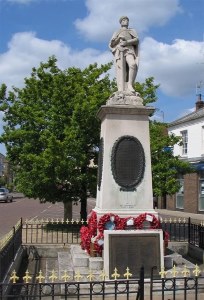 Whittlesey War Memorial The 12th Battalion crossed the Channel to Le Havre from Southampton on 6th June 1916 and concentrated near Lillers. They were in the front line near Loos and were later in action at the Battle of the Ancre on the Somme. In 1917 they saw action during the German retreat to the Hindenburg Line, the capture of Fifteen Ravine, Villers-Plouich, and Beaucamp, and the raid on La Vacquerie in April and early May. Again, Herbert would have been transferred to this battalion at some point in France. The battalion's war diary recorded that batches of reinforcements joined the battalion in May, June and August 1917 and that the June batch included 18 men who had previously served with the Suffolk Regiment. It seems likely, therefore, that Herbert may have been transferred from the 8th Battalion to the 12th Battalion in France in June 1917 before the 8th Battalion left for Flanders. From 3rd to 18th July 1917 the 12th Battalion did a lengthy trench tour at Villers Ghislains before moving into reserve at Vaucelette Farm and then into support at Villers Ghislains. In August and September there were front line trench tours at Gonnlieu, east of Gouzeaucourt, with intervals in reserve or support at Vaucelette Farm. Herbert was killed in action at Gonnelieu during enemy shelling on 26th September 1917, aged 27. He was one of 99 Ordinary Ranks from the battalion killed that month. His body was never found and he is commemorated on the Thiepval Memorial Pier & Face 1c & 2a. Herbert is also remembered on the war memorial in Whittlesey. Herbert's parents moved to Loughborough to be near their only surviving child Rose Hackett after 1917. Herbert's mother died in 1928, Rose Hackett died the following year, and Herbert's father died in 1932, all in Loughborough. |
|
Private 241708 Charles Sydney Bennett |
|
1/5th Bn. Leicestershire Regiment Killed in Action 17th August 1917, Aged 25. |
|
Charles Sydney (or Sidney) Bennett, known as 'Charley' to his family, was born in Stafford on 1st March 1892 and baptised at Christ Church, Stafford, on 1st April 1892. He was the eldest child of Charles Bennett and his wife Mary Ellen (née Emery) who were married at St. Leonard's Church, Marston, Staffordshire, on Boxing Day 1891. Charley had one brother Arthur and two sisters Fanny and Elsie. Charley's father was a pipe track labourer and the family moved around from the Common, Stafford in 1892, to Redhill, Arnold, Nottinghamshire in 1901 and to Iveshead Road, Shepshed, in 1911. In 1911 Charley, aged 19, was a pipe track labourer like his father.
In the summer of 1912 Charley married Gertrude Martin in Stockport and their son Sidney was born in Loughborough not long afterwards. Charley and Gertrude had a second son Charles, also born in Loughborough, in 1915. Charley enlisted at Loughborough in the summer or autumn of 1915 and joined the 1/5th Battalion of the Leicestershire Regiment as Private 4656. He was later renumbered as Private 241708. As his service papers have not survived his precise date of enlistment is unknown. He was not sent to France until at least 1916. The 1/5th Leicesters in France received drafts of reinforcements in March, April, July and November 1916 and also in February 1917. Charley could have been in any of these drafts but the most likely one is that of 5th July 1916. On that date the battalion's war diary specifically mentions that a draft of 61 men from the 3rd and 5th Battalions of the Leicestershire Regiment reported for duty at Bienvillers. From 9th March 1916 the 1/5th Leicesters were in the area of Vimy Ridge, Pas de Calais, either in the front line, in support, in reserve or at rest. On 27th April the battalion was sent to the neighbourhood of Neuville St. Vaast to work with the French and English tunnellers and then to billets in Luchaux for bayonet training. This was followed by a period at Souastre digging cable trenches, and constructing bomb stores and gun pits in preparation for a 'big push'. On 4th June 1916 the battalion was moved up to trenches near Gommecourt. This was followed by further training at Warlincourt. During this time Charley was allowed some home leave. On 30th June the battalion assembled in a trench near Foncquevillers Church ready for the diversionary attack at Gommecourt on the first day of the Somme Offensive planned for 1st July. On 1st July 1916 the 46th Division of the Army, of which the 1/5th Leicesters were part, had 2445 casualties at Gommecourt. On 7th July they relieved the 4th Lincolnshires in the trenches opposite Essarts-lès-Bucquoy. The battalion remained in the area of Monchy-au-Bois until 29th October, either in the trenches or resting at Bienvillers or Pommier. The battalion's next move was to Millencourt for intensive battle training, returning to Halloy and then Souastre at the beginning of December. The battalion remained at Souastre until 11th March 1917 and then moved once more up to the line taking over 2,600 yards of frontage from the La Brayelle road to the Hannescamps-Monchy road. On 17th March they moved into Gommecourt for road mending before moving to Bertrancourt, Raincheval and then Rainvillers not far from Amiens. On 28th March the battalion marched to Saleux, entrained for Lillers in the north, and marched to Laires. Training took place until 13th April and continued for three further days at Manqueville, after which the battalion moved to the western outskirts of Lens. From there they marched to Bully-Grenay and went into the front line trenches where they were heavily shelled. On 29th April the battalion went into rest billets in cellars at Cité St. Pierre until 3rd May when they went into support trenches. On 8th they went into billets at Fosse 10 near Petit Sains for training and on 12th into reserve at Angres. Further trench tours south-west of Lens followed until 26th May when the battalion went into billets at Marqueffles Farm for training in bayonet fighting and bombardment and to practise methods of attack. On 6th June the battalion was back in the line and on 8th June went into the attack, suffering 96 casualties. Apart from two breaks at Red Mill from 9th-13th and 18th-20th June the battalion was in the trenches until 22nd June. On 21st June C Coy was accidentally gassed by the Royal Engineers, resulting in 94 casualties of whom 22 died. Back at Marqueffles Farm from 22nd the battalion had Lewis gun and signalling classes as well as attack training over a flagged course. On 27th June the battalion moved up to the line ready to attack on the following day. As they climbed out of the trenches on 28th June they met with the inevitable machine gun fire and over the next two days 60 Ordinary Ranks were killed. Relieved from the trenches at Lievin on 3rd July the battalion moved to Monchy-Breton for reorganisation and training until 22nd July when they moved to Vaudricourt before going into the line at Hulluch until 28th July. After respite at Noeux-les-Mines the battalion was at Fouquières until 14th August, practising for an attack. Moving to Noyelles the battalion went into the trenches on 15th August. Charley, aged 25, was presumed to have been killed in action in a raid on the German trenches at Hulluch on the night of the 16th/17th August 1917. He is commemorated on the Loos Memorial, Panels 42-44. He is also remembered on the war memorial in Shepshed, on the war memorial in the former St. Peter's Church building, Loughborough, and on the Carillon. |
|
Private 4651 George Bennett |
|
1/5th Bn, Leicestershire Regiment. Died of Wounds 20th May 1916, Aged 44. Buried St. Sever Cemetery, Rouen, A. 21. 7.
|
|
George Bennett (Junior) was born in 1871 in Shepshed, Leicestershire. He was the son of George Bennett (Senior), a builder from Shepshed, and his wife Sarah (née Lakin) who were married in in 1861. George Junior had three brothers Samuel, Francis and William and four sisters Mary, Elizabeth, Agnes and Catherine. The Bennett family lived at 13 Loughborough Road, Shepshed and in 1891 George Junior was employed as a shoe riveter. In 1895 George Junior, who had become a bricklayer's labourer, married Mary Garton Blood probably in Shepshed. The couple firstly set up home in The Lant, and then moved to Brook Street, both in Shepshed. They soon had five children, four of whom survived: George William, Reginald, Sarah and Deborah. Mary Garton Bennett later moved to Springfield Road. The date of George Junior's enlistment is unknown, but he was serving as Private 4651 with the 1/5th Leicestershire Regiment in France in 1916. From 9th March 1916 the 1/5th Leicesters were in the area of Vimy Ridge, Pas de Calais. The battalion's routine followed a regular pattern of six days in the front line trenches, six days in support, six days in reserve and six days rest. The support positions were in the Zouave valley. Nearby was Talus des Zouaves, an embankment honeycombed with solid deep dugouts which afforded the Leicesters a measure of protection. Towards the end of April the battalion moved via Camblain l'Abbé to trenches in order to carry out mining work for the first eight days of May. On 9th May the battalion then moved on to Mont-St.-Éloy. At some point during this period George Junior was wounded and transferred to a military hospital in Rouen. He died on 20th May 1916 and was buried in St. Sever Cemetery, Rouen, Grave A. 21.7. George is commemorated on the Shepshed War Memorial as well as on the Carillon. His elderly mother Sarah died about the same time as her son. |
|
Private 291955 Arthur Bexon |
|
|
10th Bn, Cheshire Regiment. Killed in Action 1st August 1917, Aged 19. Commemorated Ypres (Menin Gate) Panel 19 - 22.
|
|
|
Arthur Bexon was born in Loughborough in 1898. He was the eldest son of Harry Bexon and his wife Clara (née Hallam) who were married at Emmanuel Church, Loughborough on 5th March 1898. Arthur's father was a dyer's labourer in 1898 and 1911, but in 1901 he was a shirt scourer. Arthur had two brothers Harry and Charles and one sister Ethel. Another sister Clara died as a baby. In 1901 the family lived at 7 Occupation Road, Hinckley, Leicestershire, but by 1911 had returned to 13 Pinfold Street, Loughborough. The family later moved to 11 Bridge Street. Arthur attended the Baptist Church in Loughborough and when he left school was employed in Tucker's brickyard.
Arthur enlisted in the summer of 1916 and joined the 1/5th Battalion of the Leicestershire Regiment. He was subsequently transferred to the Cheshire Regiment as Private 291955. One source indicates that he initially joined the 2/7th Battalion of the Cheshires at Lowestoft before being posted to the 10th Battalion. The precise date of his enlistment, transfers and date of arrival at the front, however, are unknown as his service record has not survived. On 4th March 1917, however, while the 10th Cheshires were in training at Berthen, north of Bailleul, they received a draft of 49 Ordinary Rank reinforcements from Rouen and it is possible that Arthur was in this draft. Training continued at Borre, Outtersteene, La Blanche (near Steenwerck), Bailleul, Ste. Marie-Capell (near Caselle), Rossignol Le Chien Blanc (near Steenwerck) and at Pont de Nieppe until 10th April, 1917. The Battalion was then, from brigade support at Le Bizet, sent to the trenches from south of Ploegsteert Wood to the River Lys. Here heavy enemy trench mortars were causing considerable damage. On 17th April the battalion returned to Le Bizet for training and then moved to Rossignol Le Chien Blanc to work on the light railway and build heavy trench mortar replacements. At the beginning of May there was thirteen days training at Setques, followed by a bivouac session west of Bailleul while the battalion unloaded trains and built ammunition dumps. Further working parties on railways and tramways ensued as well as trench digging and making dugouts. On 6th June the battalion went into the assembly trenches and on the following day attacked the enemy in the Battle of Messines, incurring many casualties. After being withdrawn to the support lines the battalion was moved to Ravelsburg and then to Dennebroeucq for training until 6th July, after which they travelled by bus and lorry to Winnipeg Camp near Bussebom. On 9th July they went into the trenches west of Ypres before proceeding to Bellewaarde Beck to work on the trenches amid enemy shelling. Following a break at Reninghelst they went into the line on 1st August. The Loughborough Herald for Thursday 6th September noted that Arthur, aged 19, had been posted as missing since August 1st, 1917. On that day the 10th Cheshires relieved the 2nd Northamptonshire Regiment in support on the newly captured Bellewaarde Ridge. The men were distributed in shell-holes in front of and behind the ridge and were continuously shelled. This operation was part of the Battle of Pilckem Ridge, near Boesinghe, which took place from 31st July to 2nd August 1917 and was part of the opening attack of the Passchendaele Offensive. Arthur's body was never found. He is commemorated on the Ypres Menin Gate Memorial, Panels 19-22 and on the Carillon. |
|
|
Private 9276 John Reginald Birch |
|
2nd Bn, Leicestershire Regiment. Killed in action Mesopotamia 8th April 1917, Aged 23. Commemorated Basra Memorial Iraq. Panel 12.
|
|
John Reginald Birch was born in Barbados in 1894. He was the elder son of John Birch and his wife Mabel Ethel Birch (née Graydon) who were married on 25th October 1893 at the Bethel Wesley Church, Barbados. John Junior's father was a Sergeant Major with the 2nd Battalion of the Leicestershire Regiment. He had served in Bermuda and Halifax (Nova Scotia) prior to being sent to the West Indies. In December 1895 John Birch Senior was posted to Cape Colony, South Africa and Laurence, John Reginald's brother, was born there in Simonstown in 1897. A third sibling died young. John Senior remained in South Africa for the duration of the 2nd Boer War but his wife returned to England with the children and in 1901 was living in the Glen Parva Barracks near South Wigston, Leicestershire. In November 1902 John Senior was posted to India where he remained for four years stationed at Fort St. George, Madras, and then Belgaum. Whether his wife and sons joined him there is unknown. John Senior returned to England in November 1906 and in 1911 the Birch family was living at Hawcliffe Road, Mountsorrel. John Junior, however, was not with them- he had just enlisted at Lichfield. John Senior and his wife later moved to Kimberley Lodge, 131 Byron Street, Loughborough.. John Junior joined the 2nd Battalion of the Leicestershire Regiment as Private 9726. He was promoted to Lance Corporal on 2nd July 1913. In August 1914 John's battalion was in Ranikhet with the Indian Corps (Gharwal Brigade) in the Meerut Division and was ordered to proceed to France. The troops left Karachi on 21st September and arrived at Marseilles on 12th October 1914. They then transferred via Orleans, Lillers and Calonne-Ricouart to the frontline trenches. For the next month they came under continued shellfire, bombing and sniping from the enemy but, nevertheless, continued to strengthen the trenches. In 1915 John took part in the Battles of Neuve Chapelle (10th-13th March) and Aubers Ridge (9th May), the first day of the Battle of Festubert. The 2nd Leicesters spent the next couple of months alternately in the trenches or in billets while war training, in the area of Calonne and Vieille Chapelle north-east of Béthune. John's battalion was next deployed at the Battle of Loos. John was fortunate to survive the initial attack at the Battle of Loos on 25th September 1915 - from his battalion 72 men were killed, 217 were wounded, 42 were gassed and 96 were recorded as missing. The 2nd Battalion was rather depleted after the Battle of Loos, but was ordered to the Persian Gulf where Britain was fighting Turkish forces allied to the Germans. On 10th November 1915 John embarked at Marseilles and arrived at Basra on 8th December 1915. From there he travelled by boat up the River Tigris to Ali Gharbi, 150 miles south-east of Baghdad. In Mesopotamia General Townshend and his troops were under siege at Kut. On January 7th 1916 General Aylmer's leading troops, under Major General Younghusband, challenged the enemy at the Battle of Sheikh Sa'ad, with the intention of relieving General Townshend at Kut. The Battle of Wadi followed on 13th January and the Battle of Hanna on 21st January. An attack on the Dujaila Redoubt failed in March but the British captured Fallahiyeh and Beit Asia in April. An attack on Sannaiyat failed and on 29th April General Townsend was forced to surrender at Kut. The Tigris Corps managed to occupy the Dujaila Redoubt south of Kut and kept a close watch on the Ottoman forces. The intense heat from June to August, however, caused a heavy toll from sickness and disease among the troops. As the heat lessened in September and October 1916 the enemy raised its activities in sniping and bombing from the right bank of the Tigris. In December the Tigris Corps had begun a long offensive operation with the purpose of dislodging the enemy from the right bank position and severing the enemy's communication channels. By 18th December the Tigris Corps had extended their grip on the Turkish defences and had cut in opposite Kut between the outer Turkish defences and the west of the Hai, while simultaneously bombarding Sannaiyat. By the end of February 1917 Kut had been reoccupied by the Tigris Corps and the final push towards Baghdad began. On 4th March John's battalion marched to Shargy and on the following day to Azizieh. Bawi was reached on the morning of the 8th March and the battalion was ordered to proceed towards Baghdad on the night of the 8th March. On 9th and 10th March the enemy shelled the advancing troops but the battalion entered Baghdad on 11th March, succeeded in occupying the city and remained there until 25th March. On 25th March the battalion marched to Babi and then Mushaidie Station. On April 4th the battalion was ordered to occupy Balad Station and secure the line from Balad to Sidigharib. On 8th April 1917 the battalion marched from Sumaika and came under hostile gun fire near Balad Railway Station. John Reginald Birch was killed during this action. He is remembered on the Basra Memorial, Iraq, Panel 12. John Senior, who was a storekeeper in 1914, reenlisted for the war and served at home being given a training role with the 3rd, 9th and 10th battalions of the Leicestershire Regiment. |
|
Sergeant 168202 Frederick Bird |
|
B Bty. 275 Bde, Royal Field Artillery. Killed in Action 20th October 1918, Aged 27. Buried Esplechin Churchyard, Tournai, Hainaut. II. A. 2.
|
|
Frederick Bird was born in Chester in 1891 and baptised on 26th April 1891 at Holy Trinity Church, Chester. He was the son of Edward Frederick Bird and his wife Eliza (née Lewis) who were married at Holy Trinity Church, Chester, on 5th August 1888. Frederick's father was a tailor and the Bird family lived at various times at No. 14, No. 11 and No. 19 Kitchen Street, Chester. Frederick had three brothers Wilfred, Joseph and Arthur and four sisters Rosina, Annie, Barbara and Ethel. In 1911 Frederick was employed as a lamplighter for the County Borough Electricity Works.
On New Year's Day 1916 Frederick married Helena Campbell, who like Frederick came from Chester, at Emmanuel Church, Loughborough. At the time of his marriage Frederick was an Acting Sergeant in the Royal Field Artillery. Frederick's service record has unfortunately not survived and his date of enlistment is not known. His medal record indicates, however, that he did not go abroad until 1916 and it is possible that he was sent abroad as Acting Sergeant 168202 to join the 1/1st West Lancashire Brigade of the Royal Field Artillery not long after he was married. His wife remained at 25 Regent Street, Loughborough, for a while but then moved to 65 Herbert Street. Between 2nd January and 4th February 1916 the 1/1st West Lancashire Brigade was in training at Allery. On 5th February the brigade marched to Longvillers and Mesnil for inspections until 10th February. They then proceeded to Thievres and on 13th February three sections took up positions at Beaumetz-les-Loges, with the HQ at Coullemont. Two days later the HQ moved to Basseux where it stayed until 5th July. By 17th February all batteries were in the line. During March the batteries carried out bombardments on Block House, Ficheux, Blairville and Ransart and on Les Trois Maisons. During April they bombarded Boiry. On 15th May 1916 the title of the 1/1st West Lancashire Brigade was changed to 275 (Howitzer) Brigade Royal Field Artillery and the 1st, 2nd and 3rd Lancashire Batteries became A, B and C Batteries respectively. Frederick was with B Battery. 275 Brigade was in the 55th (West Lancashire) Division of the Army. During June the brigade bombarded Blairville and a number of other villages. On 5th July the HQ moved to Grosville and the guns subsequently took up new positions at Bellacourt. On 14th July the brigade bombed the enemy front and support lines. Between 20th and 30th July the brigade moved via Grouche, Vignacourt and Daours to Bois de Tailles in the Somme valley. During August they carried out day and night firing and wire cutting and took part, on 8th August, in operations around Guillemont. In early September the brigade moved to Corbie and Bavlincourt before supporting operations at Flers and Martinpuich on 15th and 16th September. In late September they were involved in night firing on the Flers line and the bombardment of Goose Alley. Between 29th September and 6th October 1916 the brigade completed an eight-day move by march away from the Somme to Watou, on the Ypres Salient. They went into the firing line between Wieltje and Railway Wood three days later. From then until the end of April 1917 the brigade supported actions by the 165th Infantry Brigade, cooperating with bombardments of the enemy front, roads and back areas. The brigade itself was often under enemy artillery fire. Breaks from the front were taken at Watou. On 21st April 1917 the Brigade moved from Houtkerque via Roubrouck to Ruminghem for a week's training. They then returned to the Ypres front line to support infantry raids and to carry out wire cutting. During June the brigade carried out a smoke shell bombardment of the enemy front line at Frezenburg. They also supported the attack on the Messines Ridge between 7th and 14th June. Throughout June there were casualties nearly every day. The brigade war diary from July to October 1917 has been lost and details of the role of the brigade during the Passchendaele Offensive are limited. The Army's 55th Division to which the brigade belonged was involved in the Battle of Pilckem Ridge from 31st July to 2nd August, after which it was withdrawn to Recques for re-fit and training on 7th August. The Division also took part in the Battle of Menin Road Bridge from 20th-23rd September. The 55th Division then moved out of the line from 22nd/23rd September and proceeded to a very different area, south of Cambrai. The position taken up was between Honnecourt Wood and Lempire-Ronssoy and the brigade headquarters was at Epehy. During November the brigade supported an attack on Knoll and Guillemont Farm and carried out harassing fire at night on sensitive enemy positions, all part of the Cambrai Operations. After the 55th Division faced an enemy counter-attack on 30th November 1917 in which the front line defence crumbled and allowed the enemy to make a rapid and almost bewildering advance the Division was withdrawn from the area and sent to Bomy near Fruges for intensive training, and 275 Brigade was sent to billets at Verchin. Training took place throughout January 1918 and included musketry, the control of an artillery barrage by signals from aeroplanes and inspections. Between 7th and 11th February the brigade moved via Bellery to Hesdigneul and Fouquières-lès-Béthune and returned to the front line at Givenchy and Festubert on 16th February. Here it faced numerous strong enemy raids in March and there was a very marked increase in activity from hostile artillery and trench mortars. The brigade retaliated by firing on the enemy's communications trenches and trench junctions. They also bombarded the enemy's front and support lines and released harassing fire. The brigade took part in the Battle of Estaires on 9th-11th April, including the defence of Givenchy from 9th-17th April. Enemy attacks continued until 24th April and the brigade's positions were frequently shelled. The brigade was relieved on 26th April and withdrew to Houchin for a break until 10th May. On 11th May the brigade returned to the line at Beuvry, carried out a bombardment of Festubert and Le Plantin on 22nd May and delivered harassing night fire until 27th May. On 12th June the brigade moved via Houchin and Haillecourt to the Bois des Dames, where they took part in tactical exercises and brigade sports. On 25th June they returned to the Festubert sector and from Houchin provided harassing night fire until the end of the month. The brigade's July war diary is missing but in August the brigade was still at Houchin delivering harassing fire and towards the end of the month supported a small operation in the area. By the beginning of September the enemy's line of resistance in the area of Beuvry had become obscure and the infantry began to push forward to a front west of the La Bassée-Aubers line. Here some opposition from the enemy took place and on 18th, 20th, 25th, 29th and 30th September the brigade supported Allied attacks, at the same time increasing the programme of harassing fire. At the beginning of October the infantry, covered by a barrage from the brigade, successfully attacked the La Bassée-Hubert-Fromelles line and entered Marguilles and Petit Hantay. The brigade HQ then moved to Petit Mesnil and the brigade continued with bombardments and regular harassing fire. The pursuit to Mons, a phase of the final advance into Artois, had begun. On 17th October, as the enemy continued to withdraw, the batteries moved to Noyelles. On 20th October the brigade supported an infantry action to drive the enemy from a ridge between Marquain and Froidmont. During this operation Frederick, aged 27, was killed in action. Frederick was buried in Esplechin Churchyard, Tournai, Hainaut, Grave II. A. 2. Frederick's widow Helena married Walter C. Brown in Loughborough in 1924. |
|
Private 12166 Frederick Bishop |
|
8th Bn, Leicestershire Regiment. Killed in Action 15th July 1916, Aged 22. Commemorated Thiepval Memorial Pier & Face 2c & 3a.
|
|
Frederick Bishop was born in Loughborough in 1895, the son of Thomas and Ellen Bishop (née Gibson) who were married in Loughborough that same year. Ellen already had a son Herbert Gibson, aged 7, when she was married and with Thomas Bishop she had five more children Frederick, Thomas, George, John and Jessie. Frederick's father was a textile dyer's labourer and in 1901 the Bishop family lived at 73 Regent Street, Loughborough. By 1903 they had moved to William Street from where Frederick's mother was summoned to court for common assault on a neighbour Mrs. Mary Yeomans and fined 10 shillings.
In May 1907 Frederick's mother was living in Providence Square, Loughborough, where she was hit with a knuckle duster and stabbed with a pair of scissors by a neighbour, Mrs. Rosanna Marriott. By 1911 Frederick's mother had moved again, this time to Wheat Sheaf Yard, Loughborough, describing herself as a widow and a hosiery seamer. It seems, however, that Frederick's father Thomas Bishop was still alive and had simply left his wife. In 1911 Frederick's mother was sent to prison for fourteen days for stealing a pork pie and polonies, while under the influence of alcohol, from the shop of Edward Hasenfuss, butcher in Bedford Square. Frederick, meanwhile, who was now aged 15, had become a tile maker. By 1914 he had moved on to become an engine driver. Frederick enlisted in Loughborough on 1st September 1914 and joined the 8th (Service) Battalion of the Leicestershire Regiment as Private 12166. From the Depot he was sent firstly to Aldershot for training. He moved to Shorncliffe in Kent at the end of February 1915. In April 1915 Frederick's battalion became part of the newly established 37th Division of Kitchener's 2nd New Army and the Division began to concentrate on Salisbury Plain. On 25th June the units were inspected by King George V at Sidbury Hill. On 22nd July the Division began to cross the English Channel and Walter travelled to France on 29th July 1915. Initially the 37th Division concentrated near Tilques. The 8th Battalion then moved via Watten, Houlie, St. Omer, Eecke and Dranoutre to Wulverghem and Berles-au-Bois, a short distance from the front line. In the months that followed the 8th Battalion did tours in the trenches, alternating with the 6th Leicesters who relieved them. They were Involved in operations in Bailleul, Le Bizet, Armentières, Mondicourt, Beauval and Berles-au-Bois. On 13th March 1916 Frederick was admitted to 48 Field Ambulance with an abscess. In April 1916 he moved with the 8th Leicesters to the Doullens area for six weeks for cleaning up, resting and training. In mid-May they returned once more to the trenches in the Bienvillers-Bailleulmont sector, but nearer Gommecourt. In June there was a series of nightly excursions into No-Man's Land with patrols attempting to gather information on the enemy's dispositions. On other occasions there were working parties out repairing the British barbed wire entanglements. The situation became increasingly hazardous as the month wore on when the Germans began to use a new and more accurate type of trench mortar. The 8th Battalion did not participate in the first days of the Somme Offensive but was held in reserve. On 6th July they left billets at Humbercamps and marched to Talmas, continuing on the following day to billets in Soues. On 10th July the battalion marched to Ailly-sur-Somme, entrained for Méricourt and travelled from there by lorry to bivouacs in Méaulte. Between 10th and 13th July the battalion was in the trenches near Fricourt and subjected to fairly continuous enemy fire. On 14th and 15th July the battalion advanced on Bazentin Le Petit Wood. During this operation Frederick, aged 22, was killed in action. Frederick is commemorated on the Thiepval Memorial Pier and Face 2C and 3A, and on the memorial in the former St. Peter's Church, Loughborough, as well as on the Carillon. Frederick's brother Thomas served with the 1/5th Leicestershire Regiment but suffered an enlarged heart after contracting pneumonia in 1916 and was discharged from the Army in 1917. Frederick's half-brother Herbert Gibson served as 'Herbert Bishop' with the 8th Battalion of the Leicestershire Regiment and unfortunately lost an eye as the result of a wound in France in 1915. Frederick's younger brother George served with the Coldstream Guards from April 1918 onwards. |
|
Private 241179 Thomas William Blackwell |
|
|
D Coy. 1/4th Bn. Leicestershire Regiment. Killed in Action 4th May 1918, Aged 24. |
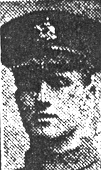 |
|
Thomas William Blackwell was born in Loughborough in 1893 and baptised on 7th November 1893 at the Free Church, Loughborough. He was the son of William Blackwell and his wife Mary Elizabeth (née Kidger) who were married in Loughborough in 1889. Thomas's father was a haberdasher's warehouseman in 1901, but by 1911 had become a general labourer. For a number of years the Blackwell family lived in Sparrow Hill, Loughborough, firstly at No. 3 and then at No. 9. They later moved to 4 Freehold Street. Thomas had three brothers Charles, Walter and Frederick. In 1911, when Thomas was 17, he was an apprentice tinsmith with Mrs. Harriet Partridge of 63 Baxtergate.
Thomas enlisted in the autumn of 1914 and joined the Leicestershire Regiment as Private 3444, later re-numbered as 241179. He joined the 2/5th (Territorial) Battalion of the Leicestershire Regiment which had its HQ in Loughborough as part of the Lincoln and Leicester Brigade, North Midland Division. In January 1915 the battalion moved to Luton being billeted in private homes, in February and March they had a spell at Epping digging practice trenches. In July the battalion moved to the St Albans area, under canvas at Briton Camp for training and route marches. In August 1915, the Brigade was retitled 177th Brigade, 59th Division (2nd North Midland) and in October they were moved back to billets in Harpenden. Throughout 1915 some members of the 2/5th Leicesters also provided guards for the prisoner of war camp at Donington Hall. In January 1916 parties of officers were sent to France on tours of instruction in the trenches and in March, the long awaited orders to proceed overseas were received. On Easter Monday, however, the rebellion in Ireland forced a rapid change of plans. The 177th Brigade was recalled from leave and ordered to move to Liverpool at midnight. The following day they sailed on the SS Ulster, a fast mailboat, escorted by a Royal Navy destroyer. Their first taste of action was not to be in the trenches of the Western Front, but in the streets of Dublin. By the end of the month the main uprising was over and the 2/5th Battalion supplied search parties for Ballsbridge and guarded railways, bridges and other key infrastructure. On the 10th May they moved out of the city to tackle pockets of resistance in County Kerry, searching homes and making arrests. In June word was received that the Battalion would be moving to France and training resumed with long route marches through Ireland. In August they marched 80 miles from Tralee to Fermoy Barracks, where they would remain until January 1917, engaged in live fire training in trench warfare. The return trip from Ireland was made aboard the SS Ulster and the battalion arrived at Fovant Camp in Wiltshire by train at 7pm on 6th January 1917. After embarkation leave they proceeded to France via Southampton, arriving at Le Havre on the 24th February 1917. They were sent to the Somme area where the enemy was retreating to the Hindenburg Line. They made their first attack on the villages of Hesbecourt and Hervilly on 31st of March 1917, capturing both villages and suffering a number of casualties. On 1st April the battalion began constructing a line of cruciform posts and on the following day were shelled while doing so. On 3rd and 4th April part of the battalion supported the 4th Leicesters in an attack on Fervaque Farm while the rest of the battalion built posts in Templeux. On 11th and 12th April the battalion moved to Hervilly and Hamelet to provide working parties and on 15th A and C Coys were in support for an attack on Villeret. On 17th April the battalion moved from Brosse Woods to Templeux and Hervilly and were in support again on the following day in an attack on a quarry north of Villeret. On 19th April the battalion moved to Hancourt for cleaning up, working parties and training. On the night of 27th/28th April Hancourt was bombarded by the enemy and the battalion moved to the front line at Le Vergier. Trench tours continued until 15th May when the battalion marched back to Bois Bias training camp between Bouvincourt-en-Vermandois and Le Catelet. Training took place until 25th May when they moved to Equancourt and went into the front and support lines at Villers Plouich. Here until 7th June more posts were constructed amid some heavy enemy bombardment. From 7th-16th June the battalion was in Brigade Reserve at Dessart Wood, after which the battalion returned to the front line at Villers Plouich and carried out cable digging and laying for the Royal Engineers. Attack training took place at Equancourt from 22nd-30th June, after which the battalion went into support at Metz-en-Couture until 10th July. For the rest of July and the first three weeks of August the battalion was in training at Barastre camp. On 22nd August the battalion moved via Senlis to a front one mile south-west of Le Sars for further training. On 31st August they entrained at Albert for Hazebrouck and marched to a training camp north of Winnezeele where they remained until 20th September. By 23rd September the battalion was in the reserve trenches at St. Jean near Ypres, before taking over the front line at Hill 37, Hill 35 and Elmtree Corner. On 26th September the battalion went into attack to capture all enemy positions on Hill 37 (part of the Battle of Polygon Wood, a phase in the 3rd Battle of Ypres or Passchendaele). All objectives were taken and on 30th September the battalion proceeded to Corps reserve on the Wieltje road and then to Vlamertinghe. On 2nd October the battalion travelled by train to Thiennes and then spent three days at the Training Base Depot, Calais. On 6th October they moved by bus to Beaumetz-lez-Aire for a further three days training. Between 10th and 13th October the battalion marched via Camblain-Chatelain and Houdain to Gouy-Servins. After a brief halt at Tottenham Camp they began a trench tour at Old Brewery. Training and inspections took place at Alberta Camp from 21st-28th October before the battalion returned to the line at Liévin. Early November was occupied with working parties before the battalion moved by light railway and march to Petit Servins for training. Between 17th and 21st November the battalion marched via Habarcq and Bailleulval to Henman Camp South, Achiet-le-Petit. Two days later they entrained for Fins and marched to Dessart Wood. On 30th November the moved forward into the Hindenburg Support line. On 4th December the battalion withdrew to hold the Flesquières line. Between 6th and 9th December the enemy attacked in large numbers but were repulsed and there was heavy shelling with artillery duels on both sides. The next part of December was spent training at Lechelle, in Reserve at Trescault, and on working parties in the Hindenburg support line. On 23rd December the battalion marched to Rocquigny. On Christmas Day they entrained at Bapaume for Tinques and marched to Penin. Christmas was celebrated on 27th December, after which training began and continued throughout January 1918. On 31st January 1918 the 2/5th Battalion was broken up and the men distributed between the 1/4th, 2/4th and 1/5th Leicestershire battalions. Between 158 and 200 Ordinary Ranks (accounts vary) were posted to the 1/4th Battalion at Mont Bernachon and it is likely that Thomas was in this group. On 1st February the 1/4th Battalion marched to Busnes. Training and reorganisation took place at Busnes until 8th February when the battalion marched to Westrehem. The battalion was now ordered to seize the crossing of the River Lys between Delette and Dennebroeucq. This was done and the battalion moved to Coyecque to continue training until 1st March. On 1st March the battalion began a four-day move via Flechin, Manqueville and Noeux-les-Mines to the trenches in the Cambrin south sector. On 7th March they shot down an enemy propaganda balloon which contained a copy of Gazette des Ardennes. Several days in brigade support at Annequin and Sailly-Labourse followed when the men provided working parties. After this there was a return to the trenches in the Cambrin north sector where they were shelled by the enemy. Following a break at Beuvry the battalion went into the front line in the Hohenzollern sector. Here they were heavily trench-mortared by the enemy who endeavoured to break through the front. As the enemy was now expected to attack between Hill 70 and La Bassée the battalion was ordered to move to the Hill 70 sector. Relieved on 6th April the battalion moved to Les Brebis for a rest and to provide working parties. Returning to brigade support on 9th April the battalion suffered an enemy gas attack. After a brief return to the front line the battalion was relieved on 12th April and began a three-day move to Bois de Froissart Camp, Hersin, where a large number of men were sent to hospital suffering from influenza. On 26th April the battalion marched to Fouquières and into brigade support near Essars which was shelled on 29th and 30th April. During the night of the 2nd/3rd May 1918 the battalion relieved the 5th Lincolnshires in the left sub-sector of Essars. On 4th May the enemy put down a heavy barrage on the left company front. Two Ordinary Ranks were killed and 120 wounded. Thomas, aged 24, was one of the two men killed. Thomas had for some time been batman to Lieutenant Dakin of Shepshed. The Company Officer wrote: 'He was splendid and always performed any task allotted to him cheerfully and willingly. His devotion to duty was an example to his comrades, who join with me in mourning his loss. I tender my sincere and deepest sympathy to you and trust that you will be given strength to bear this great bereavement. God rest the soul of a brave soldier'. Thomas was buried in Fouquières Churchyard Extension, Grave I. 72. Thomas's brother Walter also served in the Leicestershire Regiment. He survived the war. |
|
|
Private 17518 William Blood |
|
|
2nd Bn. Leicestershire Regiment Died of Wounds 3rd October 1916, Aged 26. |
|
|
William Blood was born in 1889 in Loughborough. He was the son of Thomas Henry Blood, a shoemaker, and his wife Charlotte (née Hall). William's parents both came from Shepshed and they were married in 1883. Thomas and Charlotte Hall had eight children but by 1911 only three were still alive, most having died in infancy. William was the only surviving son; his older brother George had died, aged 23, in 1909. William had two surviving sisters Blanche and Edith. In 1891 the family lived at 27 Union Street, Loughborough, but by 1901 had moved to 134 Paget Street. Between 1901 and 1911 they moved again, this time to 44 Ratcliffe Road. In 1911 William and his sisters were all factory hands in cotton hosiery.
William's service record with the Army has not survived so it is not possible to tell exactly when he enlisted. He joined the 2nd Battalion of the Leicestershire Regiment as Private 17518 and it seems likely that he did so towards the end of 1915. He certainly appears not to have served overseas until 1916 as he was not awarded the 1914/15 Star Medal. In the winter of 1915/1916 the 2nd Battalion of the Leicestershire Regiment, as part of the Army's 7th Indian Division, was moved to Mesopotamia to form the Tigris Corps. In January 1916 General Townshend and his troops had been besieged at Kut-al-Amara since mid-December and three unsuccessful attempts were made to break the siege. Battles took place at Sheikh Sa'ad, the Wadi and Hanna resulting in many casualties. A further attack at Dujaila Redoubt in March failed. In April 1916 No. 30 Squadron of the Royal Flying Corps carried out the first air supply operation in history. Food and ammunition were dropped to the defenders of Kut, but unfortunately their parcels often fell into the Tigris or into the Turkish trenches. On 5th April a battle began for Fallahiyeh which the British soon captured but with heavy losses. Beit Asia was taken on 17th April. A final effort against Sannaiyat was made on 22nd April but this was unsuccessful and the Allies suffered about 1,200 casualties in the process. During the remainder of April other attempts were made to dislodge the enemy from their position at Sannaiyat but without any success. All attempts to relieve Kut failed and on 29th April 1916 General Townshend was forced to surrender to the Ottomans at Kut. The surrender at Kut was a severe blow to British prestige and morale and the troops were exhausted by their efforts. The Tigris Corps nevertheless still maintained a close watch on the Turks in the areas of Sannaiyat and Beit Isa. In mid-May it became apparent that the enemy had withdrawn from Es Sinn and the British were able to occupy the Dujaila Redoubt. The intense heat in June, however, caused a heavy toll from sickness and disease among the troops. As the heat lessened in September and October the enemy raised its activities in sniping and bombing and at some point William was wounded and taken to one of the military hospitals set up in Amara. He died from his wounds on 3rd October 1916, aged 26, and was buried in Amara War Cemetery, Iraq, Grave XXI. B. 2. In 1933 the grave headstones were removed after it was found that they were being damaged by salts in the soil and a memorial wall erected instead with the names of the dead engraved upon plaques. Thomas and Charlotte Blood thus lost their only surviving son and now only had two daughters left from the original eight children born to them. |
|
|
Amara War Cemetery.
|
|
|
Private 241241 Thomas Fergus Christopher Bonser |
|
1/5th Bn, Leicestershire Regiment. Killed in Action 15th August 1917, Aged 24. Buried Philosophe British Cemetery, Mazingarbe. I. U. 39.
|
|
Thomas Fergus Christopher Bonser, known as 'Fergus', was born in Rothley, Leicestershire, in 1893, the son of Alfred Bonser and his wife Annie Sarah (née Bishop). Fergus' parents were married at All Saints Church, Loughborough, on 19th September 1891. Fergus' father was an ironmonger when he married, but by 1901 had become a greengrocer and by 1911 was working as a carter for a brickmaker. Fergus had a younger sister Zillah and a younger brother Alfred. Another sister Annie died young. The Bonser family firstly lived at 24 Albert Street, Loughborough, but later moved to 41 Paget Street. Fergus attended the Emmanuel Church Bible Class and at the age of 17 was working as a brickyard labourer for Messrs. Tucker. He was subsequently employed at the Falcon Works of the Brush Electrical Engineering Company.
Fergus joined the 1/5th Leicestershire Regiment as Private 3534 and was renumbered in 1917 as Private 241241. His exact date of enlistment is not known as his service papers have not survived but it is likely to have been in late 1914 or early 1915. He was sent to France on 30th June 1915 to join his battalion in the area of Zillebeke, south-east of Ypres. From July to September 1915 the battalion remained in the area of Zillebeeke and Ouderdom, before moving to Hesdigneul-lès-Béthune in October, La Couture in November and Merville and Thienne in December. January 1916 was taken up with a potential move of Fergus' battalion to Egypt which was aborted at Marseilles, the battalion being returned to Candas, and the area of Vimy Ridge. In mid-February 1916 the 1/5th Battalion took over the line north of the River Ancre opposite Beaumont-Hamel. On 29th February the battalion moved to the area of Doullens where the men worked on improving the trenches despite being subjected to a considerable bombardment from the enemy with mines and craters being blown. From 9th March 1916 the 1/5th Leicesters were in the area of Vimy Ridge, Pas de Calais, either in the front line, in support, in reserve or at rest. On 27th April the battalion was sent to the neighbourhood of Neuville St. Vaast to work with the French and English tunnellers and then to billets in Luchaux for bayonet training. This was followed by a period at Souastre digging cable trenches, and constructing bomb stores and gun pits in preparation for a 'big push'. On 4th June 1916 the battalion was moved up to trenches near Gommecourt. This was followed by further training at Warlincourt. On 30th June the battalion assembled in a trench near Foncquevillers Church ready for the diversionary attack at Gommecourt on the first day of the Somme Offensive planned for 1st July. On 1st July 1916 the 46th Division of the Army, of which the 1/5th Leicesters were part, had 2445 casualties at Gommecourt. On 7th July they relieved the 4th Lincolnshires in the trenches opposite Essarts-lès-Bucquoy. The battalion remained in the area of Monchy-au-Bois until 29th October, either in the trenches or resting at Bienvillers or Pommier. The battalion's next move was to Millencourt for intensive battle training, returning to Halloy and then Souastre at the beginning of December. The battalion remained at Souastre until 11th March 1917 and then moved once more up to the line taking over 2,600 yards of frontage from the La Brayelle road to the Hannescamps-Monchy road. On 17th March they moved into Gommecourt for road mending before moving to Bertrancourt, Raincheval and then Rainvillers not far from Amiens. On 28th March the battalion marched to Saleux, entrained for Lillers in the north, and marched to Laires. Training took place until 13th April and continued for three further days at Manqueville, after which the battalion moved to the western outskirts of Lens. From there they marched to Bully-Grenay and went into the front line trenches where they were heavily shelled. On 29th April the battalion went into rest billets in cellars at Cité St. Pierre until 3rd May when they went into support trenches. On 8th they went into billets at Fosse 10 near Petit Sains for training and on 12th into reserve at Angres. Further trench tours south-west of Lens followed until 26th May when the battalion went into billets at Marqueffles Farm for training in bayonet fighting and bombardment and to practise methods of attack. On 6th June the battalion was back in the line and on 8th June went into the attack, suffering 96 casualties. Apart from two breaks at Red Mill from 9th-13th and 18th-20th June the battalion was in the trenches until 22nd June. On 21st June C Coy was accidentally gassed by the Royal Engineers, resulting in 94 casualties of whom 22 died. Back at Marqueffles Farm from 22nd June the battalion had Lewis gun and signalling classes as well as attack training over a flagged course. On 27th June the battalion moved up to the line ready to attack on the following day. As they climbed out of the trenches on 28th June they met with the inevitable machine gun fire and over the next two days 60 Ordinary Ranks were killed. Relieved from the trenches at Lievin on 3rd July the battalion moved to Monchy-Breton for reorganisation and training until 22nd July when they moved to Vaudricourt before going into the line at Hulluch until 28th July. After respite at Noeux-les-Mines the battalion was at Fouquieres until 14th August, practising for an attack. Moving to Noyelles the battalion went into the trenches on 15th August. On the way up to the trenches an enemy shell landed by one party of soldiers, killing eleven men instantly and wounding fourteen. Fergus, aged 24, was one of those killed. The news was sent in a letter from his Lieutenant, who wrote regretting the sad news, saying that 'Fergus had been with the battalion a long time and was well liked by his comrades, and was a good and willing soldier, who died a soldier's death. The whole company joined in offering their deepest sympathy with the family in their loss'. Mr. and Mrs. Bonser also received a letter of sympathy from the Chaplain to the Battalion. Fergus was buried in Philosophe British Cemetery, Mazingarbe, Grave I. U. 39. He is remembered on the memorial in Emmanuel Church, Loughborough, and on the Carillon. The sole legatee to Fergus' estate was Florence Kenton, whose identity is unknown. |
|
Bombardier 59007 John William Bottrill |
|
|
A Bty, 100th Bde., Royal Field Artillery. Died of Wounds 4th March 1917, Aged 32. Buried Salonika (Lembet Road) Military Cemetery Greece, 946.
|
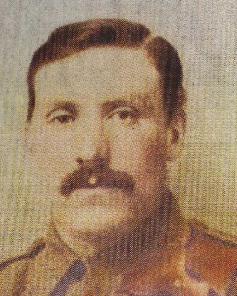 |
|
John William Bottrill was born on 24th October 1884 at Albert's Buildings, Oakham, Rutland. His birth was registered under the name 'John William Baker' and he was the natural son of Hannah Baker, shoe fitter, father unknown. In 1891 six-year old John William was living at John's Court, Oakham, with his aunt Ann Ellen Broom (known as 'Ellen', née Baker), a machinist at a shoe factory, and her husband John Broom, a general labourer. John Henry Broom had married Ann Ellen Baker (known as 'Ellen') in Oakham in 1875. Hannah Baker had married John James Hubbard Taylor in Oakham in 1885, but her son John William remained with his aunt.
After John Henry Broom died, aged 38, in Oakham in 1892 Ellen Broom appears to have moved to 23 Mill Street, Loughborough as in 1901 she was living there with John Rodgers, a bricklayer's labourer. She was listed as 'Ellen Rodgers' and John William, described as 'son', now aged 16 and an engineering labourer, has assumed the name of 'John William Rodgers'. By 1911 Ellen, now described as a 'widow', and John William had moved again, this time to Coventry. Both had taken the new surname of 'Bottrill'. In 1903 John William had married a young woman from Loughborough, Sarah Ann Jarram, in Coventry. At the time of the marriage both John William, a labourer, and his bride gave their address as 8 House, 2 Court, Castle Street, Coventry. The parish register entry for John William's marriage lists his father as 'John Bottrill' (possibly John Rodgers now known as 'John Bottrill' or a different person altogether). By 1911 John William and Sarah Ann had three children Kathleen Ellen (known as 'Nellie'), Sarah and Thomas (all with the surname of 'Bottrill') and in 1911 they were all living with Ellen at 9 St. Agnes Lane, Coventry. John William was now employed as a general carman. [Ann] Ellen Bottrill died in the early summer of 1911 in Coventry and John William and Sarah Ann had another daughter Elizabeth in 1913. John William enlisted on 5th January 1915 while working as a labourer in Coventry. As Gunner 59007 he was initially sent to No. 3 Depot of the Royal Field Artillery at Hilsea, Portsmouth, Hampshire for training. On 20th February 1915 he was posted to the 22nd Division of Artillery. On 28th June 1915, while stationed at Aldershot, he received five days punishment for overstaying leave by three days. In July 1915 he was posted to No.15 Reserve Battery and on 3rd September was appointed to A Battery, 100th Brigade, Royal Field Artillery. John William left Aldershot on 5th September and went to Southampton from where he sailed for Marseilles in France. Just over two months later, on 21st November he boarded a ship heading for Salonika, Greece where he arrived on 13th December. He was promoted to Bombardier on 26th December 1915. Anglo-French forces had begun landing at the Greek port of Salonika on 5th October 1915. The troops were sent to provide military assistance to the Serbs who had recently been attacked by combined German, Austro-Hungarian and Bulgarian armies. The intervention came too late to save Serbia and, after a brief winter campaign in severe weather conditions on the Serbian frontier, the Anglo-French forces found themselves back at Salonika. At this point the British advised that the troops be withdrawn. However, the French - with Russian, Italian and Serbian backing - still believed something of strategic importance could be gained in the Balkans. During the first four months of 1916 the British Salonika Force had enough spadework to last it for the rest of its life. Large amounts of barbed wire were used and a bastion about eight miles north of the city was created connecting with the Vardar marshes to the west, and the lake defences of Langaza and Beshik to the east, and so to the Gulf of Orfano and the Aegean Sea. After preparing the port of Salonika for defence, the troops moved up country and dug-in. Further Allied contingents of Serbian, Italian and Russian troops arrived in the summer and offensive operations began. The Bulgarian attempt at invasion of Greece in July was repulsed near Lake Doiran. At the beginning of October 1916 the British, in co-operation with her allies on other parts of the front, began operations on the River Struma towards Serres. The campaign was successful with the capture of the Rupell Pass and advances to within a few miles of Serres. In November 1916 Monastir fell to Franco-Serb forces. On 1st March 1917 John William was attached to the 200th Railway Construction Company of the Royal Engineers but was hit by a shell. He died of wounds in No. 29 General Hospital, Salonika on 4th March 1917, aged 32. John William's wife Sarah Bottrill, who had moved with the children to 8 Ashby Square, Loughborough, when her husband enlisted, unfortunately received conflicting information about what had happened to her husband. On March 15th she received official notice of her husband's death. On March 18th she received an official wire that he was dangerously ill in No, 29 General Hospital, Salonika. John William was buried in Salonika (Lembet Road) Military Cemetery, Grave 946. He is remembered on the website Rutland Remembers as well as on the Carillon. |
|
|
Driver L/34973 Sidney Alfred Bowler |
|
16th Div.Ammunition Col. Royal Field Artillery. Died of Influenza 16th November 1918, Aged 34. Buried Terlincthun British Cemetery Wimille, XI. A. 35.
|
|
Sidney Alfred Bowler was born in Loughborough in late 1884 or early 1885. He was the son of Thomas Bowler and his wife Clara (née Pollard) who were married on 6th July 1879 at the Baptist Chapel, Loughborough. Thomas and Clara Bowler had eight children but only five survived to adulthood. As well as Sidney these were Thomas, Albert, Edna and Dorothy Bowler.
In 1891 the family lived at 27 Shakespeare Street, Loughborough, and Sidney's father was a general dealer's assistant. By 1901 the family had moved to 14 Victoria Street, Loughborough, and Sidney's father was now running his own haberdashery shop in which Sidney helped. By 1911 the family had moved to 11 Garton Road, Sidney's father had become a general store dealer and Sidney was employed as a fishmonger. In July 1915 Sidney was best man at his brother Albert's wedding to Hilda Toon at Wood Gate Baptist Church. Sidney's wife Lily (née Smith) whom he married in the autumn of 1915 was from a family which had a long association with the Wesleyan Methodist Chapel in Woodhouse Eaves. The young couple set up home at 48 Maplewell Road, Woodhouse Eaves. and on 13th January 1916 their daughter Edna was born. Sidney served as a Driver with the Divisional Ammunition Column of the Royal Field Artillery with the 16th (Irish) Division of the Army. He was sent to France on 22nd February 1916 to join the Division which was concentrated in the Béthune area. Operated by the Royal Field Artillery, a Divisional Ammunition Column (DAC) was responsible for transporting all the ammunition, both artillery and small arms, for the Division. It collected ammunition from the Army Service Corps Divisional Ammunition Park for onward transportation by horse-drawn wagons to a re-filling point where it could be transferred to a Brigade Ammunition Column. In May 1916, when Brigade Ammunition Columns were dispensed with, the Divisional Ammunition Column became responsible for transporting the ammunition to a re-filling point where it could be collected by ammunition wagons belonging to the individual batteries. At any one time, a Divisional Ammunition Column, together with the tactical units of the Division held one scale (the designated allocation of ammunition for the division). A second scale of ammunition was stored in the Divisional Ammunition Park whilst a third scale was stored in the Ordnance Depot. A Divisional Ammunition Column was comprised of four Sections, namely, Nos.1, 2 and 3 Sections which handled 18-pounder and small-arms ammunition, and No 4 Section which had a 'Howitzer portion' for 4.5-inch ammunition. The 16th Division served on the Western Front with distinction throughout the war, taking part in the following battles: 1916 - Guillemont and Ginchy (both on the Somme); 1917 - Messines and Langemarck; 1918 - St. Quentin and Rosières. After the Division suffered very heavy casualties in March 1918 the decision was taken to return the Division to England where it was reconstituted. The Division returned to France in August 1918 for the final advance in Artois. Sidney died of influenza on 16th November 1918, aged 34 in No. 7 General Hospital, Boulogne, previously known as Malassises Hospital. He was buried in Terlincthun British Cemetery, Wimille, Grave XI. A. 35. |
|
Gunner 140922 James Bowley |
|
|
107 Bty. 23rd Bde. Royal Field Artillery. Killed in action 18th November 1917, Aged 22. Buried Solferino Farm Cemetery, Brielen. II. B. 6.
|
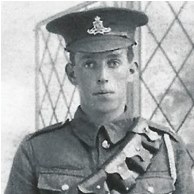 |
|
James Bowley was born at Blackbrook Hill Farm, Tickow Lane, Shepshed, in 1895 and was baptised at St. Botolph's Church, Shepshed, on 11th August 1895. He was the son of William Henry Bowley, farmer, and his wife Sarah Jane (née Hodgett) who were married at St. Botolph's Church on 9th April 1890. James had one brother Harry and two sisters Elsie and Lily. Between 1901 and 1911 the Bowley family moved to Lounds Farm, Shepshed Road, Hathern, and in 1911 both James and his brother Harry were working on the farm with their father. After James' mother died in 1907 James' father employed a housekeeper Ann Bradley Bott to look after the family. On 16th October 1913 James' father married Ann Bradley Bott at the Church of St. Peter and St. Paul, Hathern. James enlisted at Leicester in late 1915 and joined the 107th Battery in the 23rd Brigade of the Royal Field Artillery as Gunner 140922. His service record has not survived and nothing is known about where he was sent with his battery, except that he did not go to France until after the beginning of 1916. In 1916 James' battery took part in the Actions of the Bluff and St. Eloi Craters before moving to the Somme for the Battle of Albert (1st - 13th July), the Battle of Bazentin Ridge (14th - 17th July) in which they helped capture Longueval, the Battle of Delville Wood (15th July - 3rd September) and the Battle of the Ancre (13th-18th November). After the Battle of the Ancre the battery had a period of rest at Camp A, Baizieux, after which they moved to Winnezeele and Oudezeele where they continued to rest until Christmas Day 1916. From 25th December 1916 until the end of February 1917 the battery was in continuous action in the forward area at Ypres, strafing hostile movements and bombarding the enemy trenches. From 3rd - 20th February there was training at Muncq-Nieurlet followed by a period in Reserve at Herzeele. On the night of 10th/11th April the battery moved to the front line at Hill 60 south of Ypres near Zillebeeke where preparations were being made for a new offensive action. Hill 60 was bombarded on 26th April. After a further period in Reserve at Hardifort the battery returned to the forward area at Hill 60 on the night of 10th/11th May. Heavy firing on the enemy then took place until the end of May. The enemy retaliated by shelling roads and trenches. In June the battery supported the 2nd Army with an attack at Messines to capture the German defences on the ridge which ran from Ploegsteert Wood in the south, through Messines and Wytschaete to Mount Sorrel, the aim being to deprive the Germans of the high ground south of Ypres. After this operation from 7th-14th June the battery had a week's rest in billets at Boeschepe. The battery supported further offensive operations on the enemy lines at Zillebeke in July and August with one short break in camp. In one attack the battery fired 19000 rounds in 24 hours. Apart from two breaks in rest camp in September and October the battery continued harassing the enemy with fire. James was killed in action, aged 22, on 18th November 1917. He was buried at Solferino Farm Cemetery, Brielen, Grave II. B. 6. James is remembered on the Memorial Cross in Hathern and on the memorial in the Church of St. Peter and St. Paul, Hathern. |
|
|
|
|
|
Private M/340809 Stanley Bradshaw |
|
1011th Mechanical Transport Coy, Army Service Corps. Died of Pneumonia Egypt 3rd November 1918, Aged 31. Buried Alexandria (Hadra) War Memorial Cemetery Egypt. E. 125.
|
|
Stanley Bradshaw was born in Swannington, near Coalville, Leicestershire, in 1887. He was the son of John Henry Bradshaw and his wife Mary Jane (née Stanley) who were married in 1889 in the Ashby de la Zouch registration area. Stanley's father was a factory warehouseman, who, by 1911, had progressed to being a glaze maker at an encaustic tile works. Stanley had three brothers Ernest, William and Sidney and five sisters Mary, Harriet, Maud, Gladys and Constance.
After Stanley was born the Bradshaw family moved to 11 Temple Street, West Bromwich, and between 1891 and 1894 to Newhall, Derbyshire. By 1901 they were living at 57 Hall Street, Church Gresley, and in 1911 at 145 Wilmot Road, Swadlincote. They subsequently came to live at 92 King Street, Loughborough. In 1901 Stanley, aged 14, was a pipe yard labourer, but where he was in 1911 is unknown. Stanley probably enlisted some time in 1916 but as his service papers have not survived his precise date of enlistment is unknown. He joined the Army Service Corps (ASC) Mechanical Transport Section as Private M/340809 and is likely to have been sent for training to the Machine Transport Depot in Sydenham, Kent. All Mechanical Transport Companies of the ASC were part of the Lines of Communication and were not under orders of an Army Division, although some (unusually known as Divisional Supply Columns and Divisional Ammunition Parks) were in effect attached to a given Division and worked closely with it. Those in the Lines of Communication operated in wide variety of roles, such as being attached to the heavy artillery as Ammunition Columns or Parks, being Omnibus Companies, Motor Ambulance Convoys, or Bridging and Pontoon units. Little is known about Stanley's experience in the war. He is only known to have been sent to Egypt in 1916 or later. In Egypt the ASC had Mechanical Transport companies in various locations. The ASC General HQ was in the Northern Canal Section, together with the ASC Motor Boat Company. In this section they also had the 5th, 6th, and 29th Reserve Field Ambulance and Workshop Units, the Western Force Mechanical Transport Supply Company, an Advanced Mechanical Supply Depot at Samalut and No. 303 Mechanical Transport Company. There were also two Advanced Mechanical Transport Sub-Depots at Ismailia and Quantara. In the south-western section of Egypt they had the 338th, 493rd, and 619th Mechanical Transport Companies. In addition, some Mechanical Transport Companies were part of the 52nd and 53rd Divisional Trains of the Army. Stanley died of pneumonia, aged 31, on 3rd November 1918 in the 19th General Hospital, Alexandria, Egypt. He was possibly a victim of the worldwide flu epidemic. He was buried in Alexandria (Hadra) War Memorial Cemetery, Grave E. 125. |
|
Private 202287 John Tom Bradwick |
|
|
1/4th Bn. Royal Welsh Fusiliers. Formerly 25867 Bedfordshire Regiment. Killed in Action 6th October 1918, Aged 22. |
|
|
John Tom Bradwick was born in Loughborough in 1895. He was the son of John Edward Bradwick, a boiler driller and planer, and his wife Eliza (née Bland). John Tom had one brother Harold and one sister Dorothy. Another sister Lilian died in infancy. In 1901 the Bradwick family lived at 28 Hartington Street, Loughborough, but by 1911 had moved to 45 Burder Street. At the age of 15 John Tom had become a driller, like his father.
John Tom enlisted at Peterborough, Northamptonshire, in early 1916. The exact date of his enlistment is unknown as his service papers have not survived. He joined the Bedfordshire Regiment as Private 25867. After preliminary training John Tom was transferred, with a group of other soldiers from the Bedfordshire Regiment, to the 4th (Denbighshire) Battalion of the Royal Welsh Fusiliers and became Private 202287. This transfer took place around 22nd June 1916. The precise date on which John Tom was sent to France is unknown but the 4th Battalion of the Welsh Fusiliers received substantial batches of reinforcements on 6th and 15th July 1916 and it is likely that John Tom was in one of these batches. By 1916 the battalion had become part of the 47th (London) Division and had become a Pioneer battalion, probably because of the large number of miners in its ranks. The battalion spent the remainder of the war digging and repairing trenches, assisting in mining operations, constructing roads and tramway lines, often in the front line and in very hazardous situations. In mid-July 1916 the battalion was based at the Bois de Bouvigny, Pas de Calais, training and on trench work. On 17th July the battalion moved to the Berthonval and Carency sections for work on the front line and communications trenches and on mine dugouts. At the end of July there was training at Beugin. In August there was further training at Frohen le Petit, Yvrenchaux, Domvast and Bresle. At the end of August two companies moved to Fricourt to make and repair roads. September included road work at Mametz, trench work near High Wood and making artillery tracks near the Mamatz-Bazentin road. At the beginning of October the battalion was consolidating trenches south of Eaucourt l'Abbaye, cleaning the Flers line which had been damaged by shellfire, and making an artillery track from High Wood to Martinpuich. Between 13th and 20th October the battalion moved by train via Longpré and Pont Remy to Pioneer Camp, south of Vlamertinghe, on the Ypres Salient. For the rest of the month the battalion repaired the Decauville railway and the Brisbane Dump light railway, improved drainage systems and worked for the Canadian Royal Engineers on the Verbranden road, and on tunnelling. From November 1916 to May 1917 the battalion completed similar work in the area, much of it in the Bluff sector. They also constructed machine gun emplacements, revetted trenches, maintained railways and erected camouflage. During this time a number of hostile shells fell in Pioneer Camp. Towards the end of May the focus of the battalion's work moved to the Ypres-Comines Canal and tracks for wheeled traffic were made from Ouderdom and Dickebusch to the canal. At the beginning of June the battalion constructed trenches in the forward area in preparation for a 2nd Army offensive on 7th June - an attack on the Messines-Wytschaete Ridge. On 15th June the battalion HQ moved to Chippawa Camp on the La Clytte-Reninghelst road. Some training took place towards the end of June. At the beginning of July some men were working at Vierstraat, some were working on trenches south of the canal, some on tramway routes east of Vormezeele and some on a road from St. Eloi to Pheasant Wood. Towards the end of July work began on a new road from Spoil Bank to La Chappelle. On 31st July, the opening day of the Passchendaele Offensive, the battalion was at Ridge Wood, training and resting. On 15th August, for the first time in ten months, the battalion moved out of the shelled area. They entrained at Abeele for St. Omer and were taken by bus to the village of Bouvelinghem. Here there was training, regimental sports, and entertainment by the 47th Divisional 'Follies'. On 22nd August the battalion moved back by bus and march to the forward area near Belgian Chateau, south-west of Ypres. Here they worked on the light railways near Ypres and on the trench tramway from Hellfire Corner. They then began constructing a tunnel under the Ypres-Hooge-Menin road. On 18th September the battalion marched to Eecke, leaving the Ypres area after eleven very hard months, when nearly every day there had been casualties. On 27th September the battalion moved by march and rail to Aubigny, west of Arras and were billeted at Maroeuil. From here they worked on a new road from Roclincourt to Bailleul before moving to the forward area to improve accommodation. During October the battalion constructed a dugout and office south of Bailleul for the Divisional Observer, repaired the Arras-Gavrelle road, constructed an aid post north of Athies, extended the trench tramway system north of Arleux, and did salvage work. During the first three weeks of November the battalion's work included constructing trench mortar emplacements near Oppy, repairing the Bailleul-Oppy-Gavrelle road, and improving Mill, Towy and Beatty posts. On 21st November the battalion began a five-day move to Beaulencourt and on 27th November moved into the Cambrai sector, being quartered in huts, cellars and partly demolished houses in Bertincourt. The Battle of Cambrai was taking place and on 30th November the battalion moved up to the forward area to garrison the Hindenburg support line west of Flesquières in tactical reserve to the 142nd Brigade. The battalion carried ammunition and rations up to Bourlon Wood and on the return journey carried casualties down on stretchers. They also dug a new forward line under a heavy gas shell bombardment. Relieved on 6th December the battalion moved south of Havrincourt to dig new fire trenches and a new support line as well as well as to work on the switch line. After this they moved to Broken House dump to construct shelters for the whole battalion. On 21st December the battalion moved south-east of Ytres and then by rail to Aveluy and marched to Senlis. Training took place there until the end of the year. On New Year's Day 1918 the battalion marched to Albert station, entrained for Etricourt and marched to Equancourt. During January they worked on deepening and improving the front line south-east of Flesquières, built extra accommodation at Bertincourt, repaired the Havrincourt- Flesquières road, drained trenches and erected Nissen huts north of Ruyaulcourt, and dug a new fire trench near Trescault. During February work was done on the Ribecourt catacombs, the Flesquières and Bibecourt defences were wired and timber was cut in Havrincourt Wood for Divisional fuel. On 23rd February the battalion marched to Pioneer Camp, Lechelle, to wire new defences in Metz. At the beginning of March, in a blizzard, they dug and wired a new reserve trench in the forward part of the second system of the Battle Zone and also continued work on the metz defences. On 21st March, the opening day of the German Spring Offensive, amid a heavy hostile bombardment, the battalion was positioned in trenches in and around Metz and then occupied Dessart Ridge south-east of Metz. After the enemy broke through the front a withdrawal began during intense enemy machine gun fire. The battalion moved via Vallulart Wood, Rocquigny and Le Transloy to Les Boeufs. On 26th March, in Louvencourt, the men had their first night's rest in six days and there had been 238 casualties. During the last few days of March the battalion dug a line of rifle pits at Harponville before moving to Senlis with the Divisional engineers to dig a new support line along the Bouzincourt-Aveluy road to Martinsaart Wood. Work continued in this area until 6th April when two companies of the battalion were involved in an attack west of Aveluy Wood and incurred another 156 casualties. The battalion was then withdrawn to Senlis. On 6th and 8th April Senlis was twice hit by enemy gas, and although the battalion was moved to Puchevillers 138 men affected by the gas had to be sent to hospital. Between 11th and 13th April the battalion marched via Wargnies and Domqueur to Froyelles and Fontaine-sur-Maye where the men rested and trained until 28th April. At the beginning of May the battalion moved to Warloy for trench work until 16th May. They then moved to a camp south-west of Baizieux to do tunnelling work for the Royal Engineers. This was followed by further trench work at Dernancourt, Bresle and near the Albert-Amiens road where the men came under a hostile gas and high explosive enemy bombardment. On 18th June the battalion moved to Crouy for rest, training and sports until 10th July. They also had an outing to the seaside at Le Tréport. On 11th July the battalion returned by bus to Warloy and moved up to the front east of Henencourt Chateau to repair trenches. On 4th August they moved to Bois de Mai, north-east of Allonville, and then into a position south of the Bray-Corbie road. They began constructing a new trench system called the Battle line on either side of the Morlancourt-Etinehem road but work was often impeded by hostile gas shelling. After the Battle of Albert began on 21st August the battalion took up a position in the northern part of the main and support lines until 24th August. After a rest at Heilly they worked on road improvements in the area of Maricourt, Hardicourt and Maurepas. During September the battalion constructed a crossing over the Canal du Nord and worked on roads near Moislains before transferring by bus, train and march to Camblain Chatelain and then Essars for harvesting work in the forward area on either side of the Canal de la Lawe. Preparations now began for the 47th Division to move to Italy. On 27th September the Division marched to Ternas for training. On 2nd October the battalion was sent to St. Pol, entrained for Merville and marched to the Lestrem-La Gorgue area. The enemy had withdrawn from the Laventie front and the battalion moved forward to Petillon, near Fleurbaix, to work on the main road and a track from Le Mesnil to la Boutillerie and to repair the Erquinghem-Wavrin railway. On 6th October John Tom, aged 22, was killed in action. John Tom was buried in the Rue-De-Bois Military Cemetery, Fleurbaix, Grave II. B. 13. |
|
|
Private 201544 John Henry Bramley |
|
A Coy 1st Bn, Leicestershire Regiment. Died of Wounds at Home 18th October 1918, Aged 25. Buried Cardiff (Cathays) Cemetery, Glamorganshire, E.B. 86. (His Father Albert Bramley also fell see above)
|
|
John Henry Bramley was born in 1893 in Loughborough, and baptised on 17th December 1893 at Holy Trinity Church, Loughborough. John was the son of Albert Bramley and his wife Elizabeth (née Staniforth) who were married on 10th November 1888 at Holy Trinity Church, Loughborough. John had four brothers Albert, Arthur, Wilfred and Frederick and five sisters Sarah, Alice, Gertrude, Ida and Winnie. Four other siblings died young. In 1893 the family lived at 9 King William Yard, Loughborough, but by 1901 had moved to 65 Wellington Street. By 1911 they had moved again to 78 New King Street.
John's father had served in the Army from 1879 to 1891 in the 95th (Derbyshire) Regiment of Foot and its successor the 2nd Battalion of the Sherwood Foresters (Derbyshire Regiment). He had been posted to Gibraltar, Egypt and India and had been awarded the Egyptian Medal and the Khedive Star. After he left the Army he became a framework knitter and then a general labourer. When he left school John became a brickyard labourer. He enlisted at Leicester on 17th August 1915 and was posted to the 3/4th (Reserve) Battalion of the Leicestershire Regiment as Private 5127 (later renumbered as 201544). John's initial training took place at Grantham. On 17th April 1916 John was transferred to the 1/4th Battalion of the Leicestershire Regiment. In the spring of 1916 the 1/4th Leicesters were in the area of Talus de Zouaves, near Vimy Ridge, doing trench tours where they were subjectedto heavy enemy bombardment. On 23rd April the battalion moved to Mazières and then Savy for training until 9th May. Further moves followed to Le Souich and then Humbercamps for cable laying before a return to the trenches at Foncquevillers on 15th June. On 30th June the battalion moved to billets in St. Amand-les-Eaux in preparation for the start of the Somme Offensive. On 2nd July the battalion transferred to Hannescamps and was heavily shelled. At Bienvillers-au-Bois on 15th July they launched a gas and smoke attack on the enemy. After a short period in training at Pommier and some work on trench improvement they moved into the trenches at Monchy-au-Bois on 1st August and were again shelled. Apart from a week in the trenches at La Cauchie the battalion remained in the Pommier/Bienvillers area until 28th October. On 5th October 1916 John was sent back to England for reasons unknown and on 19th December posted to headquarters in reserve. Just over a month later, on 24th January 1917 he was posted to the 2/4th Battalion of the Leicesters. He joined the battalion, which had just returned from Ireland, at Fovant, Hampshire. On 24th February the battalion left Fovant Camp for Southampton and crossed the Channel to Le Havre. After a day's rest the battalion proceeded to Pont du Metz and from there to Fouencamps, Somme. On 1st March they moved to No. 59 Camp, Bayonvillers for four days rest before transferring via Foucacourt to the reserve trenches at Belloy and up to the front line on 11th March. By 17th March the enemy had retreated and the battalion occupied former German trenches. Between 21st and 20th March the battalion moved via Foucacourt, Eterpigny, Mesnil and Cartigny to Hamelet to support the 5th Leicesters in an attack on Hesbecourt and Hervilly. On 2nd April the battalion attempted to attack Fervaque Farm but found it too heavily wired. Moving on to Roisel they took over the line from Margicourt to Fervaque Farm and down to Grand Priel Woods, gradually pushing the line forward. Relieved on 19th April the battalion went to billets in Bernes until 28th April when they went to the support line from Le Verguier to north of Pieumel Woods. In May the battalion completed three trench tours, two in the front line near Ascension Farm and one in support north of Le Verguier, with nine days rest at Bias Wood camp. On 24th May John was once again reposted, this time to the 1st Battalion of the Leicestershire Regiment. He joined the battalion in the Loos area where they were on trench tours with breaks in billets at Les Brebis or Philosophe. In June the battalion was instructed, while in training at Verquin, to mount a series of small operation to give the enemy the impression that an attack was about to take place. In July Canadian forces took over in the area to attack Hill 70 and the battalion was withdrawn to the area of Monchy-Breton, proceeding by lorries to Magnicourt-en-Compte. After being briefly ordered to assist at the time of the gas shelling of Armentières, a brief period at Fleubaix, and time in the reserve line at La Boutillerie the battalion returned to Magnicourt on August 5th. At the end of August the Division returned to the Hill 70 front and went into reserve at a camp in Houchin. In September there were front and support line trench tours at Hill 70, Les Brebis and Cité St. Pierre. On 27th September John received a gunshot wound to his right hip and was sent from No. 32 Casualty Clearing Station, to No. 26 General Hospital, Etaples. By 12th October he had recovered sufficiently to be discharged to No, 12 Infantry Base Depot at Calais and he rejoined his battalion in Brigade reserve in the Cité St. Pierre on 19th October. From Mazingarbe on 21st October the battalion moved to Ligny-lez-Aire and then to Manin for training until 14th November. On 15th November the battalion entrained at Frévent for Péronne and marched to Moislains. After a couple of days under canvas at Dessart Wood the battalion moved forward to the front line at Beaucamp and on 20th November, the first day of the Battle of Cambrai, successfully attacked part of the Hindenburg Line. The battalion was relieved on 26th November and moved to another section of the front line near Noyelles where they suffered heavy enemy bombardment and shelling but nevertheless helped to achieve an advance to Gouzeaucourt. On 1st December the battalion was at Nine Wood and was heavily shelled before being relieved and moving to new positions on the Premy-Flesquières Ridge. On 5th December the battalion moved again to positions in the front line on the Hindenburg support system where they remained until 13th December. From 14th December until the end of the year the battalion was at Bellacourt undergoing training. In the early part of January 1918 the battalion was at Courcelles but on 18th went into the trenches on the Moeuvres front. Rest periods were taken at Luck and Lindop Camps near Fremicourt. On February 19th and 20th the battalion moved to the Lagnicourt area, where, when out of the line, they provided large working parties for work on the defences. There were now strong rumours that the enemy was preparing a large offensive and great efforts were made to obtain information through patrols and raids. On 15th March the front line company of the battalion managed to capture a propaganda balloon laden with ten copies of the Gazette des Ardennes, a paper published in French by the Germans for distribution among the inhabitants of occupied territory. On 17th March the battalion had gone back into Brigade Reserve. On 21st March 1918 the enemy launched their Spring Offensive. When the order to 'Stand To' in battle positions early on 21st March came through to the 1st Leicesters some of the men could not immediately be reached as they were detached on work elsewhere. The battalion nevertheless put up a determined defence. By the evening of 21st March, however, C Company had only 1 Officer and 37 Other Ranks left. On 22nd March the enemy put down a very heavy barrage and increased pressure all along the line. When the Germans advanced rapidly between the Lagnicourt to Maricourt Wood road and Vaulx Wood both C and D Companies of the battalion were practically destroyed. The battalion was then withdrawn to Berkeley Camp, Bihucourt, and then to Puisieux-au-Mont where, on 24th March, they entrained for Doullens. After a night at J Camp the battalion entrained for Proven. On 27th March the battalion moved to Winnizeele where reorganisation and training took place until 1st April. On 2nd April the battalion travelled via Ypres Asylum to Belgian Chateau Camp and on the next day proceeded into the front line in the Reutel sub-sector. This area was chiefly duckboard tracks, water, shell-holes and mud and much work was done on the trenches. On 11th April the battalion entrained for a camp at Belgian Battery Corner where they remained for two days. On 13th April the battalion moved, partly by bus, to Dranoutre and into the front line. After being heavily shelled for two days the battalion was withdrawn to a support position in a valley on the west side of Mount Kemmel. On 19th they moved into the front line for two days before being relieved and moving via Westoutre to Vancouver Camp, Vlamertinghe. Here they provided working parties. On 27th April the battalion moved to a new position at Kemmel from where the enemy was heavily defeated on the following day. On 1st-11th May the battalion was in Divisional reserve at Vlamertinghe for work on the Switch line. From 12th-16th May they were at Belgian Chateau carrying wire and stakes to the front line, but during this time a lot of the men were falling sick. The remainder of the month was spent in the support and front lines at Chateau Segard near Vormezeele and suffered a heavy bombardment of enemy gas shells On 18th May the battalion was sent to the front and support lines in the Chateau Ségard sector, near Voormezeele. During this trench tour they experienced enemy gas shelling and heavy artillery fire at night. On 26th May they moved to the Ravine in Brigade support and on the following day the enemy began a heavy bombardment, including gas shells, of the support lines and back areas. From 30th May - 6th June the battalion was back in the front and support lines at Chateau Ségard. The enemy restarted shelling, including ordinary gas shells as well as those containing sneezing gas. Hostile aeroplanes were also very active. The battalion was relieved on 6th June, their relief being hampered by another hostile gas shelling attack, and moved to Dirty Bucket Camp, about two miles north-west of Vlamertinghe. Here, after inspections and cleaning up, the battalion provided working parties for the Vlamertinghe, Brandhoek and Poperinghe lines and also attended Lewis gun classes. On 13th June 120 men became sick with influenza and on the following day 60 men were sent to hospital. The battalion was moved to School Camp near Poperinghe for further training and cases of flu continued to appear. The sickness is likely to have been the so-called 'Spanish flu', the first cases of which appeared in Belgium around this time. On 20th June the battalion entrained at Proven for St. Omer and marched to Musketry Camp, Cornette. Here the men had four days' practice in rapid loading, trigger pressing and field firing. On 25th June the battalion entrained at St. Omer for Mendighem and marched to Rainsford Camp near Watou where training continued. Additional training took place in the Hagebaert area near Poperinghe until 5th July. On 6th July the battalion went into the trenches in the front line of the Dickebusch sector. The trenches here were in a very bad condition and owing to the proximity of Mount Kemmel all movements were easily observed by the enemy. All available men were used carrying materials to the front line, often amid enemy action. On 10th July John was granted thirteen days leave to England. He rejoined his battalion on 23rd July when they were in action on the Vyverbeek line. On 25th July the battalion withdrew to positions in the right sector of Westoutre and worked at night on cable burying. From 3rd August the battalion was in support in the Dickebusch Lake sector, and from 6th-16th August held the front line. After being relieved they moved to Brigade reserve in the Dickebusch sector and were employed in working parties until 22nd August. On 23rd August the battalion entrained at Wellington Junction near Ouderdom, travelled by light railway to Winnezeele, changed trains for St. Momelin, and marched from there to Tilques. Training began on 26th and included practice in marshalling and escorting prisoners. On 29th August the battalion marched to Mentque for sports. From Mentque on 1st September the battalion entrained at St. Omer for Corbie and marched to Franvillers. From 3rd-10th September there was training in attack technique and open warfare. On 11th they moved to Daours and three days later to Monchy-Lagache by bus. Preparations were now made for an attack. On 17th September the battalion moved to the concentration area in Jean Devaux Wood where they were shelled twice and then through heavy rain, dense mist and shelling to Holnon Wood. During the concentration of troops on 18th September preparatory to an attack 50 casualties were sustained. The attack near Holnon began on 19th September and continued in stages until 24th September. John's service records do not include any details of where and when he was wounded but he was brought back to England and sent to a hospital in Cardiff. He died, aged 25, in Cardiff on 18th October 1918 and was buried Cardiff (Cathays) Cemetery, Glamorganshire, Grave E.B. 86. John's father Albert who served in the 17th Protection Company of the Royal Defence Corps during the war died of appendicitis in 1917. John's brother Albert (Junior) who served with the Army Service Corps, 11th Divisional Coy, Mechanical Transport, survived the war. |
|
Lance Corporal 22490 David Francis Brandon |
|
2/8th Bn, Sherwood Foresters (Notts & Derby). Killed in action 26th September 1917, Aged 36. Commemorated Tyne Cot Memorial panel 99 - 102 & 162 & 162a.
|
|
David Francis Brandon was born in Manchester in 1883. He was the son of Henry Brandon, a fish dealer, and his wife Caroline (née Bentley), a varnisher, who were married in West Bromwich in the summer of 1880. David would hardly have remembered his father who died in 1885 when David was only two years old. David's widowed mother moved with her children from Manchester to Leicester to live with her parents David and Elizabeth Bentley at 16 Dryden Street, Leicester. David had two brothers Henry and John. He also had a half-sister Doris Cadby Brandon born in Leicester in 1890. David's mother later moved to 60 Crafton Street and supported her children by working as a charwoman for the Board of Guardians. By 1917 she had moved again to 7 Kentish Street, Leicester.
David, aged 18 and a shoe hand, enlisted at Leicester with the Sherwood Foresters (Derbyshire Regiment) on 6th November 1900. As Private 6725 he was sent to the Depot until 21st February 1901 and posted to the 2nd Battalion at the Mtarfa barracks, Malta, on 5th July 1901. The battalion moved back to Britain from Malta in 1902, but just prior to this a draft of soldiers from the 2nd Battalion were transferred to the 1st Battalion in South Africa. David was in this draft and played his part in the final stages of the Boer War before its conclusion that year, being awarded the King's South Africa Medal. David was then sent with the 1st Battalion to Hong Kong where the troops carried out mopping up exercises and secured strategic objectives around Tien-Tsin and Peking after the Boxer Rebellion. Two companies were stationed at the British Legation in Peking and two at Tien-Tsin. A special force was also sent to Wei-hai-wei, a port on the Chinese coast. In August 1904 David, now a Corporal, was court-martialled for conduct prejudicial to good order and military discipline and sentenced to fourteen days imprisonment. In November 1904 the battalion was on the move again, leaving Taku Bar on their way to Singapore. About 1000 Sherwood Foresters arrived in Singapore on the SS Avoca on 12th December 1904 for their tour of duty. After two years in the Straits Settlements the battalion moved to India. David returned to England on 23rd January 1909, became a Reservist and completed his time in the army on 4th November 1912. By 1911 he had found living-in employment as a barman at the Old Dixie Arms, Humberstone Road, Leicester. When the First World War broke out David re-enlisted with the Sherwood Foresters. Although his WW1 service record has not survived it is known that as Lance Corporal 22490 he was sent to join the 1st Battalion in France on 18th March 1915. At that time the 1st Battalion was in the trenches at Pont du Hem. Trench tours continued in this area until 6th May when preparations began for an attack at Aubers Ridge on 9th May. After the battle the battalion did trench tours near Laventie, north-east of Béthune, with rest periods at Estaires. In mid-August the battalion moved to the Fleurbaix/Bois Grenier area. Here further trench familiarisation began and the battalion went into the front line sector in mid-September. At Bois Grenier on 25th September the battalion was in action in an attack to capture part of the German front line as an adjunct to the Battle of Loos. The battalion remained in the Bois Grenier area for a considerable time instructing inexperienced troops. On 3rd March 1916 orders were received to relieve the French 17th Division in the Carency sector, an area subject to severe shelling. After a break at Bruay in April the battalion moved back to the Souchez-Angres front line. In June the battalion went to Enguinegatte where intensive training commenced. On 25th June the battalion moved to Ailly-sur-Somme and in the Somme Offensive took part in the Battle of Albert from 1st to 10th July. On 11th July the battalion withdrew to Dernancourt and then to billets at Bresle. August was spent either resting in Béthune or in the trenches at Sailly-Labourse, September in the trenches or resting in the Fouquières area and the first half of October at Sandpits Camp near Albert before moving to Trônes Wood south of Longueval. In mid-November the battalion left Trônes Wood for the Château de Selincourt, near Dieppe, to undergo further training. On 6th November 1916 David was admitted to No. 10 British Red Cross Hospital (known as the Lady Murray's Hospital) at Le Tréport. He was suffering from dysentery and had been sent there by train from Corbie. He was discharged to duty on the following day. In mid-November the battalion left Trônes Wood for the Château de Selincourt, near Dieppe, to undergo further training. On 29th December the battalion left Selincourt and entrained for Albert. From 26th January to 4th March 1917 the battalion was operating in the Bouchevesnes sector, after which they moved via Moislains and Nurlu to Heudicourt. The Germans were retreating to the Hindenburg Line and the Allies were planning an attack on the enemy at nearby Gouzeaucourt. David must have been on leave in England at the end of March 1917 as he was married on 26th March at Emmanuel Church, Loughborough, to Beatrice Ellen Sharpe who lived at 31 Granville Street, Loughborough. David is known to have been transferred to the 2/8th Battalion of the Sherwood Foresters at some point after November 1916 but his precise date of transfer is unknown. The 2/8th Battalion arrived in France on 23rd February 1917 and, given that David was on leave in the latter part of March 1917 his transfer may have taken place in April 1917. In April 1917 the 2/8th Battalion had just had its first taste of trench warfare at Le Verguier north-west of St. Quentin. On 19th April the battalion was sent to dig trenches at Hesbicourt prior to a short break at Hervilly. In May they were in the trenches at Harbicourt and then went to Hamelet for thirteen days rest and training before moving into a quarry area to strengthen the line and carry out essential wiring. After the quarries were shelled the battalion withdrew to Equancourt and moved to Neuville-Bourjonval. On 6th June they began a trench tour at Havrincourt Wood. Between 11th and 22nd June they were training at Equancourt and for the rest of the month in the support trenches at Gouzeaucourt Wood. On 1st July the battalion went to the front and support lines at Beaucamp. From 9th July until 30th August they were at Le Mesnil and Aveluy for training and tactical exercises. On 31st August the battalion began a move to the Ypres Salient via Beaucourt and Gomovdewaersvelde to a camp near Wormhoudt for further training. On 20th September they marched to Watou, on 23rd moved to Brandhoek, and on 24th to Wieltje. On 26th September 1917 they went into action at the Battle of Polygon Wood (a phase of the 3rd Battle of Ypres or Passchendaele) and David, aged 36, was one of 43 Ordinary Ranks killed. David is remembered on the Tyne Cot Memorial, Zonnebeke, Panels 99 - 102 & 162 & 162a. David's brother Henry who also served with the Foresters died of wounds on 2nd December 1917. In 1919 David's widow married Frank Ward in Loughborough. |
<
|
Private 14763 Herbert Brett |
|
10th Bn. Lancashire Fusiliers Killed in Action 6th July 1916, Aged 17. |
|
Herbert Brett was born in Walworth, Camberwell, London in 1898, the son of Frederick Ernest and Alice Brett (née Lucas) who were married on 4th April 1886 at St. Mary's Church, Peckham, Camberwell. Herbert had seven brothers Charles, Alfred, Henry, Frank, Thomas, Albert and John and one sister Isabel. Herbert's father was a fishmonger. In 1891 the family lived at 2 Millais Street, Camberwell. By 1901 they had moved to 2 Sutherland Square, Newington, and by 1911 to 14 Westhall Road, Camberwell. They later moved to 9 Camberwell Grove, but by this time Herbert had left home and moved to Loughborough.
Herbert enlisted at Deptford, London, and joined the 10th (Service) Battalion of the Lancashire Fusiliers as Private 14763. His dates of enlistment and of joining his battalion in the field are unknown. The 10th Battalion was raised in Bury as part of Kitchener's Second New Army and joined the 52nd Brigade, 17th (Northern) Division. After initial training close to home the Division moved to Bovington Camp, Dorset, to continue training and then in late May 1915 moved to Hursley, near Winchester in Hampshire. The Division had been selected for Home Duties but this was reversed and they proceeded to France landing at Boulogne on 15th July 1915, concentrating at Tilques, near St. Omer. They next moved into the Southern Ypres Salient for trench familiarisation and then took over the front lines in that area. In the spring of 1916 they were in action at the Bluff, south-east of Ypres on the Comines Canal. They then moved south to the Somme, seeing action during the Battle of Albert in which the Division captured Fricourt on 2nd July 1916. Herbert was killed in action on 6th July 1916, aged 17. His body was never found and he is commemorated on the Thiepval Memorial, Pier and Face 3C-3D. Herbert's brother Charles Brett served with the Royal Horse Artillery and Royal Field Artillery and was killed in action near Ypres on 12th January 1918. His brother Frank served as a Gunner with the Royal Field Artillery (London Brigade) and survived the war. |
|
Second Lieutenant Harry Hedley Brewin |
|
Z Coy. 2nd Bn, Hampshire Regiment. Killed in Action 12th August 1918, Aged 25. Buried Borre British Cemetery, II. G. 23.
|
|
Harry Hedley Brewin was born in Loughborough in 1893 and baptised at Holy Trinity Church, Loughborough, on 7th May 1893. He was the son of John Henry (known as John Harry) Brewin and his second wife Emma (formerly Stockley, née Whitaker). Harry's parents, who were both widowed, were married at All Saints Church, Loughborough, on 19th November 1889. Harry's father was a warehouseman for a hosiery manufacturer. At the time of Harry's birth his parents lived at 13 Hume Street, Loughborough.
Harry had three half-sisters Edith, Betsy and Florrie from his father's first marriage to Jane Ann Cox, who died in 1888. He also had a half-sister Florence from his mother's first marriage to Walter Stockley, a railway inspector, who was run over by a shunting engine at Brick Lane, London, in 1881. Harry's mother died in 1898 and five-year old Harry went to live with his mother's sister Martha White and her husband Charles at Lyndhurst Villa, 1 Monson Road, Redhill, Surrey. Harry attended St. Matthew's School, Redhill, and when he left, he was employed as a clerk by the East Surrey Water Board. For some years he was a member of the choir of Reigate Parish Church. Harry's father remained in Loughborough, and was looked after by his daughter Betsy, and then by his daughter Florrie. He died in 1916. Harry enlisted in December 1914 and was sent to the Army Pay Corps (APC) as Private 4408. He was subsequently promoted to Lance Corporal. The Offices of the Army Pay Corps performed a very important service for all soldiers serving their country in the Great War, a role which has been little studied. They ensured that each soldier received his pay on time and knew that his family was provided for through a series of family allowances. There were 28 Army Pay Offices in the UK and each APO was responsible for a number of corps and regiments in the British Army. Their workload increased dramatically as the war progressed and the offices were compelled to employ large numbers of unskilled women. By 1917 Pay Offices maintained nearly 10 million accounts, of which four million were for soldiers, two and a half million for wives and dependants and over three million for children. The Separation Allowance paid to soldiers' wives and dependants was changed seven times during the war, involving the issue of arrears to over two million dependants on each occasion. Each Pay Office also had to deal with a mountain of documentation and correspondence every day. Some of the correspondence was from soldiers' wives who did not know their husband's exact location or regimental number, and some of the correspondence was only semi-literate. To add to the confusion, it sometimes happened that two or three men with the same name and initial enlisted on the same day, at the same place. These soldiers often had to be written to for the names and addresses of their dependants, and sometimes added complications arose if the men had been killed or died in the meantime. It seems that after September 1916 Harry transferred to the Infantry. As he needed infantry training he was then sent to the Training Reserve as Private TR/10/37789. After training he was posted to the Duke of Cambridge's Own (Middlesex Regiment) as Private G/92916. In 1917 he went to Officer Cadet School to prepare for a Commission. On 20th December 1917 Harry married Olive Fanny Sanders, a schoolteacher, at St. Matthew's Church, Redhill, Surrey. Harry's wife then moved from the YWCA in Redhill where she had been living to 20 Howard Road, Reigate, Surrey. On 30th January 1918 Harry was commissioned as a Temporary 2nd Lieutenant in the Hampshire Regiment. He joined the Z Coy of the 2nd Battalion of the Hampshire Regiment on 27th June 1918. At this time the battalion was training at a camp at Lumbres, south-west of St. Omer and remained there until 18th July. On 19th July the battalion marched to Pont d'Asquin via Wizernes, Blendecques, Arques and Belge Croix and bivouacked there. On 22nd July they proceeded to Bavinchove near Cassel via Ebblinghem and Le Nieppe. Training continued until 25th July when the massed drums of the 88th Brigade beat the retreat in the main square of Cassel. On 30th July the battalion marched to a new camp east of Eecke for work on the Army line until the end of the month. On 2nd August the battalion took over the front line near Merris, moving to the support line behind Strazeele two days later. On 9th August they returned to the front line and a small successful operation to straighten the front line took place. On 12th August the enemy counter-attacked with a considerable bombardment of the forward areas and Harry, aged 25, was killed in action. Harry was buried in Borre British Cemetery, Grave II. G. 23. He is remembered on memorials at St. Matthew's Church and Holy Trinity Church, Redhill, on the memorial at St. Mary's Church, Reigate, and on the Borough of Reigate war memorial in the Town Hall, Reigate. Harry's widow was remarried on 30th August 1924 at Christ Church, South Nutfield, Surrey, to Edward Walter Whitaker. |
|
Sergeant 13244 John William Briggs DCM MM |
|
|
8th Bn, Leicestershire Regiment. Commemorated Tyne Cot Memorial panel 50 & 51.
|
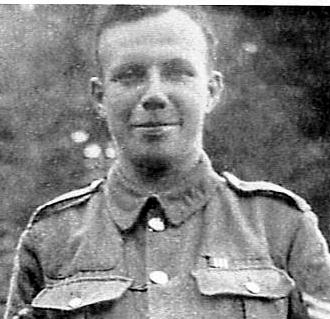 |
|
John William Briggs was born in Louth, Lincolnshire, in November 1894. He was the son of George Briggs and his wife Emma (née Atkin) who were married at Holy Trinity Church, Louth, on 10th August 1893. John had three brothers George, Jim and Jonathan. Another sibling had died at birth. In 1901 the Briggs family was living at 8 Little South Street, Louth, and John's father was a time and store keeper for a wallpaper mill. By 1911, however, they had moved to 15 Windermere Street, Leicester, and John's father was now a manager of a wallpaper store while John, aged 16, was an apprentice cabinet maker. John's widowed grandmother, Ann Briggs, was also living with the family. John subsequently moved to Loughborough and took a job as assistant manager to Mr. J. E. Hodgson at the Universal Trading Company, Baxter Gate. John enlisted at Loughborough on 3rd September 1914 and joined the Leicestershire Regiment. From the Depot on 24th September he was posted to the 8th (Service) Battalion as Private 13244 and sent to Aldershot for training. He moved to Shorncliffe in Kent at the end of February 1915. On 2nd April 1915 John married Elsie Emma Hodgson, the daughter of his former manager at the Universal Trading Company, at the Baxter Gate Baptist Chapel in Loughborough. When John returned to his battalion his new wife went to live at 3 Radmoor Rd, Loughborough. In April 1915 John's battalion became part of the newly established 37th Division of Kitchener's 2nd New Army and the Division began to concentrate on Salisbury Plain. On 25th June the units were inspected by King George V at Sidbury Hill. On 22nd July the Division began to cross the English Channel and Walter travelled to France on 29th July 1915. Initially the 37th Division concentrated near Tilques. The 8th Battalion then moved via Watten, Houlie, St. Omer, Eecke and Dranoutre to Wulverghem and Berles-au-Bois, a short distance from the front line. In the months that followed the 8th Battalion did tours in the trenches, alternating with the 6th Leicesters who relieved them. They were involved in operations in Bailleul, Le Bizet, Armentières, Mondicourt, Beauval and Berles-au-Bois. In April 1916 John had moved with the 8th Leicesters to the Doullens area for six weeks cleaning up, resting and training. In mid-May they returned once more to the trenches in the Bienvillers-Bailleulmont sector, but nearer Gommecourt. In June there was a series of nightly excursions into No-Man's Land with patrols attempting to gather information on the enemy's dispositions. On other occasions there were working parties out repairing the British barbed wire entanglements. The situation became increasingly hazardous as the month wore on when the Germans began to use a new and more accurate type of trench mortar. The 8th Battalion did not participate in the first days of the Somme Offensive but was held in reserve. On 6th July John's battalion left billets at Humbercamps and marched to Talmas, continuing on the following day to billets in Soues. On 10th July the battalion marched to Ailly-sur-Somme, entrained for Méricourt and travelled from there by lorry to bivouacs in Méaulte. Between 10th and 13th July the battalion was in the trenches near Fricourt and subjected to fairly continuous enemy fire. On the 14th July the battalion was in action at the Battle of Bazentin Ridge. After the battle the battalion withdrew to Ribemont and then to Méricourt, and having entrained for Saleux, marched to Soues. From Soues the battalion moved to Longeau, Gouy-en-Ternois, Lattre St. Quentin and then to Arras where they went into the trenches on 29th July. Casualty figures for the battalion in July had been high: 17 officers and 415 other ranks had been killed, wounded or were missing. The battalion went into Divisional Reserve at Agnez-les-Ouisans on 8th August but went back into the trenches at Arras on 18th August where they were on the receiving end of trench mortar bombs and heavy shells until 2nd September. On 1st September John became ill and was sent to a Field Ambulance. He rejoined his battalion on 7th September in rest billets at Lignereuil. On 13th September they marched to Frevent and entrained for Dernancourt. On 15th they reached a point between Fricourt and Méaulte before proceeding to Trônes Wood on 16th. From 17th-23rd September the battalion was in reserve and supporting the troops in the front line by providing carrying parties. In the evening of 24th September the battalion marched up to take their position ready for an attack but before they reached this point the men were heavily shelled by the enemy. Just after midday on 25th September the 8th Leicesters launched a successful attack in waves on the right of Flers and then pressed on to Gueudecourt. Considerable losses, however, were suffered in this action. After Morval the battalion withdrew to Dernancourt, entrained for Longpré and marched to Pont Remy before transferring to the Hohenzollern Reserve, support and frontline trenches. The battalion remained in the Hohenzollern sector, with breaks at Mazingarbe and Vermelles until 15th December when they marched to billets in the candle factory at Béthune. On 16th October 1916 John had been appointed a Lance Corporal (unpaid), his new position being confirmed with pay on 25th of the same month. On 19th December 1916 he was promoted again to Acting Corporal. From Béthune the battalion moved to Auchel where they remained until 26th January 1917 and underwent training. On 28th December the troops were entertained by a Lena Ashwell concert party. From Auchel the men moved to Winnezeele to continue training in tactical manoeuvres before returning to Béthune and the front line trenches at Sailly Labourse. In April 1917 the battalion moved to Hamelincourt and occupied the Outpost Line on the Hénin-Croisilles road until 13th April, then transferred to Bailleulmont for training before going into support at St. Leger. On 3rd May the battalion took part in an attack on the village of Fontaine-lès-Croisilles where casualties were high. After the attack the battalion bivouacked at St. Leger before going back into the line on 9th May. On 11th May the battalion marched to Berles-au-Bois for musketry training and practice in tactical schemes, brigade sports and inspections which lasted until the end of May. On 1st June the battalion marched to huts in Hamelincourt for additional training in bombing and rifle grenades and field exercises until 7th June. On the night of 7th/8th the battalion went into the trenches in the Hindenburg Line. From there they attacked the enemy on 15th June but were compelled to withdraw. They remained in the front line until 19th June when they returned to camp at Hamelincourt. A period of rest at Blairville then lasted until 1st July, after which the battalion returned to Hamelincourt. On 9th July 1917 the battalion was in the trenches near Croisilles before going into Brigade Reserve. After one more front line trench tour at Croisilles the battalion moved to Camp A at Moyenville for eight days training. John was granted fifteen days leave on 3rd August and he rejoined his battalion on 18th August at a hutment camp in Ervillers. On 14th August John had been confirmed in rank as a Corporal. On 25th August the battalion moved by motor bus to Barly and from there, on the following day, marched to Ambrines. Two periods of training followed, firstly at Ambrines and then at Avesnes-le-Comte. On 16th September the battalion marched to Savy, entrained for Caestre and went into camp for more training. On 17th September John was appointed Acting Sergeant (with pay). On 23rd September the battalion began a series of moves, firstly to Meteren, then by bus to Hallebast before marching to Sint Hubertushoek and from there to Ridge Wood south-west of Ypres. On 30th September they moved up to the front line at Polygon Wood. On 1st October the enemy attacked the 9th Leicesters who were nearby and got possession of their front line. The 8th Leicesters went to assist but the enemy made repeated attacks. Counter-attacks were hit by a heavy enemy barrage in the neighbourhood of Joist Farm. On the night of the 2nd/3rd October the battalion was relieved and marched to Scottish Wood Camp. On 4th October the 8th and 9th Battalions of the Leicesters were amalgamated because of their high casualty rate. On 5th October the combined battalion moved to railway dugouts at Zillebeke and on 7th they went into the front line. The weather was very wet, the men suffered severely in the open trenches and shell holes and on 8th and 9th October 53 Ordinary Ranks were killed or wounded. Relieved on 11th October the battalion moved to Anzac Camp where the combined battalion was restored to two units. On 12th October the 8th Battalion entrained at Ouderdom station for Ebblinghem and marched to Le Croquet. From here three days later the battalion moved by motor lorry to the Gheluvelt area on the Menin Road for six days of cable trench digging. The men worked under heavy hostile barrages, moving to and from the area under shellfire. Between 17th and 22nd October 86 Ordinary Ranks were killed, wounded or went missing. John was one of those killed. He died on 17th October 1917, aged 22. Sergeant Briggs was awarded the Military Medal on June 16th 1917 and was recommended for another award for his gallantry between 1st and 4th October 1917. In a letter to his widow an officer of John's company wrote that: 'He was killed by a shell while leaving the line with a working party after having just completed a day's work. He suffered no pain, as death was instantaneous. He was one of the best N.C.O.s in the company and had done some remarkably fine work recently in actions in which the battalion took a prominent part. Everyone in the battalion deeply deplored his death, as he was most popular with the battalion'. Briggs received a posthumous award of the Distinguished Conduct Medal, with the citation as follows: 'For conspicuous gallantry and devotion to duty during a hostile attack. He took his Lewis gun forward as soon as the enemy barrage began, and, though the line was outflanked, he remained in an isolated forward position until his gun was put out of action. He then went back, obtained another gun, and kept it in action until the attack was beaten off. He showed the greatest courage and determination in a very difficult position'. John is remembered on the Tyne Cot Memorial, Zonnebeke, Panels 50-51. He is also commemorated on the Baxter Gate Baptist Church Memorial, Loughborough, and on the Carillon. John's widow was remarried to Charles A. Cullen, a widower with two small sons Charles and Clarence, in Loughborough in 1922. |
|
|
Sergeant 21688 George Harold Bright MiD |
|
11th Bn, Leicestershire Regiment. Died of Wounds 18th August 1916, Aged 24. Buried Gezaincourt Communal Cemetery I. D. 1.
|
|
George Harold Bright was born in Leicester in 1892, the eldest child of George Bernard Bright, a journeyman tailor, and his wife Elizabeth (née Hutchinson), a tailoress who later became a maternity nurse. George Harold's parents were married in Leicester in 1891 and they had thirteen children, ten of whom survived to adulthood. George Harold had three brothers Albert, Sydney and Frank and six sisters Grace, Hiverher, Rose, Ethel, Hilda and Daisy. In 1901 the family home was at 36 Fleet Street, Leicester, and in 1911 at 34 Dannatt Street, Leicester. George Harold's parents later moved to 96 Beatrice Road, Leicester. In 1911 George Harold was a hairdresser and still living at home.
By the time George Harold enlisted on 21st October 1915 he was a master hairdresser. He attested at Leicester and joined the 11th (Service) Battalion (Midland Pioneers) of the Leicestershire Regiment as Private 21688. Pioneer battalions were created to provide the Royal Engineers with skilled labour for building roads and trenches, but they were still fighting soldiers. The Midland Pioneers Battalion was formed at Leicester in October 1915 by the Mayor of Leicester and a local committee and on 29th March 1916 they left Southampton for Le Havre on the H.M.T Lydia, with their equipment on the H.M.T Rossetti. George Harold had been promoted to Acting Lance Corporal on 24th November 1915, a position confirmed on 10th February 1916. He was further promoted to Lance Sergeant on 18th March 1916. On 31st March the battalion left Le Havre and entrained for Hazebrouck and Poperinghe. They marched to Houtkerque on 1st April and three days later to Esquelbec where they remained until 15th April. Orders then came for the battalion to return to camps at Houtkerque for field working parties and instruction. On 16th July the battalion moved to Brandhoek for trench work in the area of Brandhoek and Ypres. In August 1916 the battalion was moved to the Gézaincourt area of France, south-west of Doullens in the region of the Somme. George Harold had now been promoted to Sergeant. He died of wounds received in action on 18th August 1916, aged 24. He was awarded a certificate from the King for conspicuous bravery in the field and for devotion to duty, was mentioned in Sir Douglas Haig's Despatches of 13th November 1916 and gazetted on 4th January 1917. George Harold is buried at Gézaincourt Communal Cemetery, Grave I. D. 1. He is remembered on the war memorial at St. Augustine's Church, Leicester. A newspaper report gave his former place of residence as Loughborough, but this remains unproven. |
|
Private 477109 John Henry Brookes |
|
Royal Canadian Regiment. Killed in Action 9th April 1917 Aged 25. Buried La Chaudière Military Cemetery, Vimy, VII.B.13. |
|
John Henry Brookes, often known as 'Henry' was born on 15th July 1891 in Loughborough, the son of Charles Edwin (known as 'Edwin') and Emma Brookes (née Mee) who were married at All Saints Church, Loughborough, on 24th December 1877. Edwin and Emma Brookes had eleven children, seven of whom survived. Edwin Brookes, called 'Nobs of Blue' by local people, was a framework knitter, then a firewood dealer, and subsequently a labourer. Emma Brookes was a mill hand, spinning wool. In 1881 the family lived at 7 Court B, Sparrow Hill, Loughborough.
In 1879 Edwin Brookes was fined for being drunk and disorderly in Loughborough and a year later was in court for stealing a shawl. In 1881 both Edwin and Emma were charged with assaulting William Hallam in Loughborough. In 1888 Edwin Brookes was sentenced to three months hard labour for unlawfully wounding his wife Emma. He struck her with his wooden leg, threw her to the ground and kicked her in the face. Emma Brookes was granted a judicial separation from him, with financial support for the children. Emma, however, clearly did not leave her husband as John Henry was born in 1891 and another son Edwin Edward in 1893. In addition, in 1891 Edwin Brookes was also charged with neglecting to send his children to school and in 1892 both parents were in court together for assaulting Violet Hodson. By 1901, however, Emma Brookes had finally left her husband. She was living at 25 Talfourd Street, Small Heath, Birmingham and working as a charwoman, washing and cleaning at the Pump Tavern Lodging House, Bull Ring. She had four of her children with her, including John Henry and Edwin Edward. Her husband Edwin Brookes, meanwhile, was back living with his parents in Loughborough, together with his son Albert. In 1907 John Henry (aged 16) and his brother Edwin Edward (aged 14), the latter described as a 'wastrel', were separately sent by the Middlemore Children's Emigration Homes organization, St. Luke's Road, Birmingham to Fairview Station, Halifax, Nova Scotia, Canada. John Henry arrived in Canada from Liverpool on 24th May 1907 on the SS Carthaginian and Edwin Edward on the SS Siberian in August 1907. By 1911 their father Edwin was in the Loughborough workhouse and he died in 1913. John Henry enlisted on 23rd August 1915 at Halifax, Nova Scotia as 'John Henry Brooks'. He was tattooed on both forearms and gave his occupation as a farmer. He joined the Royal Canadian Regiment (RCR) as Private 477109 and was one of 20 former Middlemore boys to join the regiment. In August 1915 the Regiment proceeded to England, where it was re-armed and re-equipped. It landed at Boulogne on November 1st, and on moving up the line it went into the trenches for the first time, with the First Canadian Division, opposite Messines. At the beginning of 1916 the Regiment went into the line with the 7th Canadian Infantry Brigade at Wulverghem, later moving to Kemmel and then to Ypres. The Regiment's first general action was in the German attack (June 2nd to June 5th) on Sanctuary Wood and Hooge in the Ypres Salient. Between June and August some extremely gallant trench raids and expeditions were carried out by the Regiment. In September 1916 the Regiment moved south with the Canadian Corps to the Somme, where until November they took part in very severe fighting at Flers-Courcelette, Regina Trench, and elsewhere. On 8th October at Regina Trench the RCR and one other battalion were the only Canadian battalions to capture and for the time hold objectives but with heavy loss. After the fighting on the Somme the Regiment was so depleted that it was obliged to reorganise. In November the Battalion moved north again to Neuville St.-Vaast, nothing of much importance happening with the exception of raids. John Henry Brookes, aged 25, was killed in action at La Folie Farm, Vimy, during the Battle of Vimy Ridge on 9th April 1917. He was buried at La Chaudière Military Cemetery, Vimy, Grave VII. B. 13. He is commemorated on the Canadian Virtual War Memorial under the name 'John Henry Brooks'. He was also remembered on the Talfourd Street Memorial, Birmingham (now lost). Edwin Edward also enlisted with the Canadian Expeditionary Force on 17th August 1915 as 'Edwin Brooks' at Camp Sussex, New Brunswick, Canada. John Henry and Edwin Edward's brother Albert joined the Leicestershire Regiment. Edwin Edward and Albert both survived the war. Edwin Edward returned to Nova Scotia to his wife. He changed his name to 'John Edward Brookes' before 1922 and became a lumberjack. Albert emigrated to Dandenong, Victoria, Australia. |
|
Private 8778 Joseph Brown |
|
|
2nd Bn, Manchester Regiment. Killed in Action 28th October 1914, Aged 34. Commemorated Le Touret Memorial panel 34 & 35. |
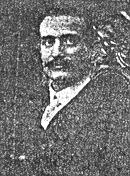 |
|
Joseph Brown was born in Loughborough in the summer of 1879. He was the son of George Brown and his wife Mary Ann (née Moult) who were married on 5th April 1874 at the Church of St. Leodegarius, Old Basford, Nottinghamshire. Joseph's father was a bleacher in a hosiery dye works and his mother an ironer dyer. The Brown family moved to Loughborough between 1876 and 1879 and firstly lived in Salmon Street before moving to 24 Rectory Place, then to 3 The Avenue, Gladstone Street, and finally to 34 Warner Place. Joseph had two brothers Charles and George and six sisters Clara, Florence, Alice, Annie, Jennie and Ada.
In 1893, when Joseph was 13 years old, his mother died and his older sisters took over the running of the household. By 1901 Joseph had become a joiner and builder and was boarding with the Ashmore family at 173 Quarry Road, Nottingham. He had also joined the Leicestershire militia. On 11th June 1903, at Ashton-under-Lyne, near Manchester, Joseph enlisted with the Manchester Regiment. He joined the Depot as Private 8778 and on 7th July 1903 was posted to the 2nd Battalion at Aldershot. In 1904 the battalion was sent to Guernsey and Joseph stayed there until 14th March 1906 when he was posted to the 3rd (Reserve) Battalion at Ashton-under-Lyne. On 28th October 1906 Joseph was posted to the 1st Battalion in India and he arrived at Secunderabad, South India, on 12th November 1906. In 1909 the battalion moved to Kamptee, Central India, and in 1911 to Jullunder, North India. On 19th April 1912 Joseph completed his service, returned to Loughborough and became a Reservist. He obtained employment at William Cotton Ltd. of Loughborough. When war broke out he was recalled and posted to D Coy of the 2nd Battalion of the Manchester Regiment. Joseph's battalion landed at Le Havre on 16th August 1914. The battalion then entrained via Rouen and Amiens to Le Cateau, marched to St. Vaast-Le Bavai and Hainin and was given orders to form a defensive line near Wasmes on the Mons-Condé Canal. Here they came under enemy attack, and similarly a few days later at Dours until they were ordered to retreat. On the 25th August the battalion was holding a line from St. Vaast to Houdain before retiring to Montay and then through Le Cateau. At Le Cateau the battalion was outflanked and lost about 350 men. The retreat continued through Maretz, St Quentin, Pontoise, Carlepont, and by 30th August they took up a line at Attichy-Bittry, north of the Aisne. On 3rd September the battalion was at Esbly were they crossed the Marne and reached Boulers in the evening. On 4th they marched through the night to reach Touran, only 15 miles from Paris. In the afternoon of that day the men heard the news that the retreat was over. The advance began on the 6th September. By 9th September they had reached the plateau near Limon and were engaged by the enemy at Prisseloup in the Battle of the Marne. The battalion advanced through shellfire towards where the enemy was entrenched but were held up by heavy fire from their flanks. In the morning the enemy was found to have retired during the night. On the 13th September the battalion crossed the Aisne on rafts and attacked St Marguerite, which was taken with little loss. The Battle of the Aisne came to an end on the 28th. On 12th October, the battalion formed a line near the La Bassée Canal. On the next day a general advance was ordered on Richbourg l'Avoué, but the advance was slow as every yard of ground was fought over for two days. By 16th October the enemy had withdrawn and the advance continued. By the 19th the battalion was at Les Trois Mansions and was attacked in force by the enemy. On 20th October there was heavy fighting all day. By the end of October the battalion had almost reached its limit. The men were exhausted from the battles at Le Cateau, the retreat and the Battles of the Marne and the Aisne, and once again they were holding a long line with exhausted troops and being attacked day and night. It was at this point, on 28th October 1914, that Joseph Brown, aged 34, was killed in action. It was not until February 1915 that Joseph's family learned what had happened to him. Joseph is commemorated on the Le Touret Memorial, Panel 34 and 35. |
|
|
Sergeant 8544 Herbert Browton |
|
1st Bn, Leicestershire Regiment. Killed in Action 20th November 1917. Aged 27. Buried Fifteen Ravine British Cemetery V. C. 16.
|
|
Herbert Browtoin 1890 was born in 1890 in Loughborough. He was the son of Thomas Browton, a dyer's labourer, and his wife Jane (née Mitchell) who were married on Boxing Day 1882 at All Saints Church, Loughborough. Herbert had one brother William. Another brother and sister died young. In 1891 the Browton family lived at 7 Warner Lane, Loughborough, but later moved to Pinfold Gate, firstly to No. 18 and then to No. 53. After Herbert's mother died in 1914 his father moved to 65 Herbert Street. Herbert attended Church Gate School under Mr. Judges. On 4th August 1908 Herbert, aged 18 and a hose trimmer, enlisted at Leicester to join the Leicestershire Regiment. As Private 8544 he was posted to the 2nd Battalion and by 1911 he was with the Regiment in Fort St. George, Madras, India. In August 1914 his battalion was in Ranikhet with the Indian Corps (Gharwal Brigade) in the Meerut Division and was ordered to proceed to France. The troops, under Major-General Charles Blackader, left Karachi on 21st September and arrived at Marseille on 12th October 1914. They then transferred via Orleans, Lillers and Calonne-Ricouart to the frontline trenches to relieve the 3rd Worcesters. For the next month they came under continued shellfire, bombing and sniping from the enemy but, nevertheless, continued to strengthen the trenches. In 1915 the battalion took part in the Battles of Neuve Chapelle (10th-13th March), Aubers Ridge (9th May) and the first day of the Battle of Festubert. The 2nd Leicesters spent the next couple of months alternately in the trenches or in billets while war training, in the area of Calonne and Vieille Chapelle north-east of Béthune. The battalion was then rested in a quiet sector before being deployed for the Battle of Loos (25th September-15th October 1915). The initial attack at Loos was made by three divisions, with the Meerut Division leading the attack on the Indian Front. Blackader's brigade, with two Gurkha battalions and the 2nd Leicesters was on its right flank. Whilst the attack successfully crossed no-man's land under cover of the barrage, the right flank of the brigade was caught up in defensive wire and only one battalion successfully made its way into the German trenches. Gas also affected some of the men and the smoke caused a dense fog, making direction difficult. The 2nd Battalion was rather depleted after the Battle of Loos, having incurred 427 casualties, but was ordered to Mesopotamia where Britain was fighting Turkish forces allied to the Germans. In Mesopotamia in 1916 the 2nd Leicesters were involved in the Battles of Sheikh Sa'ad (7th January1916), the Wadi (13th January) and Hanna (21st January), the attack on the Dujaila Redoubt (8th March) and the 1st Battle of Kut (5th-22nd April). Herbert's service record has only partially survived and some of the detail it contains is damaged to such an extent that it is totally unreadable. How long Herbert remained in France during 1914-1915 and whether or not he was sent to Mesopotamia are consequently unknown. At some point between 1914 and 1917 and for reasons unknown he was sent back to England and posted to the 3rd Battalion of the Leicesters, a training unit based at the Humber Garrison. In September 1916 he was promoted to Corporal and then Lance Sergeant and finally to Sergeant on 11th December 1916. On 10th June 1917 Herbert was again posted to France and embarked at Folkestone. Once there he was very briefly attached to the 8th and 9th Leicesters before joining the 1st Battalion in the field on 28th August 1917. At the end of August until 3rd September the 1st Battalion was in training at Houchin. On 3rd September the battalion moved into Brigade Reserve at Noeux-les-Mines and on the following day suffered a high explosive and gas shell bombardment. Working parties took place at Les Brebis until 10th September when the battalion moved into the front line at Hill 70. From 14th-22nd September the battalion was in the Support line at Bois Hugo. This was followed by two periods in Brigade support in cellars at Cité St. Pierre and another brief front line tour. On 28th September the battalion moved into Divisional reserve at Vaudricourt. October began with working parties at South Maroc and then five days training at Noeux-les-Mines. In mid-October the battalion was in the support and front line trenches in the St. Emile sector and also carrying out very heavy work in the communication trenches amid several heavy enemy bombardments. On 22nd October they entrained at Noeux-les-Mines for Ligny-lèz-Aire and began training in attack formations, musketry, and close order and box respirator drill. Training continued at Manin until 15th November. On 15th November the battalion entrained at Frévent and marched to Moislans. From Moislans they moved to Dessart Wood and began making final preparations for an attack. On 19th November the battalion moved to the assembly position at Beaucamp and on 20th November mounted a successful attack which succeeded in penetrating the Hindenburg Line. This was the first day of the 1st Battle of Cambrai and Herbert, aged 27, was killed in action. Herbert was buried at Fifteen Ravine British Cemetery, Villers-Plouich, Grave V. C. 16. Herbert's brother William enlisted in 1915. He was not, however, mobilised by the Royal Army Medical Corps until June 1918 on account of his flat feet. He survived the war. |
|
Private 20852 Douglas John Bryan |
|
16th Coy. Machine Gun Corps. Formerly 11538 Leicestershire Regiment. Died of Wounds 21st December 1917. Aged 19.
|
|
Douglas John Bryan was born in Stantonbury, Buckinghamshire on 18th August 1898. He was the son of William Perrin Bryan and his Scottish wife Grace Bell Ogden who were married in Stantonbury in 1895. Douglas had one older sister Doris and in 1901 the Bryan family was living at 34 Thompson Street, Bradwell, Buckinghamshire, with Douglas's widowed grandmother Mary Bryan. Douglas's father was a railway coach painter's labourer. In late 1901 Douglas's mother sadly died, aged 25, and at some point between 1902 or 1911 Douglas's maternal aunt Marion Faithful Brazier (née Ogden) left her husband and joined William Bryan and his children. On 1st August 1905 Douglas was entered as a pupil at New Bradwell School and his home address was given as Great Linford. By 1911 the Bryan family had moved to 10 Falcon Street, Loughborough, as Douglas's father had secured employment at the Brush Company works. On 27th February 1911 Douglas was fined 2s 6d at the Petty Sessions for playing football with six other youngsters at the Nottingham Road end of Ratcliffe Road. The 1911 census lists the occupants of 10 Falcon Street as William Bryan and his wife Marion Bryan (although they never married), Douglas and his sister Doris, and Bertie, Katie, Percy (registered at birth with the surname Brazier, but later taking the surname Bryan) and Elsie Bryan. These additional children were either cousins or half-siblings to Douglas. The family later moved to 6 Hartington Street. It is likely that Douglas enlisted in Loughborough in August 1916 when he was eighteen. He initially joined the Leicestershire Regiment as Private 11538 and was subsequently transferred to the 16th Company of the Machine Gun Corps as Private 20852. Although Douglas's service papers have not survived he was probably sent to the Corps training centre at Belton Park, Grantham, and then to the Base Depot at Camiers, France. The precise date he was sent to France is unknown but it is likely to have been towards the end of 1916 or early 1917. Of the 170,500 men and officers serving in the Machine Gun Corps, no less than 62,049 became casualties of whom 12,498 were killed during the war. Not unsurprisingly the men of the Machine Gun Corps earned the rather gruesome nickname of the Suicide Club. In November 1916 the 16th Company of the Machine Gun Corps was in training at Béthune until 26th of the month when the company moved into the line near Le Quesnoy. The men remained in action here until 22nd December, with an occasional break at billets in Le Quesnoy. Christmas Day was spent at Béthune, but the company's war diary has the following sad little note: 'Nothing was sent to the Company from England except 6 tins of Xmas pudding'. On 27th December the men went into the line in the Hohenzollern sector and until 14th February 1917 were firing most days as well as repairing parapets, dugouts and other positions. On 15th February the company marched to Robecq for two week's training. On 1st March they went into the line in the Loos sector. Here the enemy shelled all the reserve lines on 8th and 10th March and Loos village on 13th and 14th March and the company responded with heavy firing. In early April the enemy shelled Les Brebis, Maroc and Philosophe, followed by heavy shelling of the allies' trenches. On 25th April the company was moved to the St. Elie sector near Vermelles and four days later was on the receiving end of enormous enemy gas shells. On 11th May company headquarters was moved to Mazingarbe. On 20th May enemy machine guns attacked the front and support lines and there was a big explosion at Hulluch. Half of June was spent in the line at Mazingarbe firing at day or night and the other half in training. On 30th June company headquarters moved from Mazingarbe to the entrance to the Hulluch Tunnel where day or night firing continued and 60 tons of gas was discharged over the enemy trenches. Relieved on the night of 24th/25th July the company went by bus to billets in Bailleul-aux-Cornailles for cleaning up, training and brigade sports until 23rd August. From late August until mid-October the company was back in the line near Les Brebis and carrying out harassing night fire, with one break at Noeux-les-Mines. Further training then took place at Noeux-les-Mines, followed by a tactical exercise in machine gun barrage at Brevillers. On 14th November the company entrained at Bouquemaison for Peronne and marched to Moislains and then to No. 2 Camp at Fins. After three days in the line at Villers Plouich the company moved to the Hindenburg support line near Nine Wood on 21st November. On 30th November the company formed a defensive line from the western outskirts of Gouzeaucourt to Villers Plouich and experienced heavy enemy machine gun fire and shelling. After the company returned to the Hindenburg main and support line on 2nd December there was a very heavy enemy barrage on all trenches on 3rd December. 21 Ordinary Ranks were wounded, 2 were killed and 2 were wounded and missing. It is likely that this was the day Douglas was wounded. He was taken to a hospital in Le Tréport and died of his wounds on 21st December 1917, aged 19. He was buried at Mont Huon Military Cemetery, Le Tréport, Grave VI. C. 14B. |
|
Sergeant 41087 Charles William Bugden |
|
1/4th Bn, Leicestershire Regiment. Formerly 9199 Royal West Kent Regiment. Died of Wounds 28th October 1918, Aged 36.
|
|
Charles William J. Bugden was born in Ulcombe, Kent, in 1882 and baptised at All Saints Church, Ulcombe, on 26th November 1882. He was the son of William Bugden, a farm labourer, and his wife Mary Jane (known as 'Polly', née Price) who were married on 27th October 1877 at the Ebenezer Chapel, Sutton Valence, Kent.
Charles had three brothers William, James and Harry and two sisters Alice and Rosa. Another sister Grace died in infancy. In 1891 the family lived at Pie Corner Road, Ulcombe, but then moved to Baker's Farm, Ulcombe. Charles's parents later lived at Walnut Tree Cottage, East Sutton, Maidstone, Kent. On 12th March 1901 Charles enlisted and joined the 3rd (Militia) Battalion of the East Kent Regiment (the Buffs) as Private 6239. He completed 49 days drill on enlistment and on 7th July 1902 was embodied (became full-time). On 28th July 1902, however, he purchased his discharge. On 20th April 1905 he married Bessie Rose in Ulcombe and he and Bessie had three daughters Annie, Beatrice and Charlotte. In 1911 Charles was a farm labourer and was living with his wife and family at Hermitage Cottage, Barming, Kent. Charles, a Reservist, reenlisted at Maidstone on 10th August 1914. On 21st August 1914 he was posted as Private 9199 to the 3rd (Reserve) Battalion of The Queen's Own (Royal West Kent Regiment). This was a depot/training unit which moved on mobilisation to Chatham. On 29th November 1914 he was transferred to the Army Cycling Corp. On 10th March 1915 Charles was promoted to Lance Corporal and to Corporal on 25th May 1915. In October 1915 he was again promoted to Lance Sergeant and then Sergeant. In June 1916 Charles spent eleven days in Chiseldon Military Hospital near Swindon with an abrasion to his face. On 20th December 1917 Charles was sent to France and on Christmas Day 1917 was posted to the 1/4th Battalion of the Leicestershire Regiment as Sergeant 41087. At the time the battalion was in the line near Beuvry. Relieved on Boxing Day the battalion moved to Annequin and provided carrying and working parties. The period from 1st to 18th-January 1918 included two trench tours in the Cambrin sector, rest and training at Beuvry, and working parties to clear the communication trenches at Annequin of snow and water, On 19th January the battalion moved to billets in the tobacco factory at Béthune and from there, on the following day, marched to Mont-Bernanchon. Here training on any large scale was impossible as the ground was under cultivation or water but a certain amount of arms drill and musketry training was carried out. The battalion received orders to work on wiring for the Royal Engineers but this did not begin until 25th as the materials had not arrived. Wiring continued until 1st February when the battalion marched to Busnes. Training and reorganisation took place at Busnes until 8th February when the battalion marched to Westrehem. The battalion was now ordered to seize the crossing of the River Lys between Delette and Dennebroeucq. This was done and the battalion moved to Coyecque to continue training until 1st March. On 1st March the battalion began a four-day move via Flechin, Manqueville and Noeux-les-Mines to the trenches in the Cambrin south sector. On 7th March they shot down an enemy propaganda balloon which contained a copy of Gazette des Ardennes. Several days in Brigade support at Annequin and Sailly-Labourse followed when the men provided working parties. After this there was a return to the trenches in the Cambrin north sector where they were shelled by the enemy. Following a break at Beuvry the battalion went into the front line in the Hohenzollern sector. Here they were heavily trench-mortared by the enemy who endeavoured to break through the front. As the enemy was now expected to attack between Hill 70 and La Bassée the battalion was ordered to move to the Hill 70 sector. Relieved on 6th April the battalion moved to Les Brebis for a rest and to provide working parties. Returning to brigade support on 9th April the battalion suffered an enemy gas attack. After a brief return to the front line the battalion was relieved on 12th April and began a three-day move to Bois de Froissart Camp, Hersin, where a large number of men were sent to hospital suffering from influenza. On 26th April the battalion marched to Fouquières and into brigade support near Essars which was shelled on 29th and 30th April. During the night of the 2nd/3rd May the battalion relieved the 5th Lincolnshires in the left sub-sector of Essars. On 4th May the enemy put down a heavy barrage and two Ordinary Ranks were killed and 120 wounded. On 6th May the battalion was relieved and marched to Vaudricourt where the men attended a workshop for repairs to boots and clothing and their rifles and Lewis guns were inspected by the Armourer Sergeant. On 9th May the battalion, now in Divisional reserve, was ordered to move into position north of the Béthune-Beuvry road as an attack was expected. When the attack did not happen the battalion returned briefly to Vaudricourt before going into the front and support line trenches in the Gorre left sub-sector. While they were there the battalion headquarters was hit by enemy gas bombs and all the Officers and men there were affected. On 18th May the battalion returned to Vaudricourt. Men who had been in contact with gas went to the Field Ambulance to have their clothes disinfected in a Thresh disinfector and some men were sent to hospital. Back at Vaudricourt there were lectures on gas and tests in a gas chamber. The battalion returned to the support trenches in the Gorre sector on 24th May and on the following day at one point enemy gas shells fell every two or three minutes, forcing the men to wear their gas masks. The trench tour ended on 30th May after some heavy enemy trench mortaring and machine gun fire. During June the battalion completed trench tours in the front and support lines at Essars where they experienced further enemy gas shell attacks. When the front was quieter they provided working, salvage and carrying parties, repaired a light railway, improved their positions and sent out patrols. While resting at Vaudricourt all their gas respirators were tested at the Gas Hut, Verquin, and a sports and horse show took place. On 11th July the battalion was back in the trenches in support in the Gorre left sub-sector, providing working and carrying parties for the forward area. On 17th July they moved to the Gorre right sub-sector. Relieved on 21st the battalion went to Vaudricourt for a week's training and sports before returning to the Gorre right sub-sector until 4th August. From 4th-8th August the battalion provided salvage parties during the day and working parties at night and from 9th-14th August was at Vaudricourt for training and sports. Two more trench tours took place towards the end of August, during which there were signs that the enemy was retiring and the battalion pushed forward. The month ended with four days training. Following another trench tour and five days training the battalion entrained on 12th September for Méricourt l'Abbé where a tactical scheme was practised. On 18th September the battalion marched to Ribemont, travelled by bus to Estrées and marched to Tertry. While moving to the line near Tertry the battalion was badly bombed by enemy planes. At the front line they were shelled and on the receiving end of harassing enemy fire. The battalion then took part in a series of attacks - on Pontruet on 24th September, on Pike Wood on 27th September, and on Bellenglise and Magny-la-Fosse on 29th September. On 1st and 2nd October they held the line before Magny-la-Fosse and on 3rd October took part in a Divisional attack on the Fonsomme line, Ramicourt and Montbrehain. During the attack on 3rd October Charles was shot in the head. He was taken to No. 53 Casualty Clearing Station at Roisel and then to No. 6 General Hospital at Rouen. He died of his wounds on 28th October 1918, aged 36. He was buried in St Sever Cemetery Extension, Rouen, Grave S. III. C. 6. Charles is remembered on the Ulcombe War Memorial, Kent, as of the Royal West Kent Regiment. At some point between 1920 and 1921 Charles' widow and daughters left Kent and moved to 34 Moor Lane, Loughborough. |
|
Private 266432 Lawrence William Bunney |
|
1/5th Bn, Lincolnshire Regiment. Killed in action 3rd July 1916, Aged 21. Commemorated Thiepval Memorial Somme pier & face 1 C.
|
|
Lawrence William Bunney was born in Quorn in 1895. He was the son of Thomas Bunney and his wife Harriet (née Giles) who were married at St. Mary's Church, Wymeswold, on Christmas Day 1885. Lawrence's father was initially an agricultural labourer but by 1901 he had moved the family to 73 Wellington Street, Loughborough, and become a cowman and milk seller, while Lawrence's mother was a shopkeeper. By 1911 the family had moved to 40 Toothill Road and Lawrence's father was a horseman on a farm. Lawrences's parents later moved to 94 Corporation Road, Nuneaton, Warwickshire, but after Lawrence's father died in 1929 his mother returned to Loughborough.
Lawrence was one of ten children in the family. He had three brothers Arthur, George and Maurice and four sisters Clara, Lavinia, Lilian and Elsie. Two other sisters Florence and Annie died young. In 1911, when Lawrence was 16, he was a labourer at the Empress Works. He was also a member of the Borough band. Lawrence's service papers have not survived but he appears to have enlisted in late 1914 or early 1915. He joined the Leicestershire Regiment as Private 1873. After initial training he was sent to join the 1/5th Battalion in France on 18th August 1915. At the time the battalion was in the area of Zillebeke, south-east of Ypres, carrying out trench tours. For the remainder of August and in September the battalion remained in the area of Zillebeeke and Ouderdom before moving to Hesdigneul-lès-Béthune in October. The battalion then went into the reserve trenches at Vermelles for the attack on the Hohenzollern Redoubt on 13th October, sending reinforcements up to the front line. On 14th October the battalion supplied grenadiers and carrying parties for the front line. During the action the battalion suffered 199 casualties. Training took place at Hesdigneul until 25th October. On 26th October the battalion moved to Vaudricourt, with battalion headquarters at Drouvin and training continued until 4th November. From 5th-11th November the battalion was at Calonne-sur-la-Lys for inspections and parades. On 12th and 13th November the battalion moved into the trenches at La Couture, midway between Neuve Chapelle and Festubert. The trench tour lasted until 26th November. On relief the men moved to billets in the Rue des Chavattes. A much shorter trench tour took place in early December before the battalion moved to Merville and Thienne. At some point between September and December 1915 Lawrence was invalided home but there is no record of the circumstances. He apparently returned to France in early 1916, but as Private 266422 to join the 1/5th Battalion of the Lincolnshire Regiment, rather than the Leicesters. The 1/5th Lincolnshires returned from Egypt in early 1916 and arrived at Pont Remy on 11th February. From there they marched to Gorenflos where training took place until 20th February. Training then continued at Autheux. Between 24th February and 1st March the battalion moved via Bonneville, Beauval and Gelincourt to Doullens for another week's training. Between 6th and 8th March the battalion proceeded via Houvin and Aubigny to Villers-Châtel. On 10th March the battalion marched to Villers-au-Bois and took over the trenches west of the crest of Vimy Ridge, south of Souchez. On 15th March the battalion went into Brigade reserve in dug-outs in the Talus de Zouaves and in dug-outs on the road by the Cabaret Rouge. Working parties were supplied daily for work on the communication trenches, and on the 21st March the battalion returned to the front line for four days. There was then a break in Divisional reserve at Camblain l'Abbé. Another trench tour took place between 2nd and 8th April during which the enemy intermittently bombarded the line with trench mortars. The battalion then returned to Talus des Zouaves as Brigade reserve. On 13th April the Talus des Zouaves was very heavily shelled by enemy Howitzers. On 14th April he battalion returned to the trenches for four days before returning to Camblain l'Abbé. Between 20th and 22nd April the battalion moved to Penin for training until 28th April. This was followed by work on the Corps line near Mont St. Eloi from 29th April to 7th May. For the remainder of May the battalion rested at Sus St. Leger, felled saplings in the forest of Lucheux to make hurdles for the trenches, and prepared trenches near Fonquevillers for the forthcoming Somme Offensive. On 4th June the battalion began a trench tour, working on the assembly trenches for two weeks under some enemy machine gun, shrapnel and trench mortar fire. The battalion then provided working parties while based at Humbercamps until 26th June, after which they moved to Warlincourt. On 30th the men took up the assembly position east of Souastre ready for the opening of the Battle of the Somme. On 1st July the battalion advanced to a trench at the rear of Fonquevillers where they came under enemy fire. During the night of the 1st/2nd June the battalion made several unsuccessful attempts to move up and attack the enemy lines but was eventually ordered to withdraw, having suffered a number of casualties. On 2nd June most of the time was spent bringing in the wounded. Lawrence, aged 21, was killed in action on 3rd June 1916, while the men were repairing the trenches. His body was never found. He is commemorated on the Thiepval Memorial, Pier and Face 1C. |
|
Lance Corporal 41473 Almond Trevosa Burden |
|
22nd Entrenching Battalion. Formerly 11/13th Bn, Royal Irish Rifles and 35969 Bedfordshire Regiment. Died of Wounds 30th March 1918, Aged 34.
|
|
Almond Trevosa Burden was born in late 1883 or early 1884 in Brackley, Northamptonshire, his birth being erroneously registered as 'Almond Trevosso Burden'. Almond was the son of Alfred John Martin Burden and his wife Ann (née Radburn) who were married in Witney, Oxfordshire, in 1878. Almond had two brothers Alfred and Hildric and one sister Ethel. Another sister Elsie died at the age of three.
Almond's father, who was a local Methodist preacher, started out as a boot and shoe maker in High Street, Brackley. In 1884 the Burden family moved from Brackley to Leominster, Herefordshire, where Almond's father took a position as manager of a boot shop. By 1891 the family had moved again to Boston, Lincolnshire, and by 1901 they were at 123 Tavistock Street, Bedford, with Almond working an assistant boot salesman. Almond's parents returned to 20 High Street, Leominster, by 1911 but now Almond was living and working in Stoke on Trent, having become a manager in the retail boot trade like his father. Almond then moved to Loughborough and worked for Messrs Freeman, Hardy and Willis in Market Place. Almond attested for army service in 1915 but was turned down for medical reasons. He subsequently underwent an operation, after which, in the summer of 1916, he was accepted. He joined the Bedfordshire Regiment as Private 35969. Almond's service papers have not survived and the precise dates of his enlistment, transfer to the 11th (Service) Battalion (South Antrim) of the Royal Irish Rifles as Private 41473, and posting to France are unknown. The 11th Royal Irish Rifles received two batches of reinforcements in January 1917 and Almond may have been in one of these batches. At the time the battalion was in training at Aldershot Camp near the Neuve Eglise to Steenwerck road in north-eastern France. In February and early March the battalion completed four trench tours with breaks at Neuve Eglise and at Kortepyp Camp. On 14th March they moved to Rouge Croix for four days training and then to Wakefield Huts near Locre for working parties under the Royal Engineers until 5th April. After returning to the training area at Fletre for twelve days the battalion moved to the forward area for the remainder of April for working parties and specialist classes. For the first two weeks of May the battalion was in the trenches before moving to the Kemmel area on 21st May. Further working parties and a trench tour ensued before the battalion moved to Kemmel Hill and Camp M to plan for an offensive action. On 5th June they marched to Vroilandhoek and the assembly trenches. From 7th-9th June the battalion, as part of the 36th (Ulster) Division, took part in the Battle of Messines, the Division being tasked with taking one half of the village of Wytschaete, The objective was achieved, the battalion suffering 46 casualties. On 9th June the battalion was withdrawn to Kemmel Hill and moved to Boeschepe three days later. After two days resting in Divisional Reserve the battalion formed working parties to clear the battlefield. On 29th June the battalion moved to the area between Meteren and Merris and July was spent training at Tilques, Boisdinghem, Winnezeele and Watou. After moving to Brandhoek on 4th August the battalion entrained for Ypres and went into the line at Potitjze, having been shelled while in transit. Between 8th and 11th August heavy enemy fire and gas shells caused many casualties. Following a break at Brandhoek the battalion moved up to the assembly position at Wietje, prepared to attack in the Battle of Langemarck, but were driven back by heavy enemy shellfire After being withdrawn to Vlamertinghe and then Winnezeele the battalion entrained at Bavinchove for Miraumont on 22nd August and travelled by bus to Camp E, east of Beaulencourt where training commenced. At the end of August the battalion entrained at Ytres for Place Mortmare and went into the trenches. During September, October and early November there were further trench tours in the area of Ruyaulcourt as well as working parties and training at Neuville. On 13th November the 11th Battalion was amalgamated with the 13th Battalion of the Royal Irish Rifles and the new 11/13th Battalion returned to the trenches. In mid-November the battalion mainly rested at Bertincourt, B Camp at Barastre, and O'Shea Camp near Lebucquière. On 23rd November as part of the Cambrai Operations the battalion assembled for attack in the German system near Moeuvres. The enemy, however, took Moeuvres and the battalion was forced into a defensive position. 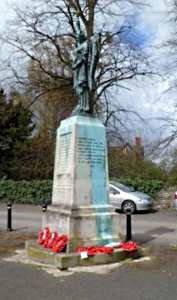 On 27th November the battalion began a six-day move to Metz which was shelled by the enemy just after they arrived. Ordered to take up a defensive line at Beaucamp the battalion was then sent to the front at Marcoing where the whole front line was enfiladed. The battalion returned to Metz but after another enemy bombardment there, moved to Etricourt. On 17th December the battalion entrained at Etricourt for Mondicourt and marched to Rullecourt, moving on to Warluzel the following day. After refitting the battalion entrained at Mondicourt for Boves and marched to Thézy on 28th December for training. January 1918 was spent at Bayon-Villers, Nesle, in reserve at Douchy and Essigny, and digging double trenches near Rouffy. In early February 1918 the 11/13th Battalion of the Royal Irish Rifles was disbanded in France and the troops were sent to the 22nd Entrenching Battalion. The battalion was at first positioned at Essigny and Grugies, both in the area of the 36th (Ulster) Division south of Saint Quentin but moved to Douchy on 11th February to work on cable trenches. The battalion then moved on 17th February to Misery, an aptly named village between Chaulnes and Peronne. Working parties were sent to Marchélepot, Brie and Villers-Carbonell, where the battalion was put to work under Canadian Railway Engineers. Unfortunately during this period the battalion had its Lewis guns taken away. The battalion was involved in the fighting against the German Spring Offensive, being ordered early on 24th March to move to Guillancourt and dig a defensive line from Rainecourt to Rosières. The left hand company then took part in a counter attack at Framerville. In the withdrawal that followed, the battalion ended up near Hangard. On 28th March the battalion, being the last reserve of the division, was literally plucked from dinner near Caix to mount a hasty counter-attack against some Germans who had turned up unannounced in the Division's left rear. The attack was remarkably successful and a much-surprised enemy beat a hasty retreat. At some point in the action between 24th and 29th March Almond, who had been promoted to Lance Corporal, was shot in the head. He died, aged 34, on the train taking him to hospital in Rouen, on 30th March 1918. He was buried in St Sever Cemetery Extension, Rouen, Grave P. VII. E. 12A. Almond is remembered on the War Memorial in Leominster, Herefordshire. |
|
Private 203316 William Burnham |
|
1/7th Bn, Hampshire Regiment Died Aden 27th January 1918, Aged 40. Buried Maala Cemetery Yemen E. 58.
|
|
William Burnham was born in Mountsorrel in 1877 and baptised at St. Peter's Church, Mountsorrel, on 3rd October 1877. He was the son of Alfred Cox Burnham and his wife Rebecca Ann (née Ablet, or Ablett) who were married on 24th November 1873 at St. George's Church, Leicester. William had two brothers Walter and John and five sisters Ada, Sarah Elizabeth, Annie, Mary Jane and Grace. Two other siblings died young. William's father was originally a corn miller, but he became a chimney sweep around the time that William's grandfather John Burnham, also a chimney sweep, died. In 1891 William himself was a sweep's apprentice, but by 1901 he also had changed trades to become a bricklayer. The Burnham family lived in Main Street, Mountsorrel but later moved to 2 Hawcliffe Road, Mountsorrel.
On 23rd February 1901 William married Mary Ann North, a hosiery machinist, at All Saints Church, Loughborough, and the young couple set up home at 49 Cambridge Street, Loughborough. By 1911 they had four children Alfred, Ida, Hilda and Grace and were living at 8 Paget Street. William's service papers have not survived but it seems that he enlisted at Loughborough in the spring of 1917 and joined the 2nd Battalion of the Leicestershire Regiment as Private 203316. At some point in late 1917 he was transferred to the 1/7th Battalion of the Hampshire Regiment. William was sent to join the 1/7th battalion when this battalion moved from India to the Garrison at Tawahi (then known as Steamer Point) in the Protectorate of Aden in January 1918. During the First World War Aden was of vital importance to Britain, allowing access to the African and Arabian coasts and as a fuelling station for ships en route to India and the Antipodes via the Suez Canal. Maintaining a military force capable of diverting the Turks between 1915 and 1918 was a demanding task due to the enervating sub-tropical hot desert climate and inhospitable terrain. During the war there was some action by the Aden Field Force defending the Protectorate from the Ottoman forces but sickness and the heat were responsible for a higher attrition rate than the Turks. William's exact date of arrival in Aden is unknown, but he died there on 27th January 1918, aged 40, not long after his arrival. When William died he was still known by his Leicestershire Regiment Service number rather than a Hampshire Regiment number, confirming that he had only been with the Hampshire Regiment for a very short time. William was buried in Maala Cemetery, Aden, Yemen, Grave E. 58. He is commemorated on the memorial in the former St. Peter's Church building, Loughborough, and on the Carillon. William's younger brother John, who also served with the Leicestershire Regiment, was killed in action in September 1915. |
|
Private 33860 Thomas Arthur Butler |
|
7th Bn. Norfolk Regiment. Killed in Action 8th August 1918, Aged 20.
|
|
Thomas Arthur Butler was born in Loughborough in late 1897. He was the son of George Henry Butler, a brickyard labourer, and his wife Marintha (née Swain Grundy) who were married in Loughborough in 1888. Thomas had two brothers Albert and George and four sisters Annie, Emma, Marintha and Ellen. Four other brothers had died young and Thomas's sister Marintha also died, aged 15, in 1916. In 1901 the Butler family lived at 21 Cradock Street, Loughborough, but by 1911 had moved to Court A, 3 Dead Lane. In 1916 the family was at 73 Pinfold Street and from 1919-1922 at 7 Court E, Pinfold Gate.
Thomas, a labourer, enlisted on 20th May 1916. He was allotted to Army Reserve and mobilised on 5th September that same year. He was initially sent to Norwich to train as a Driver for the Royal Field Artillery. On the 2nd October, however, he was admitted to the Military Hospital, Lakenham, suffering from palpitations, dyspepsia, and tachycardia on exertion. After he was discharged from hospital on 25th October he was posted to Edinburgh to the 104th Young Soldier Battalion of the Training Reserve. On 15th January 1917, however, he was admitted to the 2nd Scottish General Hospital at Craigleith, Edinburgh, with a recurrence of heart problems and he remained there until 8th June 1917. When he was discharged he was posted as Private 33860 to the 4th (Reserve) Battalion of the Norfolk Regiment at Seaford, Sussex. On 6th November 1917 Thomas was posted to the British Expeditionary Force in France and travelled via Folkestone and Boulogne to the 17th Infantry Base Depot at Etaples. Three days later he was sent to join the 7th Battalion of the Norfolk Regiment in the field. Thomas joined the 7th Battalion at Quernes, north-west of Béthune. On 11th November the battalion marched to Guarbecque for inspections, physical drill and bayonet practice. Training continued from 16th-21st November at Calonne and subsequently at Merville. The December 1917 war diary of the 7th Battalion is unfortunately missing but on 1st January 1918 the battalion was still undergoing training at Merville. This continued until 15th January, when the battalion moved to billets at Bac St. Maur, near Sailly-sur-la-Lys, at Sailly until 21st January and then at Rue du Bois until 28th January. On 29th January the battalion went into the trenches in the Fleurbaix sector until 5/6th February. After proceeding to billets at Le Nouveau Monde the men provided working parties for the Royal Engineers. On 14th February the men returned to the front line where they stayed until 22nd February. The battalion then went into reserve in and around Fleurbaix and from 24th-28th February training in a special attack scheme took place. On 1st March two new enemy posts were detected and a party of soldiers from the battalion was selected to attack these under a covering bombardment. Although the enemy put up a counter-bombardment of gas shells and some stout resistance the party entered the enemy lines, killed twelve German soldiers and took one prisoner. On 2nd March the battalion moved to billets in Sailly-sur-Lys to provide working parties and on 6th March was entertained by a concert in the Y.M.C.A. hut. On 9th March an enemy shell hit the billets of B Coy, causing 12 casualties. On the following day the battalion went into the trenches near Fleurbaix and over the following nine days experienced heavy enemy barrages, shelling and artillery action. On 19th March the enemy succeeded in entering the battalion's front and support lines and the men were withdrawn to a camp at Estaires. The battalion then began preparations for a move to the area of the German Spring Offensive which had begun on 21st March. On 24th March the battalion marched via Busnes to L'Eclaime and were taken by bus to the Doullens-Albert road near Senlis. They were then ordered to march to Fricourt to provide support on the Contalmaison-Mametz line. After a critical situation suddenly developed, however, the battalion was told to return to Albert to establish outposts to cover the approaches to Albert and Aveluy. On 26th March the battalion moved with the brigade to take up a line on the River Ancre between the northern outskirts of Albert and the southern edge of Aveluy. An order came to blow up the bridges over the Ancre but the Royal Engineers ran out of explosives. After the enemy advanced in large numbers into Aveluy the brigade was ordered to withdraw to a nearby hill. The brigade was relieved from this position, which had become precarious, on 28th March and the battalion, which had suffered severe casualties, proceeded with the brigade to Henencourt. After five days of reorganisation and training in the chateau grounds at Henencourt the battalion returned to the trenches at Millencourt on 2nd April. The enemy intermittently shelled Millencourt and the valley east of it and on 8th April released a large number of gas shells. After a return to Henencourt on 10th April the battalion marched to Harponville to provide working parties for the Royal Engineers, after which they marched to Toutencourt for training from 16th-22nd April. On 23rd and 24th April the battalion marched via Lealvillers to Mailly-Maillet where they were in brigade reserve until the end of the month, working on trench improvements and participating in night working parties. In May the battalion did one trench tour before going into brigade support at Mailly-Maillet. On 10th May Thomas was sent to No. 37 Field Ambulance with impetigo (a highly contagious bacterial skin infection) and remained there until 3rd June, when he rejoined his battalion which was training at Arqueves. On 7th June the men were entertained by performances from the 'Spades' concert party and the Divisional band. On 16th June the battalion moved to a camp south-east of Forceville and continued training until 19th June. On 20th June the battalion moved to the north edge of Senlis preparatory to going into the trenches at Aveluy Wood. By 21st June, however, Thomas was suffering from debility and was admitted to No. 34 Casualty Clearing Station and sent to No. 47 General Hospital at Le Tréport. On 18th July he was transferred to No. 12 Canadian Hospital at Le Tréport, again suffering with impetigo. On 22nd July Thomas was discharged from hospital and sent to No. 12 Infantry Base Depot at Calais. On 26th July he was sent back to join the 7th Norfolks and joined them in the field on 28th July. At the time the battalion was in training at Saint-Sauflieu, south of Amiens. On 30th July the battalion marched to Prouzel, entrained for Canaples and marched to Halloy-les-Pernois. On 2nd August they proceeded by bus and march to a camp in a wood west of Franvillers and on the following day went into the support lines at Treux. On 5th August, when B and D Coys were in the front line and A and C Coys were in reserve the enemy bombarded the area with gas shells. On 7th August the battalion was in the front line at Morlancourt when the enemy put down a heavy mustard gas bombardment. On 8th August, the day that General Ludendorff described as 'The black day of the German Army in the War' the 2nd Battle of Amiens began on the front from Morlancourt to Montdidier. The Germans were completely surprised when British tanks broke through their defences and whole German formations surrendered. Thomas went missing on this day and was presumed killed in action, aged 20. His body was eventually found and buried in Morlancourt British Cemetery No 2, Somme, Grave A. 10. |

